Greek mythological figures Stock Photos and Images
(762)See greek mythological figures stock video clipsQuick filters:
Greek mythological figures Stock Photos and Images
 Baader-louis-marie-1828-1919-f-greek-mythological-figures-on Stock Photohttps://www.alamy.com/image-license-details/?v=1https://www.alamy.com/stock-photo-baader-louis-marie-1828-1919-f-greek-mythological-figures-on-139502957.html
Baader-louis-marie-1828-1919-f-greek-mythological-figures-on Stock Photohttps://www.alamy.com/image-license-details/?v=1https://www.alamy.com/stock-photo-baader-louis-marie-1828-1919-f-greek-mythological-figures-on-139502957.htmlRMJ2XWCD–Baader-louis-marie-1828-1919-f-greek-mythological-figures-on
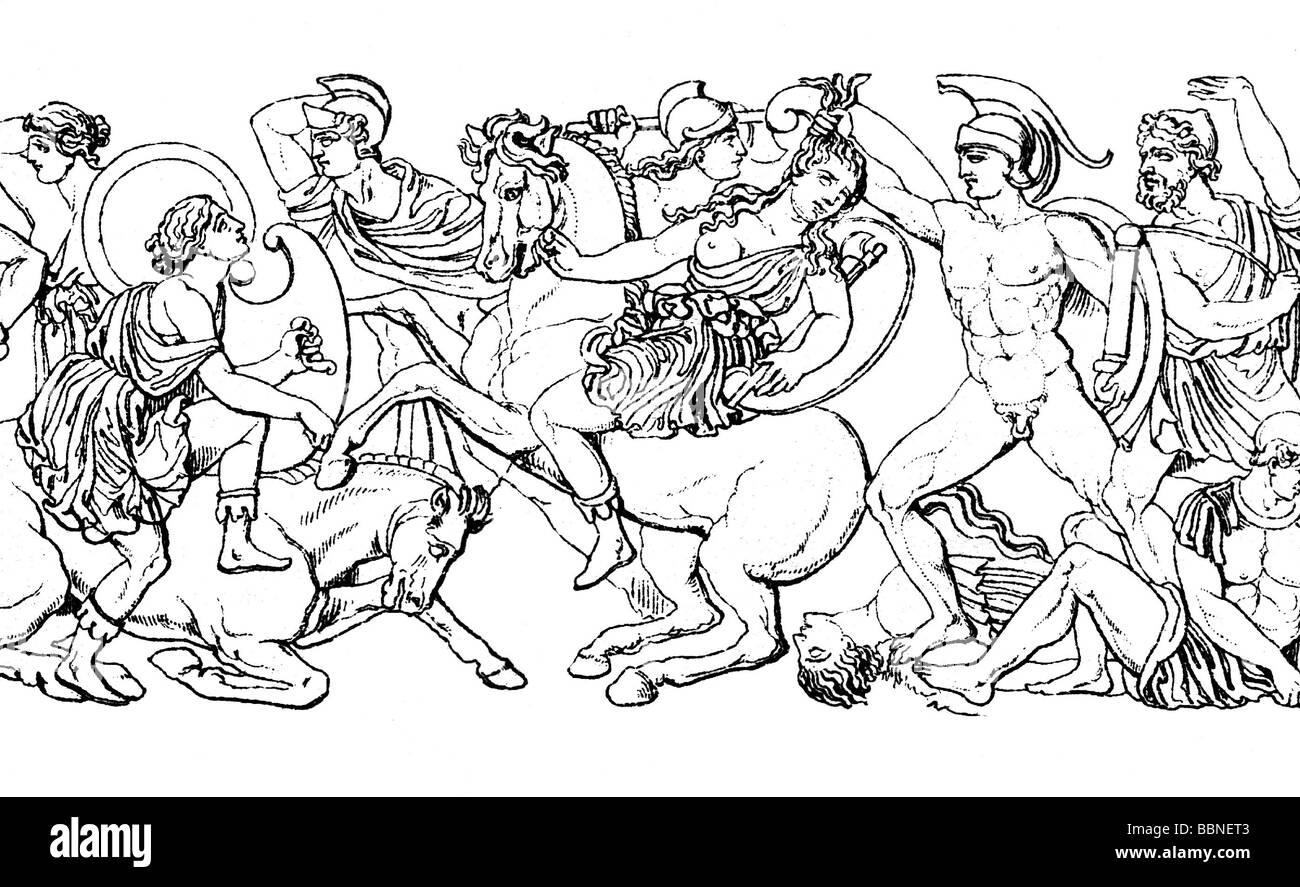 Amazons, Greek mythological figures, fight with Greek during siege of Troia, drawing after sarcophagus of Thessalonike, Stock Photohttps://www.alamy.com/image-license-details/?v=1https://www.alamy.com/stock-photo-amazons-greek-mythological-figures-fight-with-greek-during-siege-of-24444227.html
Amazons, Greek mythological figures, fight with Greek during siege of Troia, drawing after sarcophagus of Thessalonike, Stock Photohttps://www.alamy.com/image-license-details/?v=1https://www.alamy.com/stock-photo-amazons-greek-mythological-figures-fight-with-greek-during-siege-of-24444227.htmlRMBBNET3–Amazons, Greek mythological figures, fight with Greek during siege of Troia, drawing after sarcophagus of Thessalonike,
RFPDB89J–Ancient Greek Mythology Gods and Goddesses Characters Icon Set
 Baader-louis-marie-1828-1919-f-greek-mythological-figures-on. Stock Photohttps://www.alamy.com/image-license-details/?v=1https://www.alamy.com/baader-louis-marie-1828-1919-f-greek-mythological-figures-on-image217678606.html
Baader-louis-marie-1828-1919-f-greek-mythological-figures-on. Stock Photohttps://www.alamy.com/image-license-details/?v=1https://www.alamy.com/baader-louis-marie-1828-1919-f-greek-mythological-figures-on-image217678606.htmlRMPJ437X–Baader-louis-marie-1828-1919-f-greek-mythological-figures-on.
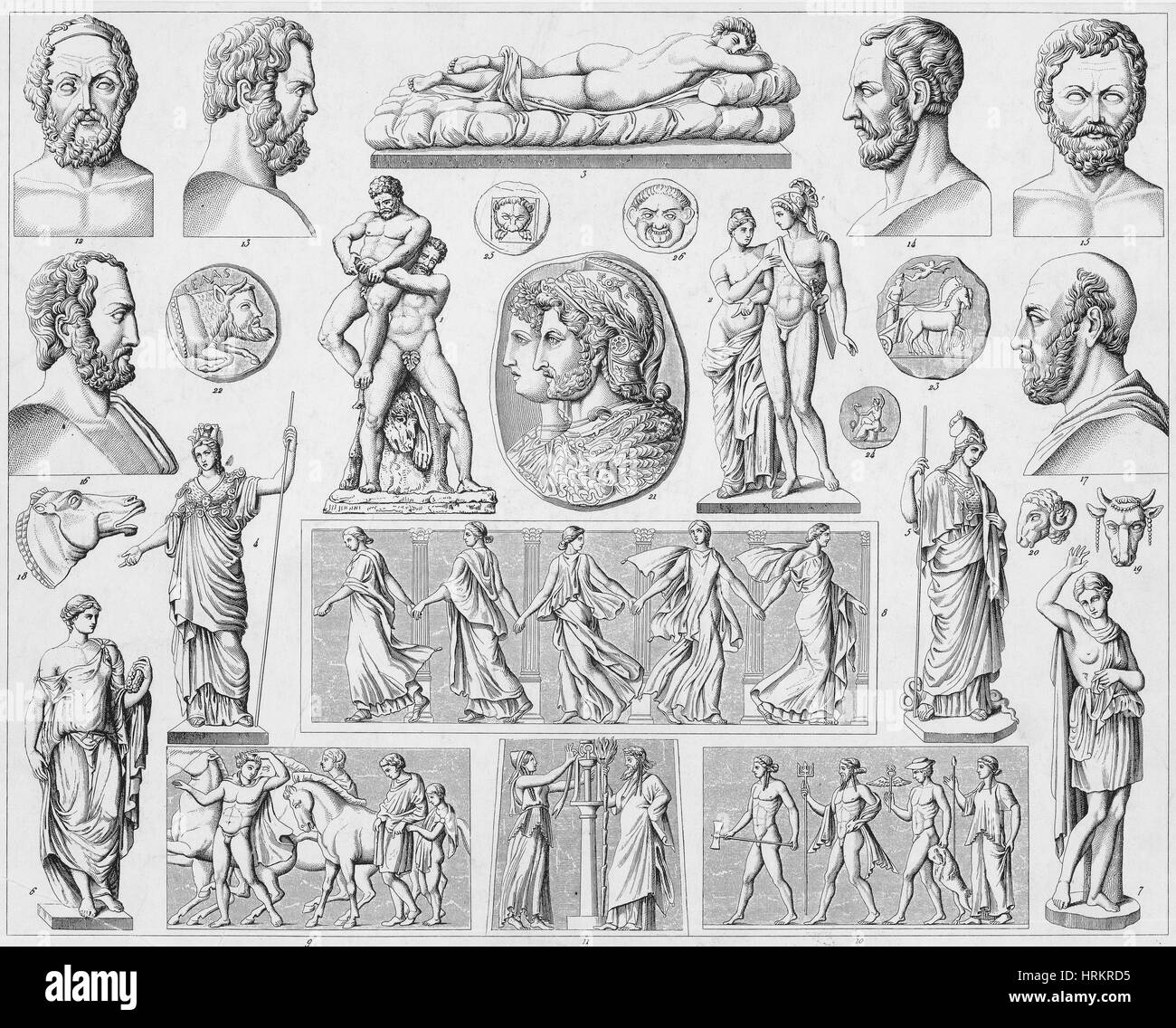 Greek and Roman Mythological Figures Stock Photohttps://www.alamy.com/image-license-details/?v=1https://www.alamy.com/stock-photo-greek-and-roman-mythological-figures-135045153.html
Greek and Roman Mythological Figures Stock Photohttps://www.alamy.com/image-license-details/?v=1https://www.alamy.com/stock-photo-greek-and-roman-mythological-figures-135045153.htmlRMHRKRD5–Greek and Roman Mythological Figures
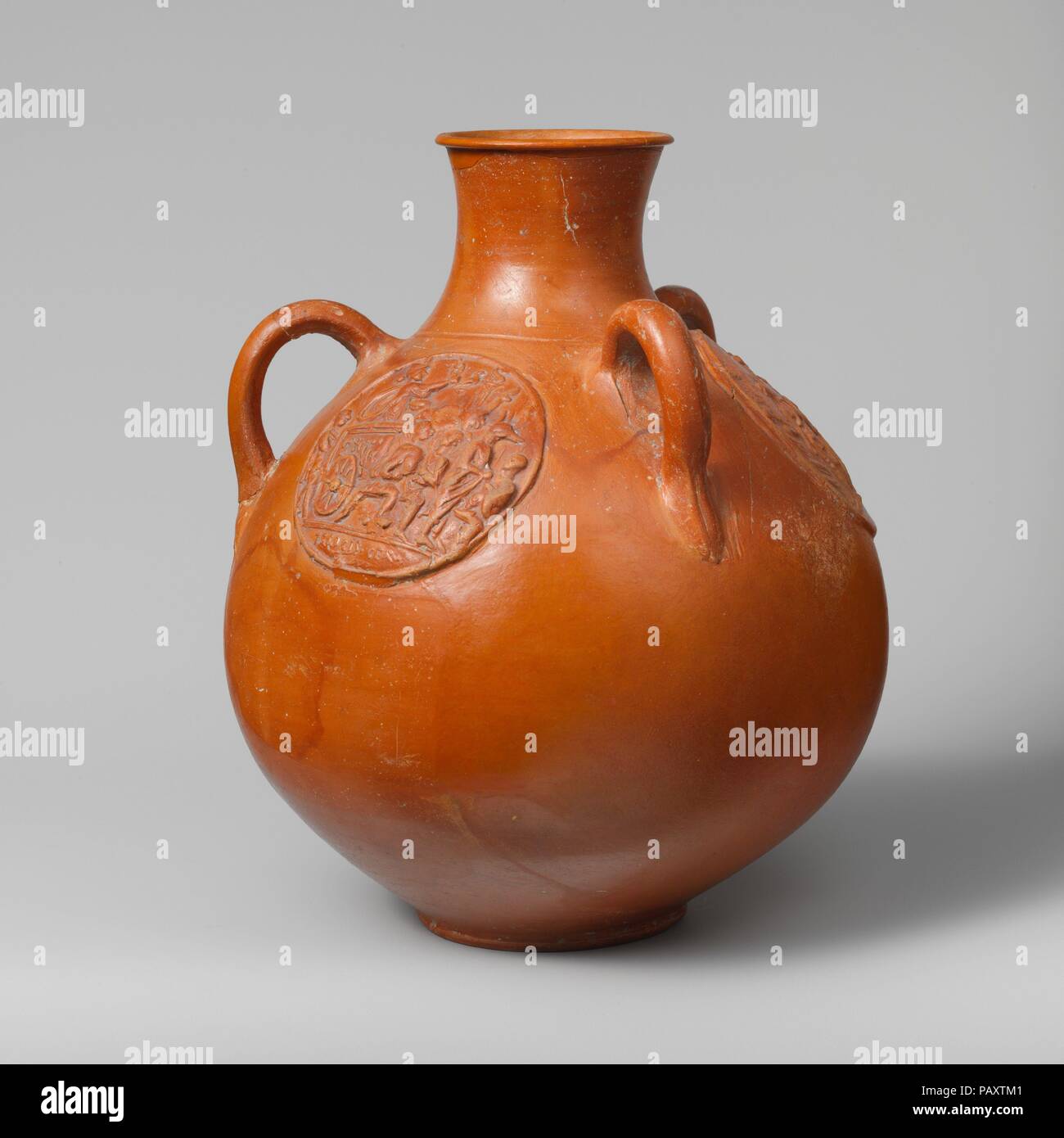 Three-handled jug with relief medallions. Culture: Roman. Dimensions: H. 8 9/16 in. (21.7 cm); diameter 7 1/4 in. (18.5 cm). Date: late 2nd-early 3rd century A.D.. This unusual three-handled jug is decorated with molded appliqué disks. Two are from the same mold and depict the Greek mythological figures Atalanta and Hippomenes. The third appliqué shows a religious procession with the cult statue of the Egyptian goddess Isis being paraded in a cart. The jug is said to have been found at Arausio (modern Orange, Southern France), but it was probably made in a workshop at either Lyon or Vienne i Stock Photohttps://www.alamy.com/image-license-details/?v=1https://www.alamy.com/three-handled-jug-with-relief-medallions-culture-roman-dimensions-h-8-916-in-217-cm-diameter-7-14-in-185-cm-date-late-2nd-early-3rd-century-ad-this-unusual-three-handled-jug-is-decorated-with-molded-appliqu-disks-two-are-from-the-same-mold-and-depict-the-greek-mythological-figures-atalanta-and-hippomenes-the-third-appliqu-shows-a-religious-procession-with-the-cult-statue-of-the-egyptian-goddess-isis-being-paraded-in-a-cart-the-jug-is-said-to-have-been-found-at-arausio-modern-orange-southern-france-but-it-was-probably-made-in-a-workshop-at-either-lyon-or-vienne-i-image213261105.html
Three-handled jug with relief medallions. Culture: Roman. Dimensions: H. 8 9/16 in. (21.7 cm); diameter 7 1/4 in. (18.5 cm). Date: late 2nd-early 3rd century A.D.. This unusual three-handled jug is decorated with molded appliqué disks. Two are from the same mold and depict the Greek mythological figures Atalanta and Hippomenes. The third appliqué shows a religious procession with the cult statue of the Egyptian goddess Isis being paraded in a cart. The jug is said to have been found at Arausio (modern Orange, Southern France), but it was probably made in a workshop at either Lyon or Vienne i Stock Photohttps://www.alamy.com/image-license-details/?v=1https://www.alamy.com/three-handled-jug-with-relief-medallions-culture-roman-dimensions-h-8-916-in-217-cm-diameter-7-14-in-185-cm-date-late-2nd-early-3rd-century-ad-this-unusual-three-handled-jug-is-decorated-with-molded-appliqu-disks-two-are-from-the-same-mold-and-depict-the-greek-mythological-figures-atalanta-and-hippomenes-the-third-appliqu-shows-a-religious-procession-with-the-cult-statue-of-the-egyptian-goddess-isis-being-paraded-in-a-cart-the-jug-is-said-to-have-been-found-at-arausio-modern-orange-southern-france-but-it-was-probably-made-in-a-workshop-at-either-lyon-or-vienne-i-image213261105.htmlRMPAXTM1–Three-handled jug with relief medallions. Culture: Roman. Dimensions: H. 8 9/16 in. (21.7 cm); diameter 7 1/4 in. (18.5 cm). Date: late 2nd-early 3rd century A.D.. This unusual three-handled jug is decorated with molded appliqué disks. Two are from the same mold and depict the Greek mythological figures Atalanta and Hippomenes. The third appliqué shows a religious procession with the cult statue of the Egyptian goddess Isis being paraded in a cart. The jug is said to have been found at Arausio (modern Orange, Southern France), but it was probably made in a workshop at either Lyon or Vienne i
 Baader louis marie 1828 1919 f greek mythological figures on Stock Photohttps://www.alamy.com/image-license-details/?v=1https://www.alamy.com/stock-photo-baader-louis-marie-1828-1919-f-greek-mythological-figures-on-132497458.html
Baader louis marie 1828 1919 f greek mythological figures on Stock Photohttps://www.alamy.com/image-license-details/?v=1https://www.alamy.com/stock-photo-baader-louis-marie-1828-1919-f-greek-mythological-figures-on-132497458.htmlRMHKFNT2–Baader louis marie 1828 1919 f greek mythological figures on
 Earring with mythological figures, Earring made of blue jasperware. The earring is decorated in white with greek female figures., anonymous, Stoke-on-Trent, c. 1770 - c. 1790, l 6.2 cm Stock Photohttps://www.alamy.com/image-license-details/?v=1https://www.alamy.com/earring-with-mythological-figures-earring-made-of-blue-jasperware-the-earring-is-decorated-in-white-with-greek-female-figures-anonymous-stoke-on-trent-c-1770-c-1790-l-62-cm-image261372121.html
Earring with mythological figures, Earring made of blue jasperware. The earring is decorated in white with greek female figures., anonymous, Stoke-on-Trent, c. 1770 - c. 1790, l 6.2 cm Stock Photohttps://www.alamy.com/image-license-details/?v=1https://www.alamy.com/earring-with-mythological-figures-earring-made-of-blue-jasperware-the-earring-is-decorated-in-white-with-greek-female-figures-anonymous-stoke-on-trent-c-1770-c-1790-l-62-cm-image261372121.htmlRMW56EPH–Earring with mythological figures, Earring made of blue jasperware. The earring is decorated in white with greek female figures., anonymous, Stoke-on-Trent, c. 1770 - c. 1790, l 6.2 cm
 Greek mythological figures on a boat near a pier 1853 by Louis-Marie Baader Stock Photohttps://www.alamy.com/image-license-details/?v=1https://www.alamy.com/greek-mythological-figures-on-a-boat-near-a-pier-1853-by-louis-marie-baader-image564926076.html
Greek mythological figures on a boat near a pier 1853 by Louis-Marie Baader Stock Photohttps://www.alamy.com/image-license-details/?v=1https://www.alamy.com/greek-mythological-figures-on-a-boat-near-a-pier-1853-by-louis-marie-baader-image564926076.htmlRM2RR2GY8–Greek mythological figures on a boat near a pier 1853 by Louis-Marie Baader
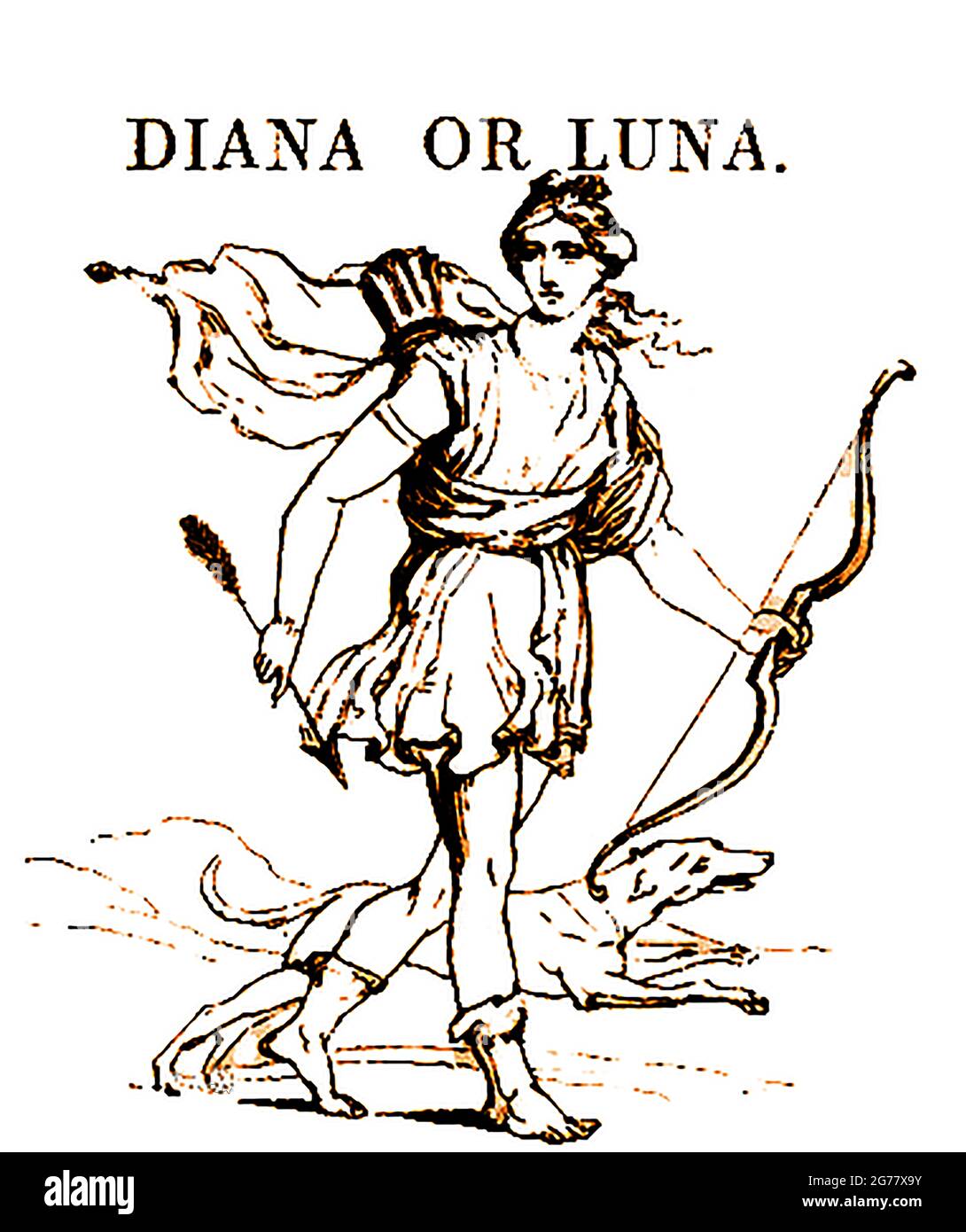 An 1839 depiction of the Greek & Roman mythological figure Diana (sometimes called the huntress goddess) who is still revered in revered in modern Roman neopaganism, Stregheria (the Old Religion), and Wicca. Equivalent or associated mythological figures to Diana include Artemis, Egeria the water nymph, Hecate, Virbius and the moon , (Luna and/or Selene). She is also associated with the countryside, childbirth, woodland areas, crossroads (especially 3-way crossroads), the way to the underworld, Stock Photohttps://www.alamy.com/image-license-details/?v=1https://www.alamy.com/an-1839-depiction-of-the-greek-roman-mythological-figure-diana-sometimes-called-the-huntress-goddess-who-is-still-revered-in-revered-in-modern-roman-neopaganism-stregheria-the-old-religion-and-wicca-equivalent-or-associated-mythological-figures-to-diana-include-artemis-egeria-the-water-nymph-hecate-virbius-and-the-moon-luna-andor-selene-she-is-also-associated-with-the-countryside-childbirth-woodland-areas-crossroads-especially-3-way-crossroads-the-way-to-the-underworld-image434736119.html
An 1839 depiction of the Greek & Roman mythological figure Diana (sometimes called the huntress goddess) who is still revered in revered in modern Roman neopaganism, Stregheria (the Old Religion), and Wicca. Equivalent or associated mythological figures to Diana include Artemis, Egeria the water nymph, Hecate, Virbius and the moon , (Luna and/or Selene). She is also associated with the countryside, childbirth, woodland areas, crossroads (especially 3-way crossroads), the way to the underworld, Stock Photohttps://www.alamy.com/image-license-details/?v=1https://www.alamy.com/an-1839-depiction-of-the-greek-roman-mythological-figure-diana-sometimes-called-the-huntress-goddess-who-is-still-revered-in-revered-in-modern-roman-neopaganism-stregheria-the-old-religion-and-wicca-equivalent-or-associated-mythological-figures-to-diana-include-artemis-egeria-the-water-nymph-hecate-virbius-and-the-moon-luna-andor-selene-she-is-also-associated-with-the-countryside-childbirth-woodland-areas-crossroads-especially-3-way-crossroads-the-way-to-the-underworld-image434736119.htmlRM2G77X9Y–An 1839 depiction of the Greek & Roman mythological figure Diana (sometimes called the huntress goddess) who is still revered in revered in modern Roman neopaganism, Stregheria (the Old Religion), and Wicca. Equivalent or associated mythological figures to Diana include Artemis, Egeria the water nymph, Hecate, Virbius and the moon , (Luna and/or Selene). She is also associated with the countryside, childbirth, woodland areas, crossroads (especially 3-way crossroads), the way to the underworld,
 Ariadne ariadne, Dionysus, Satyr, Antique vase with Greek mythological figures in black and red, Interiors, Archaeological Museum, Old Town, Rhodes Stock Photohttps://www.alamy.com/image-license-details/?v=1https://www.alamy.com/ariadne-ariadne-dionysus-satyr-antique-vase-with-greek-mythological-figures-in-black-and-red-interiors-archaeological-museum-old-town-rhodes-image606876027.html
Ariadne ariadne, Dionysus, Satyr, Antique vase with Greek mythological figures in black and red, Interiors, Archaeological Museum, Old Town, Rhodes Stock Photohttps://www.alamy.com/image-license-details/?v=1https://www.alamy.com/ariadne-ariadne-dionysus-satyr-antique-vase-with-greek-mythological-figures-in-black-and-red-interiors-archaeological-museum-old-town-rhodes-image606876027.htmlRM2X79GFR–Ariadne ariadne, Dionysus, Satyr, Antique vase with Greek mythological figures in black and red, Interiors, Archaeological Museum, Old Town, Rhodes
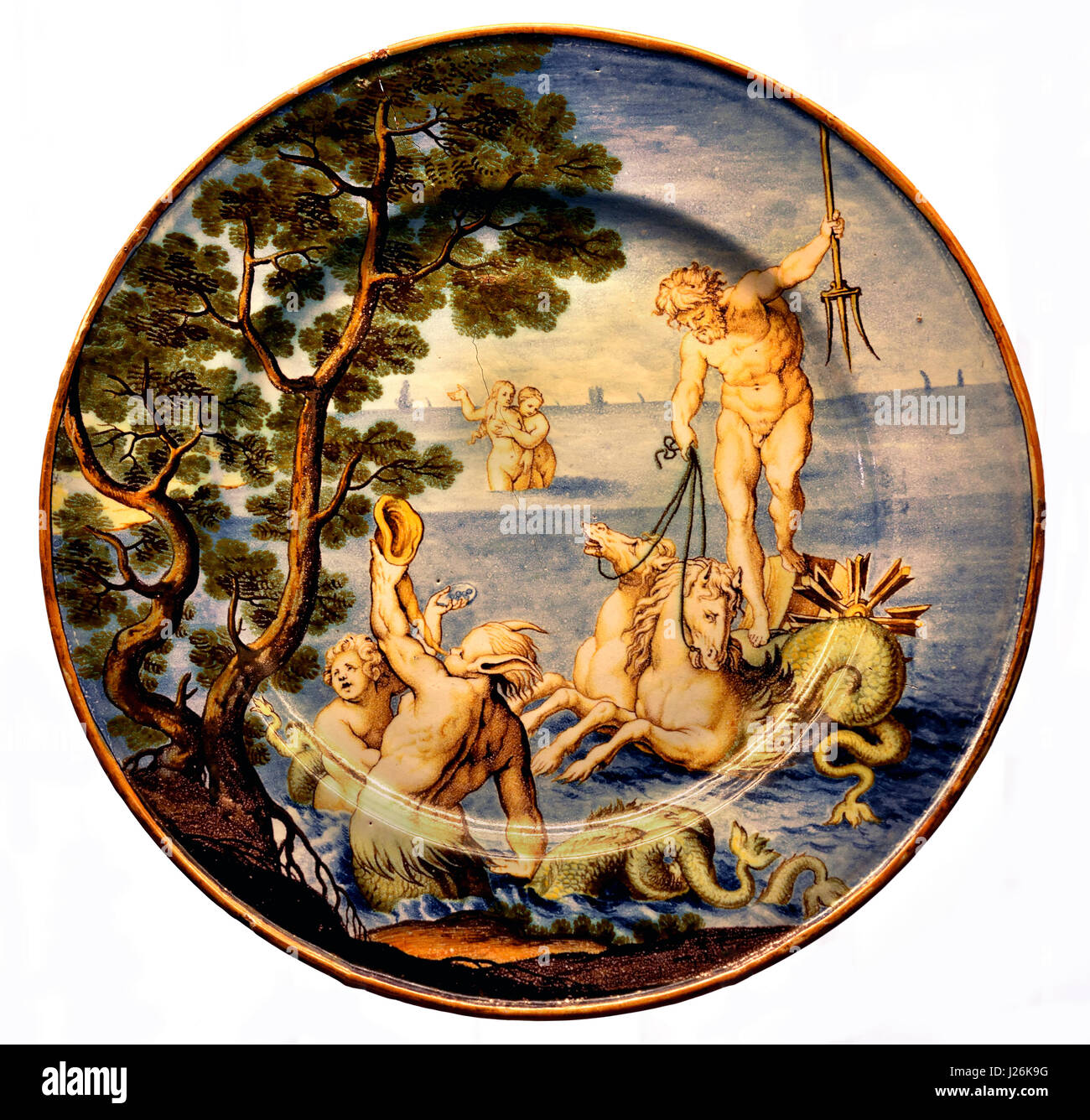 Sea God Neptune - Plate with Mythological Figures 1740 by Ferdinando Maria Campani Italy Italian. Stock Photohttps://www.alamy.com/image-license-details/?v=1https://www.alamy.com/stock-photo-sea-god-neptune-plate-with-mythological-figures-1740-by-ferdinando-139059132.html
Sea God Neptune - Plate with Mythological Figures 1740 by Ferdinando Maria Campani Italy Italian. Stock Photohttps://www.alamy.com/image-license-details/?v=1https://www.alamy.com/stock-photo-sea-god-neptune-plate-with-mythological-figures-1740-by-ferdinando-139059132.htmlRMJ26K9G–Sea God Neptune - Plate with Mythological Figures 1740 by Ferdinando Maria Campani Italy Italian.
 Fragment of a gable of a Greek temple with mythological figures, Dionysus and Oinopion, 510 B.C., Archaeological Museum, Corfu City, Corfu Island Stock Photohttps://www.alamy.com/image-license-details/?v=1https://www.alamy.com/fragment-of-a-gable-of-a-greek-temple-with-mythological-figures-dionysus-and-oinopion-510-bc-archaeological-museum-corfu-city-corfu-island-image261021681.html
Fragment of a gable of a Greek temple with mythological figures, Dionysus and Oinopion, 510 B.C., Archaeological Museum, Corfu City, Corfu Island Stock Photohttps://www.alamy.com/image-license-details/?v=1https://www.alamy.com/fragment-of-a-gable-of-a-greek-temple-with-mythological-figures-dionysus-and-oinopion-510-bc-archaeological-museum-corfu-city-corfu-island-image261021681.htmlRMW4JFPW–Fragment of a gable of a Greek temple with mythological figures, Dionysus and Oinopion, 510 B.C., Archaeological Museum, Corfu City, Corfu Island
 Three-handled jug with relief medallions late 2nd–early 3rd century A.D. Roman This unusual three-handled jug is decorated with molded appliqué disks. Two are from the same mold and depict the Greek mythological figures Atalanta and Hippomenes. The third appliqué shows a religious procession with the cult statue of the Egyptian goddess Isis being paraded in a cart. The jug is said to have been found at Arausio (modern Orange, Southern France), but it was probably made in a workshop at either Lyon or Vienne in the upper Rhône Valley.. Three-handled jug with relief medallions. Roman. late 2nd–ea Stock Photohttps://www.alamy.com/image-license-details/?v=1https://www.alamy.com/three-handled-jug-with-relief-medallions-late-2ndearly-3rd-century-ad-roman-this-unusual-three-handled-jug-is-decorated-with-molded-appliqu-disks-two-are-from-the-same-mold-and-depict-the-greek-mythological-figures-atalanta-and-hippomenes-the-third-appliqu-shows-a-religious-procession-with-the-cult-statue-of-the-egyptian-goddess-isis-being-paraded-in-a-cart-the-jug-is-said-to-have-been-found-at-arausio-modern-orange-southern-france-but-it-was-probably-made-in-a-workshop-at-either-lyon-or-vienne-in-the-upper-rhne-valley-three-handled-jug-with-relief-medallions-roman-late-2ndea-image458639238.html
Three-handled jug with relief medallions late 2nd–early 3rd century A.D. Roman This unusual three-handled jug is decorated with molded appliqué disks. Two are from the same mold and depict the Greek mythological figures Atalanta and Hippomenes. The third appliqué shows a religious procession with the cult statue of the Egyptian goddess Isis being paraded in a cart. The jug is said to have been found at Arausio (modern Orange, Southern France), but it was probably made in a workshop at either Lyon or Vienne in the upper Rhône Valley.. Three-handled jug with relief medallions. Roman. late 2nd–ea Stock Photohttps://www.alamy.com/image-license-details/?v=1https://www.alamy.com/three-handled-jug-with-relief-medallions-late-2ndearly-3rd-century-ad-roman-this-unusual-three-handled-jug-is-decorated-with-molded-appliqu-disks-two-are-from-the-same-mold-and-depict-the-greek-mythological-figures-atalanta-and-hippomenes-the-third-appliqu-shows-a-religious-procession-with-the-cult-statue-of-the-egyptian-goddess-isis-being-paraded-in-a-cart-the-jug-is-said-to-have-been-found-at-arausio-modern-orange-southern-france-but-it-was-probably-made-in-a-workshop-at-either-lyon-or-vienne-in-the-upper-rhne-valley-three-handled-jug-with-relief-medallions-roman-late-2ndea-image458639238.htmlRM2HJ4R0P–Three-handled jug with relief medallions late 2nd–early 3rd century A.D. Roman This unusual three-handled jug is decorated with molded appliqué disks. Two are from the same mold and depict the Greek mythological figures Atalanta and Hippomenes. The third appliqué shows a religious procession with the cult statue of the Egyptian goddess Isis being paraded in a cart. The jug is said to have been found at Arausio (modern Orange, Southern France), but it was probably made in a workshop at either Lyon or Vienne in the upper Rhône Valley.. Three-handled jug with relief medallions. Roman. late 2nd–ea
 Archibald Memorial Fountain in Sydney's Hyde Park. Sculpted in Art Deco style with Greek mythological figures depicting war and peace. Stock Photohttps://www.alamy.com/image-license-details/?v=1https://www.alamy.com/archibald-memorial-fountain-in-sydneys-hyde-park-sculpted-in-art-deco-style-with-greek-mythological-figures-depicting-war-and-peace-image586311048.html
Archibald Memorial Fountain in Sydney's Hyde Park. Sculpted in Art Deco style with Greek mythological figures depicting war and peace. Stock Photohttps://www.alamy.com/image-license-details/?v=1https://www.alamy.com/archibald-memorial-fountain-in-sydneys-hyde-park-sculpted-in-art-deco-style-with-greek-mythological-figures-depicting-war-and-peace-image586311048.htmlRF2W1TNM8–Archibald Memorial Fountain in Sydney's Hyde Park. Sculpted in Art Deco style with Greek mythological figures depicting war and peace.
 Achilles and Ajax playing dice on a mid 5th century Greek vase by Exekias (Half-tone postcard image.) Stock Photohttps://www.alamy.com/image-license-details/?v=1https://www.alamy.com/achilles-and-ajax-playing-dice-on-a-mid-5th-century-greek-vase-by-exekias-half-tone-postcard-image-image568543488.html
Achilles and Ajax playing dice on a mid 5th century Greek vase by Exekias (Half-tone postcard image.) Stock Photohttps://www.alamy.com/image-license-details/?v=1https://www.alamy.com/achilles-and-ajax-playing-dice-on-a-mid-5th-century-greek-vase-by-exekias-half-tone-postcard-image-image568543488.htmlRM2T0YB0G–Achilles and Ajax playing dice on a mid 5th century Greek vase by Exekias (Half-tone postcard image.)
 An ancient representation of the Greek deity Meda or Mede , a name confused in history between the wife of King Idomeneus. and other mythological figures such as daughter of Phylas and mother of Antiochus by Heracles; and Iphthime,(her other name) daughter of Icarius of Sparta and Asterodia. She is sometimes depicted without a distinct face or even as a ghost. Μια αρχαία αναπαράσταση της ελληνικής θεότητας Μήδα ή Μήδη, ένα όνομα που συγχέεται στην ιστορία μεταξύ της συζύγου του βασιλιά Ιδομενέα. και άλλες μυθολογικές μορφές Stock Photohttps://www.alamy.com/image-license-details/?v=1https://www.alamy.com/an-ancient-representation-of-the-greek-deity-meda-or-mede-a-name-confused-in-history-between-the-wife-of-king-idomeneus-and-other-mythological-figures-such-as-daughter-of-phylas-and-mother-of-antiochus-by-heracles-and-iphthimeher-other-name-daughter-of-icarius-of-sparta-and-asterodia-she-is-sometimes-depicted-without-a-distinct-face-or-even-as-a-ghost-image631171192.html
An ancient representation of the Greek deity Meda or Mede , a name confused in history between the wife of King Idomeneus. and other mythological figures such as daughter of Phylas and mother of Antiochus by Heracles; and Iphthime,(her other name) daughter of Icarius of Sparta and Asterodia. She is sometimes depicted without a distinct face or even as a ghost. Μια αρχαία αναπαράσταση της ελληνικής θεότητας Μήδα ή Μήδη, ένα όνομα που συγχέεται στην ιστορία μεταξύ της συζύγου του βασιλιά Ιδομενέα. και άλλες μυθολογικές μορφές Stock Photohttps://www.alamy.com/image-license-details/?v=1https://www.alamy.com/an-ancient-representation-of-the-greek-deity-meda-or-mede-a-name-confused-in-history-between-the-wife-of-king-idomeneus-and-other-mythological-figures-such-as-daughter-of-phylas-and-mother-of-antiochus-by-heracles-and-iphthimeher-other-name-daughter-of-icarius-of-sparta-and-asterodia-she-is-sometimes-depicted-without-a-distinct-face-or-even-as-a-ghost-image631171192.htmlRM2YJT988–An ancient representation of the Greek deity Meda or Mede , a name confused in history between the wife of King Idomeneus. and other mythological figures such as daughter of Phylas and mother of Antiochus by Heracles; and Iphthime,(her other name) daughter of Icarius of Sparta and Asterodia. She is sometimes depicted without a distinct face or even as a ghost. Μια αρχαία αναπαράσταση της ελληνικής θεότητας Μήδα ή Μήδη, ένα όνομα που συγχέεται στην ιστορία μεταξύ της συζύγου του βασιλιά Ιδομενέα. και άλλες μυθολογικές μορφές
 Neo-Attic relief depicting an episode from the Greek myth of Telephus also showing Achilles. House of the Telephus relief, ancient city of Herculaneum Stock Photohttps://www.alamy.com/image-license-details/?v=1https://www.alamy.com/neo-attic-relief-depicting-an-episode-from-the-greek-myth-of-telephus-also-showing-achilles-house-of-the-telephus-relief-ancient-city-of-herculaneum-image362168123.html
Neo-Attic relief depicting an episode from the Greek myth of Telephus also showing Achilles. House of the Telephus relief, ancient city of Herculaneum Stock Photohttps://www.alamy.com/image-license-details/?v=1https://www.alamy.com/neo-attic-relief-depicting-an-episode-from-the-greek-myth-of-telephus-also-showing-achilles-house-of-the-telephus-relief-ancient-city-of-herculaneum-image362168123.htmlRM2C1653R–Neo-Attic relief depicting an episode from the Greek myth of Telephus also showing Achilles. House of the Telephus relief, ancient city of Herculaneum
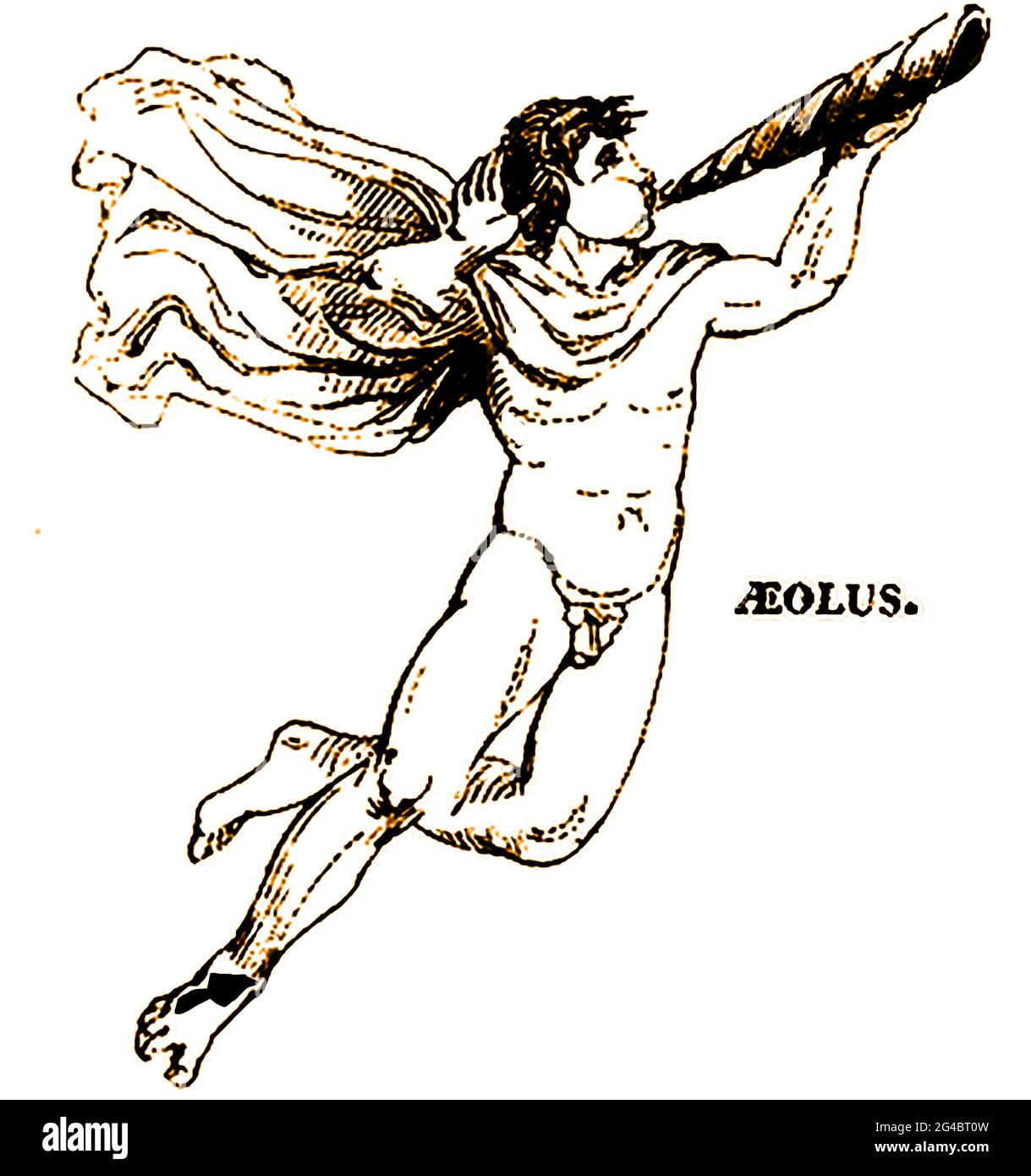 An 1839 depiction of Aeolus (aka Aíolos & Αἴολος) a Greek nymph, mythological figure or half-human god whose name means speedy, quick-moving or nimble'. There are confusingly three deeply entwined figures with this name all which appear to be genealogically connected. One was the son of Hellen the founder of the Aeolian race, another was a son of Poseidon, who led a colony to islands in the Tyrrhenian Sea, and the third was a son of Hippotes and as the 'Keeper of the Winds. In in Homer's Odyssey Aeolus gave Odysseus a closed bag that contained the winds of all directions Stock Photohttps://www.alamy.com/image-license-details/?v=1https://www.alamy.com/an-1839-depiction-of-aeolus-aka-aolos-a-greek-nymph-mythological-figure-or-half-human-god-whose-name-means-speedy-quick-moving-or-nimble-there-are-confusingly-three-deeply-entwined-figures-with-this-name-all-which-appear-to-be-genealogically-connected-one-was-the-son-of-hellen-the-founder-of-the-aeolian-race-another-was-a-son-of-poseidon-who-led-a-colony-to-islands-in-the-tyrrhenian-sea-and-the-third-was-a-son-of-hippotes-and-as-the-keeper-of-the-winds-in-in-homers-odyssey-aeolus-gave-odysseus-a-closed-bag-that-contained-the-winds-of-all-directions-image432978137.html
An 1839 depiction of Aeolus (aka Aíolos & Αἴολος) a Greek nymph, mythological figure or half-human god whose name means speedy, quick-moving or nimble'. There are confusingly three deeply entwined figures with this name all which appear to be genealogically connected. One was the son of Hellen the founder of the Aeolian race, another was a son of Poseidon, who led a colony to islands in the Tyrrhenian Sea, and the third was a son of Hippotes and as the 'Keeper of the Winds. In in Homer's Odyssey Aeolus gave Odysseus a closed bag that contained the winds of all directions Stock Photohttps://www.alamy.com/image-license-details/?v=1https://www.alamy.com/an-1839-depiction-of-aeolus-aka-aolos-a-greek-nymph-mythological-figure-or-half-human-god-whose-name-means-speedy-quick-moving-or-nimble-there-are-confusingly-three-deeply-entwined-figures-with-this-name-all-which-appear-to-be-genealogically-connected-one-was-the-son-of-hellen-the-founder-of-the-aeolian-race-another-was-a-son-of-poseidon-who-led-a-colony-to-islands-in-the-tyrrhenian-sea-and-the-third-was-a-son-of-hippotes-and-as-the-keeper-of-the-winds-in-in-homers-odyssey-aeolus-gave-odysseus-a-closed-bag-that-contained-the-winds-of-all-directions-image432978137.htmlRM2G4BT0W–An 1839 depiction of Aeolus (aka Aíolos & Αἴολος) a Greek nymph, mythological figure or half-human god whose name means speedy, quick-moving or nimble'. There are confusingly three deeply entwined figures with this name all which appear to be genealogically connected. One was the son of Hellen the founder of the Aeolian race, another was a son of Poseidon, who led a colony to islands in the Tyrrhenian Sea, and the third was a son of Hippotes and as the 'Keeper of the Winds. In in Homer's Odyssey Aeolus gave Odysseus a closed bag that contained the winds of all directions
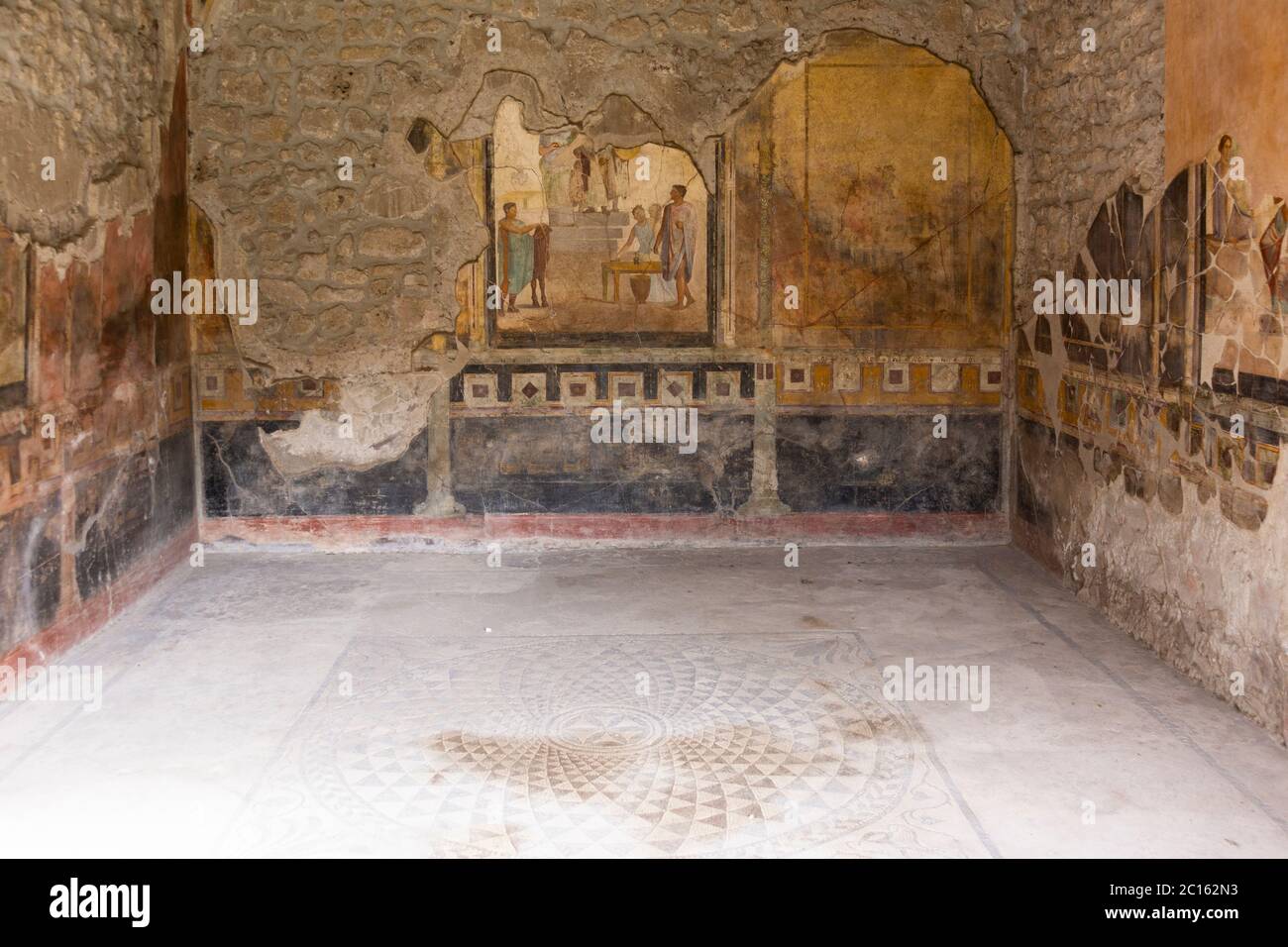 Mythological frescoes from Greek myth in the atrium room of the House of the Tragic Poet in the ancient city of Pompeii, Campania, Italy Stock Photohttps://www.alamy.com/image-license-details/?v=1https://www.alamy.com/mythological-frescoes-from-greek-myth-in-the-atrium-room-of-the-house-of-the-tragic-poet-in-the-ancient-city-of-pompeii-campania-italy-image362166255.html
Mythological frescoes from Greek myth in the atrium room of the House of the Tragic Poet in the ancient city of Pompeii, Campania, Italy Stock Photohttps://www.alamy.com/image-license-details/?v=1https://www.alamy.com/mythological-frescoes-from-greek-myth-in-the-atrium-room-of-the-house-of-the-tragic-poet-in-the-ancient-city-of-pompeii-campania-italy-image362166255.htmlRM2C162N3–Mythological frescoes from Greek myth in the atrium room of the House of the Tragic Poet in the ancient city of Pompeii, Campania, Italy
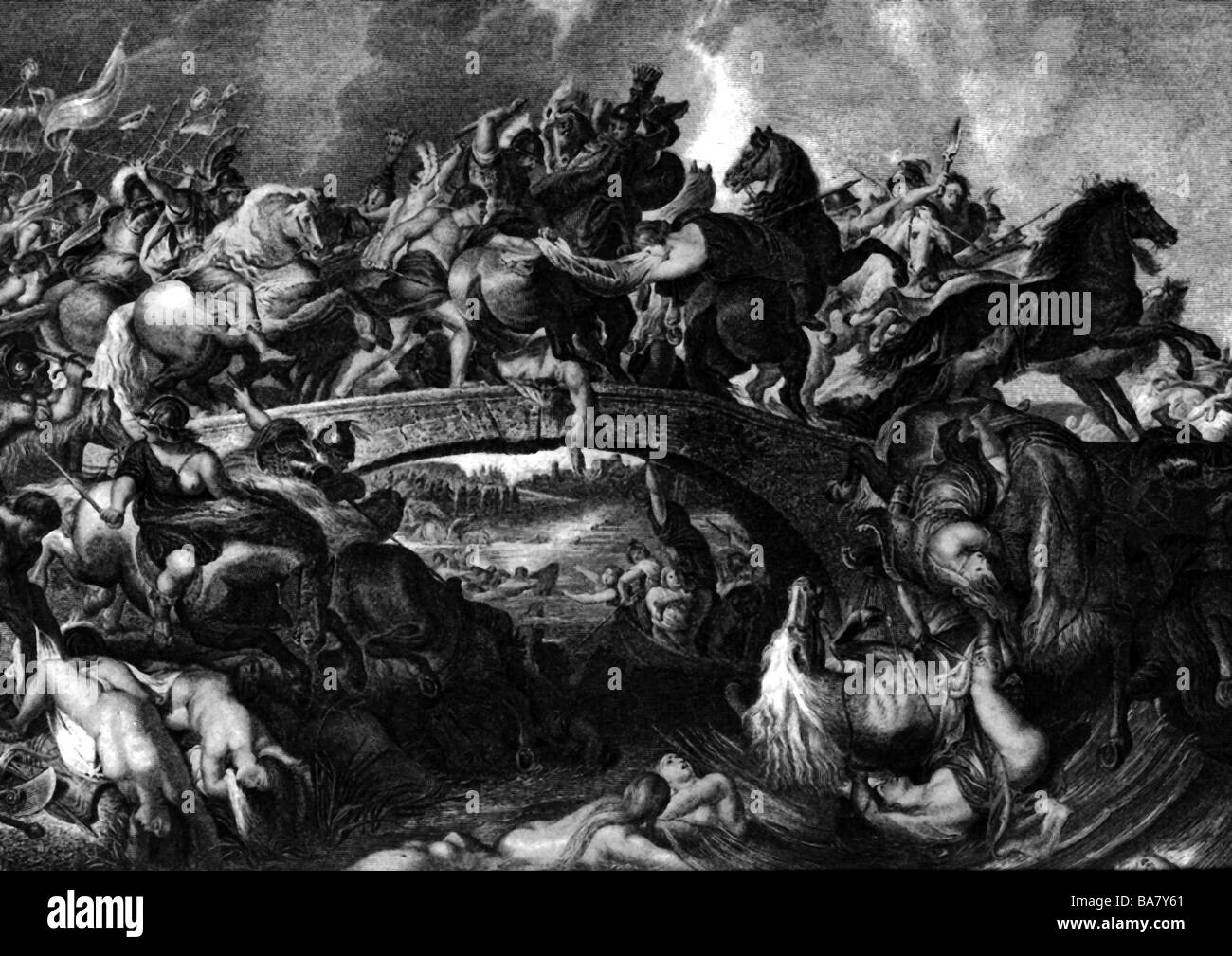 Amazons, Greek mythological figures, Amazon battle, wood engraving, 19th century, after painting by Peter Paul Rubens, Stock Photohttps://www.alamy.com/image-license-details/?v=1https://www.alamy.com/stock-photo-amazons-greek-mythological-figures-amazon-battle-wood-engraving-19th-23531929.html
Amazons, Greek mythological figures, Amazon battle, wood engraving, 19th century, after painting by Peter Paul Rubens, Stock Photohttps://www.alamy.com/image-license-details/?v=1https://www.alamy.com/stock-photo-amazons-greek-mythological-figures-amazon-battle-wood-engraving-19th-23531929.htmlRMBA7Y61–Amazons, Greek mythological figures, Amazon battle, wood engraving, 19th century, after painting by Peter Paul Rubens,
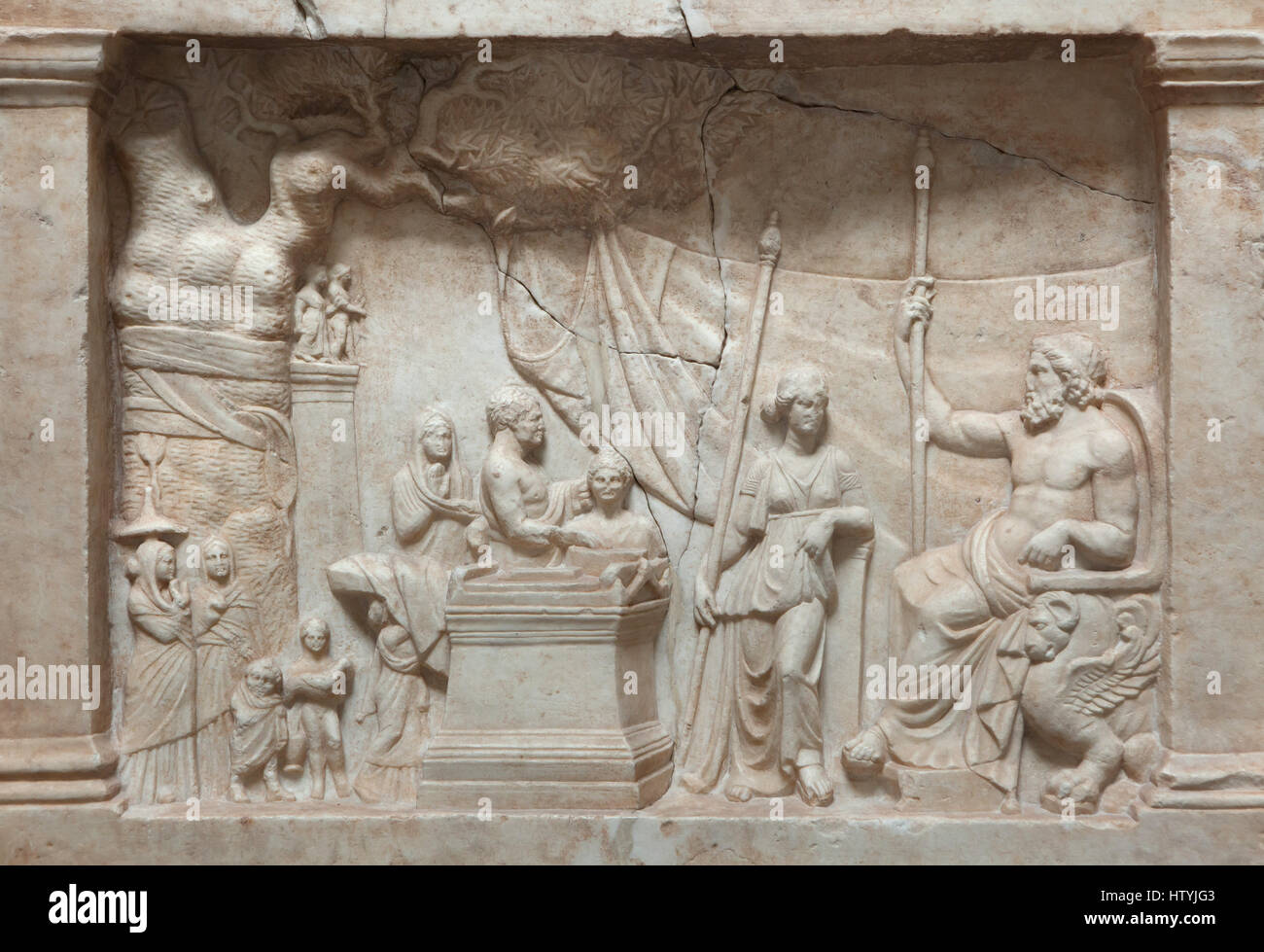 Munich Votive Relief. Greek votive relief from about 220 BC on display in the Glyptothek Museum in Munich, Bavaria, Germany. In a rural sanctuary a sacrificing family approach Asclepius, the god of healing, seated on a throne and his daughter Hygieia. In the middle there is an altar, to the left a sacred plane tree and in the background a pillar with two small figures of gods. Stock Photohttps://www.alamy.com/image-license-details/?v=1https://www.alamy.com/stock-photo-munich-votive-relief-greek-votive-relief-from-about-220-bc-on-display-135831587.html
Munich Votive Relief. Greek votive relief from about 220 BC on display in the Glyptothek Museum in Munich, Bavaria, Germany. In a rural sanctuary a sacrificing family approach Asclepius, the god of healing, seated on a throne and his daughter Hygieia. In the middle there is an altar, to the left a sacred plane tree and in the background a pillar with two small figures of gods. Stock Photohttps://www.alamy.com/image-license-details/?v=1https://www.alamy.com/stock-photo-munich-votive-relief-greek-votive-relief-from-about-220-bc-on-display-135831587.htmlRMHTYJG3–Munich Votive Relief. Greek votive relief from about 220 BC on display in the Glyptothek Museum in Munich, Bavaria, Germany. In a rural sanctuary a sacrificing family approach Asclepius, the god of healing, seated on a throne and his daughter Hygieia. In the middle there is an altar, to the left a sacred plane tree and in the background a pillar with two small figures of gods.
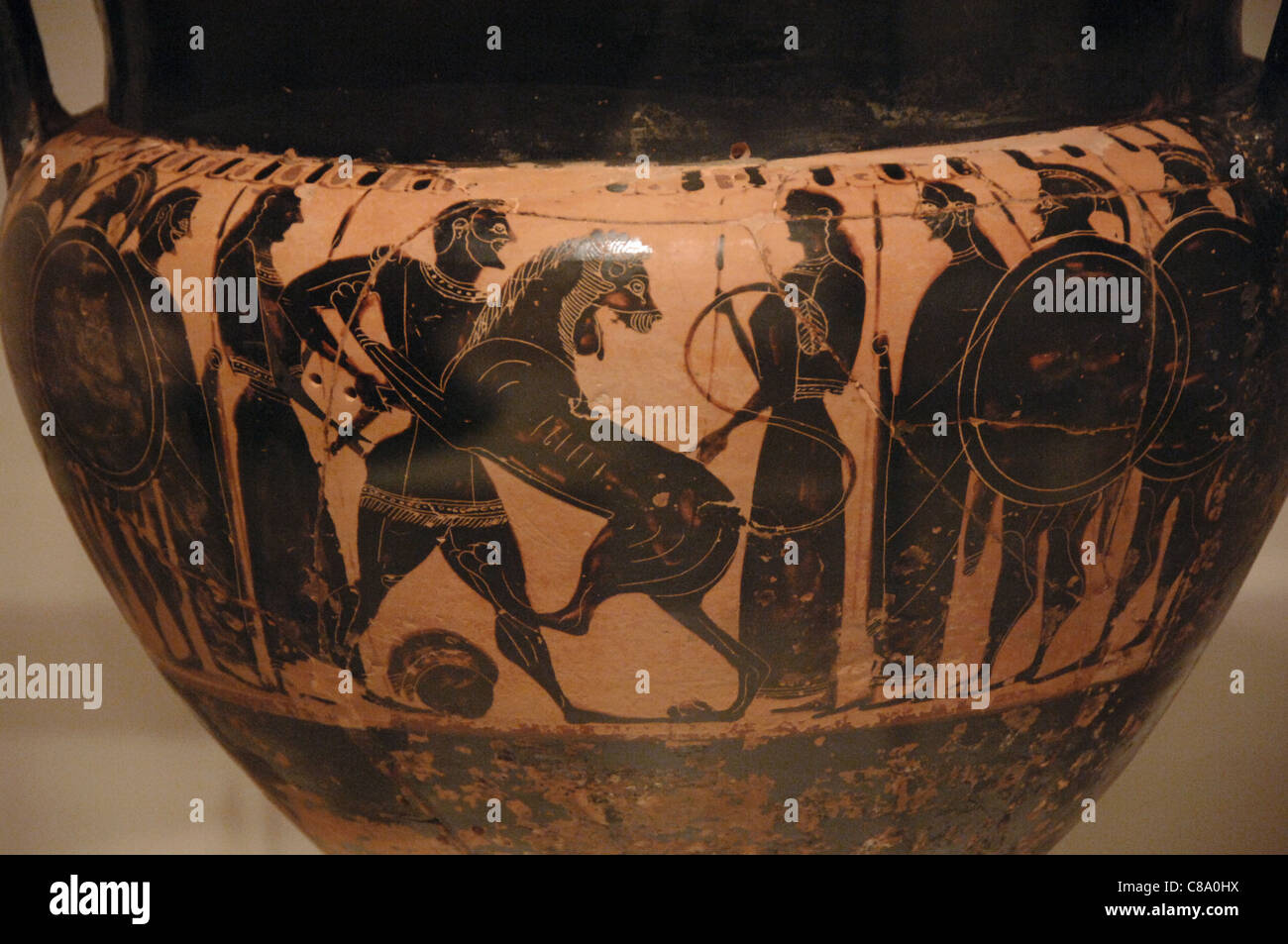 First job of Hercules: kill the Nemean lion and take their skin. 550-540 B.C. National Archaeological Museum. Athens. Greece. Stock Photohttps://www.alamy.com/image-license-details/?v=1https://www.alamy.com/stock-photo-first-job-of-hercules-kill-the-nemean-lion-and-take-their-skin-550-39558006.html
First job of Hercules: kill the Nemean lion and take their skin. 550-540 B.C. National Archaeological Museum. Athens. Greece. Stock Photohttps://www.alamy.com/image-license-details/?v=1https://www.alamy.com/stock-photo-first-job-of-hercules-kill-the-nemean-lion-and-take-their-skin-550-39558006.htmlRMC8A0HX–First job of Hercules: kill the Nemean lion and take their skin. 550-540 B.C. National Archaeological Museum. Athens. Greece.
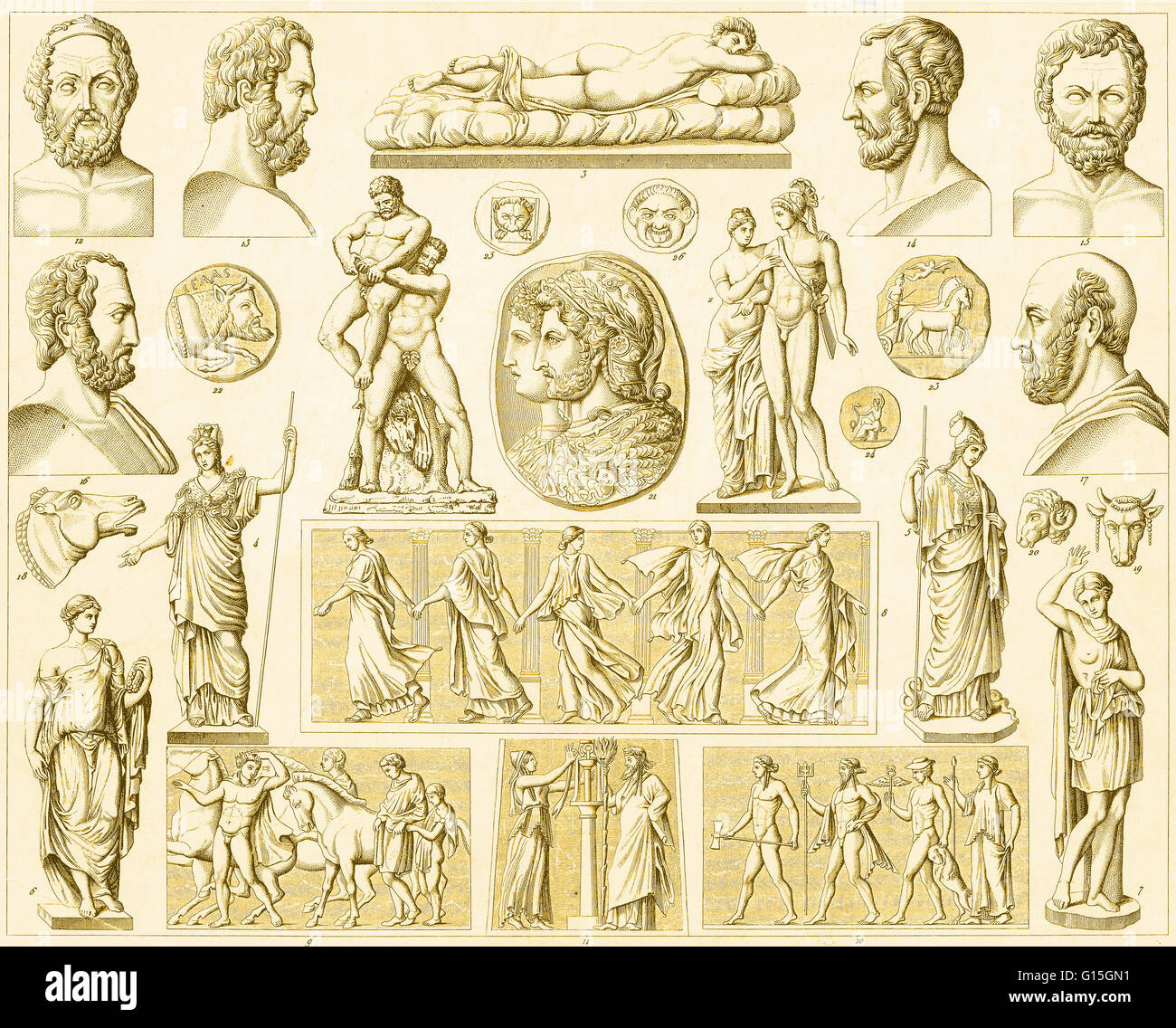 Figures from Greek and Roman mythology. Stock Photohttps://www.alamy.com/image-license-details/?v=1https://www.alamy.com/stock-photo-figures-from-greek-and-roman-mythology-103999757.html
Figures from Greek and Roman mythology. Stock Photohttps://www.alamy.com/image-license-details/?v=1https://www.alamy.com/stock-photo-figures-from-greek-and-roman-mythology-103999757.htmlRMG15GN1–Figures from Greek and Roman mythology.
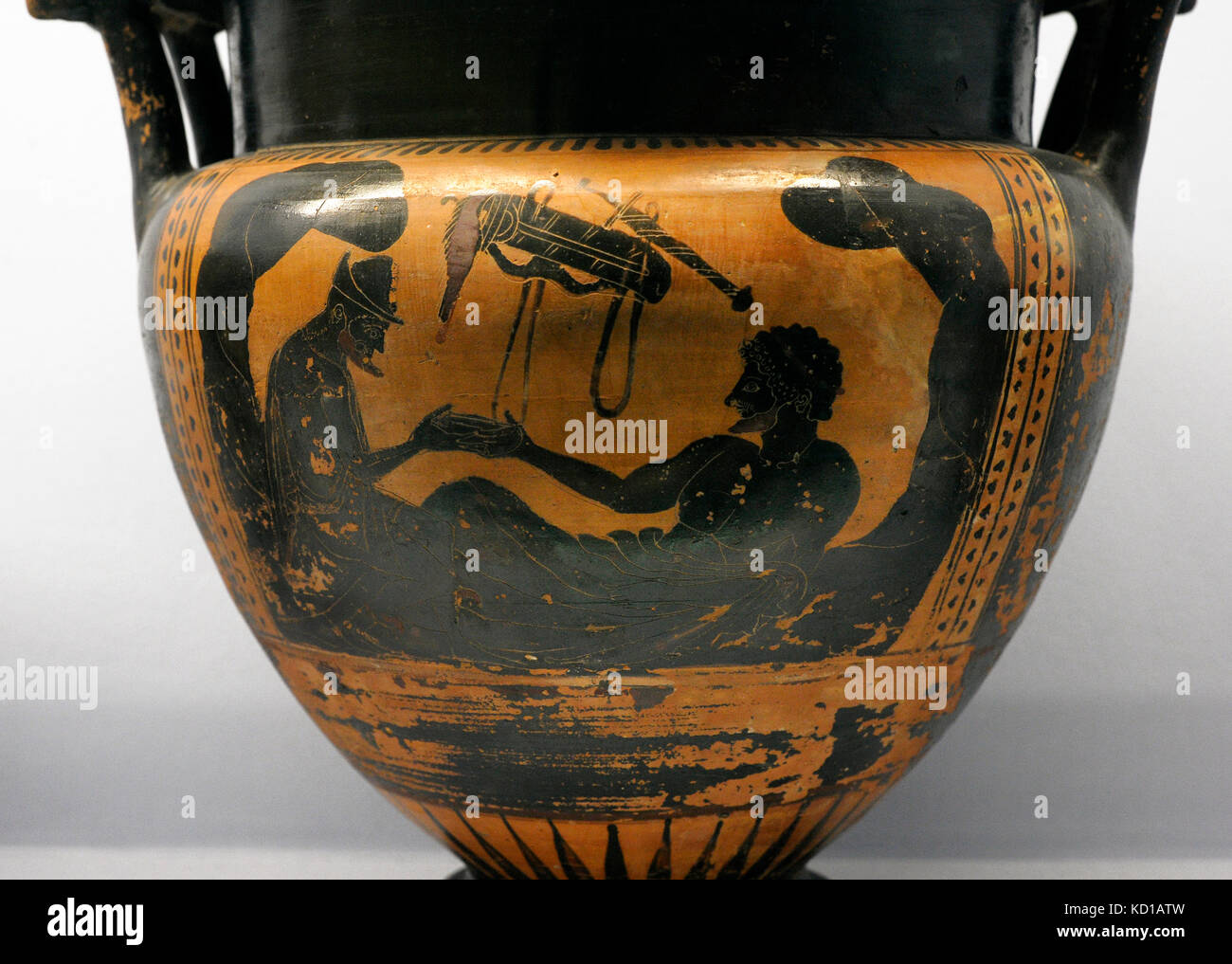 Greek krater depicting the hero Hercules and the God Hermes at a banquet in a cave. 510-500 BC. Made in Athens by the Rycroft's painter. Ceramics. Black figures. National Archaeological Museum. Naples. Italy. Stock Photohttps://www.alamy.com/image-license-details/?v=1https://www.alamy.com/stock-image-greek-krater-depicting-the-hero-hercules-and-the-god-hermes-at-a-banquet-162914329.html
Greek krater depicting the hero Hercules and the God Hermes at a banquet in a cave. 510-500 BC. Made in Athens by the Rycroft's painter. Ceramics. Black figures. National Archaeological Museum. Naples. Italy. Stock Photohttps://www.alamy.com/image-license-details/?v=1https://www.alamy.com/stock-image-greek-krater-depicting-the-hero-hercules-and-the-god-hermes-at-a-banquet-162914329.htmlRMKD1ATW–Greek krater depicting the hero Hercules and the God Hermes at a banquet in a cave. 510-500 BC. Made in Athens by the Rycroft's painter. Ceramics. Black figures. National Archaeological Museum. Naples. Italy.
 Orpheus', 1865. Artist: Gustave Moreau. Gustave Moreau (1826-1898) was a major figure in the French Symbolist movement, whose main emphasis was the illustration of biblical and mythological figures. Stock Photohttps://www.alamy.com/image-license-details/?v=1https://www.alamy.com/orpheus-1865-artist-gustave-moreau-gustave-moreau-1826-1898-was-a-major-figure-in-the-french-symbolist-movement-whose-main-emphasis-was-the-illustration-of-biblical-and-mythological-figures-image377037950.html
Orpheus', 1865. Artist: Gustave Moreau. Gustave Moreau (1826-1898) was a major figure in the French Symbolist movement, whose main emphasis was the illustration of biblical and mythological figures. Stock Photohttps://www.alamy.com/image-license-details/?v=1https://www.alamy.com/orpheus-1865-artist-gustave-moreau-gustave-moreau-1826-1898-was-a-major-figure-in-the-french-symbolist-movement-whose-main-emphasis-was-the-illustration-of-biblical-and-mythological-figures-image377037950.htmlRM2CWBFN2–Orpheus', 1865. Artist: Gustave Moreau. Gustave Moreau (1826-1898) was a major figure in the French Symbolist movement, whose main emphasis was the illustration of biblical and mythological figures.
 Earring with mythological figures, Earring made of blue jasperware. The earring is decorated in white with greek female figures., anonymous, Stoke-on-Trent, c. 1770 - c. 1790, l 6.2 cm Stock Photohttps://www.alamy.com/image-license-details/?v=1https://www.alamy.com/earring-with-mythological-figures-earring-made-of-blue-jasperware-the-earring-is-decorated-in-white-with-greek-female-figures-anonymous-stoke-on-trent-c-1770-c-1790-l-62-cm-image261372119.html
Earring with mythological figures, Earring made of blue jasperware. The earring is decorated in white with greek female figures., anonymous, Stoke-on-Trent, c. 1770 - c. 1790, l 6.2 cm Stock Photohttps://www.alamy.com/image-license-details/?v=1https://www.alamy.com/earring-with-mythological-figures-earring-made-of-blue-jasperware-the-earring-is-decorated-in-white-with-greek-female-figures-anonymous-stoke-on-trent-c-1770-c-1790-l-62-cm-image261372119.htmlRMW56EPF–Earring with mythological figures, Earring made of blue jasperware. The earring is decorated in white with greek female figures., anonymous, Stoke-on-Trent, c. 1770 - c. 1790, l 6.2 cm
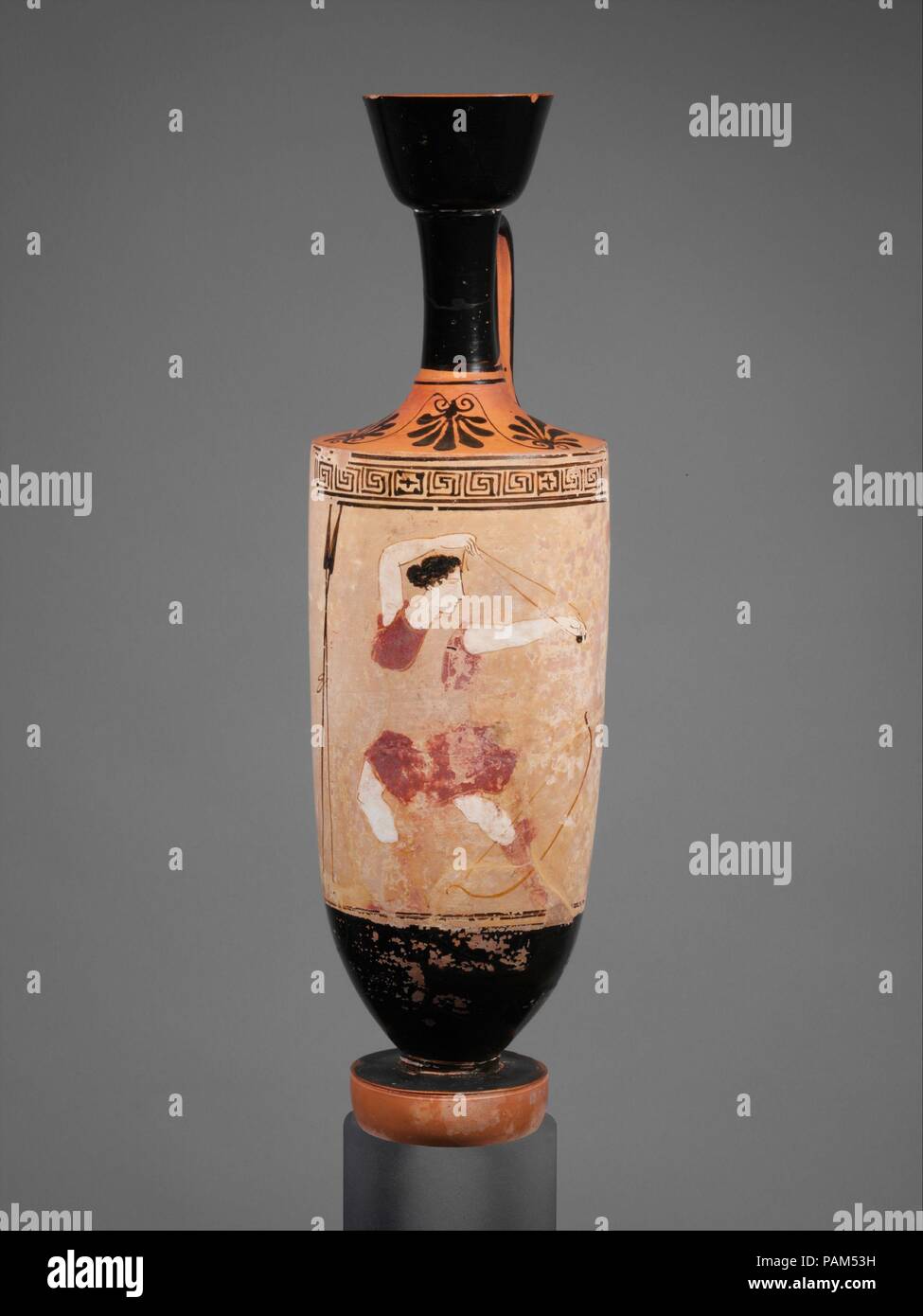 Terracotta lekythos (oil flask). Culture: Greek, Attic. Dimensions: H. 12 7/8 in. (32.7 cm). Date: ca. 440 B.C.. Amazon using a slingshot The Klügmann Painter is distinguished from his contemporaries by his depictions of mythological figures and scenes from daily life rather than funerary subjects. Museum: Metropolitan Museum of Art, New York, USA. Stock Photohttps://www.alamy.com/image-license-details/?v=1https://www.alamy.com/terracotta-lekythos-oil-flask-culture-greek-attic-dimensions-h-12-78-in-327-cm-date-ca-440-bc-amazon-using-a-slingshot-the-klgmann-painter-is-distinguished-from-his-contemporaries-by-his-depictions-of-mythological-figures-and-scenes-from-daily-life-rather-than-funerary-subjects-museum-metropolitan-museum-of-art-new-york-usa-image213114037.html
Terracotta lekythos (oil flask). Culture: Greek, Attic. Dimensions: H. 12 7/8 in. (32.7 cm). Date: ca. 440 B.C.. Amazon using a slingshot The Klügmann Painter is distinguished from his contemporaries by his depictions of mythological figures and scenes from daily life rather than funerary subjects. Museum: Metropolitan Museum of Art, New York, USA. Stock Photohttps://www.alamy.com/image-license-details/?v=1https://www.alamy.com/terracotta-lekythos-oil-flask-culture-greek-attic-dimensions-h-12-78-in-327-cm-date-ca-440-bc-amazon-using-a-slingshot-the-klgmann-painter-is-distinguished-from-his-contemporaries-by-his-depictions-of-mythological-figures-and-scenes-from-daily-life-rather-than-funerary-subjects-museum-metropolitan-museum-of-art-new-york-usa-image213114037.htmlRMPAM53H–Terracotta lekythos (oil flask). Culture: Greek, Attic. Dimensions: H. 12 7/8 in. (32.7 cm). Date: ca. 440 B.C.. Amazon using a slingshot The Klügmann Painter is distinguished from his contemporaries by his depictions of mythological figures and scenes from daily life rather than funerary subjects. Museum: Metropolitan Museum of Art, New York, USA.
 Art inspired by Terracotta lekythos (oil flask), Classical, ca. 440 B.C., Greek, Attic, Terracotta; white-ground, H. 12 7/8 in. (32.7 cm), Vases, Amazon using a slingshot. The Klügmann Painter is distinguished from his contemporaries by his depictions of mythological figures and scenes, Classic works modernized by Artotop with a splash of modernity. Shapes, color and value, eye-catching visual impact on art. Emotions through freedom of artworks in a contemporary way. A timeless message pursuing a wildly creative new direction. Artists turning to the digital medium and creating the Artotop NFT Stock Photohttps://www.alamy.com/image-license-details/?v=1https://www.alamy.com/art-inspired-by-terracotta-lekythos-oil-flask-classical-ca-440-bc-greek-attic-terracotta-white-ground-h-12-78-in-327-cm-vases-amazon-using-a-slingshot-the-klgmann-painter-is-distinguished-from-his-contemporaries-by-his-depictions-of-mythological-figures-and-scenes-classic-works-modernized-by-artotop-with-a-splash-of-modernity-shapes-color-and-value-eye-catching-visual-impact-on-art-emotions-through-freedom-of-artworks-in-a-contemporary-way-a-timeless-message-pursuing-a-wildly-creative-new-direction-artists-turning-to-the-digital-medium-and-creating-the-artotop-nft-image462786296.html
Art inspired by Terracotta lekythos (oil flask), Classical, ca. 440 B.C., Greek, Attic, Terracotta; white-ground, H. 12 7/8 in. (32.7 cm), Vases, Amazon using a slingshot. The Klügmann Painter is distinguished from his contemporaries by his depictions of mythological figures and scenes, Classic works modernized by Artotop with a splash of modernity. Shapes, color and value, eye-catching visual impact on art. Emotions through freedom of artworks in a contemporary way. A timeless message pursuing a wildly creative new direction. Artists turning to the digital medium and creating the Artotop NFT Stock Photohttps://www.alamy.com/image-license-details/?v=1https://www.alamy.com/art-inspired-by-terracotta-lekythos-oil-flask-classical-ca-440-bc-greek-attic-terracotta-white-ground-h-12-78-in-327-cm-vases-amazon-using-a-slingshot-the-klgmann-painter-is-distinguished-from-his-contemporaries-by-his-depictions-of-mythological-figures-and-scenes-classic-works-modernized-by-artotop-with-a-splash-of-modernity-shapes-color-and-value-eye-catching-visual-impact-on-art-emotions-through-freedom-of-artworks-in-a-contemporary-way-a-timeless-message-pursuing-a-wildly-creative-new-direction-artists-turning-to-the-digital-medium-and-creating-the-artotop-nft-image462786296.htmlRF2HTWMJ0–Art inspired by Terracotta lekythos (oil flask), Classical, ca. 440 B.C., Greek, Attic, Terracotta; white-ground, H. 12 7/8 in. (32.7 cm), Vases, Amazon using a slingshot. The Klügmann Painter is distinguished from his contemporaries by his depictions of mythological figures and scenes, Classic works modernized by Artotop with a splash of modernity. Shapes, color and value, eye-catching visual impact on art. Emotions through freedom of artworks in a contemporary way. A timeless message pursuing a wildly creative new direction. Artists turning to the digital medium and creating the Artotop NFT
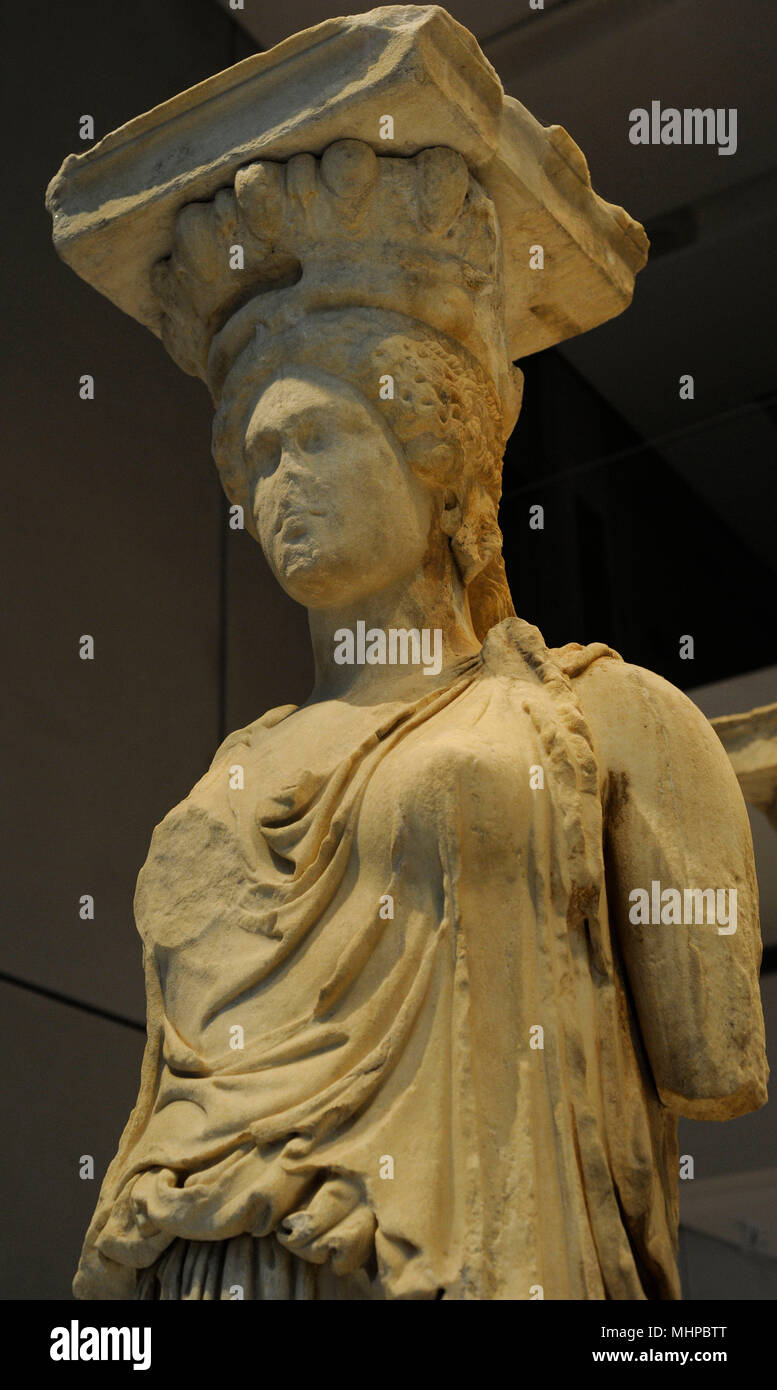 Greek art. The Caryatid Porch of the Erechtheion. Draped female figures as supporting columns. Detail. Acropolis of Athens, 421-407 BC. Greece. Acropolis Museum. Athens. Greece. Stock Photohttps://www.alamy.com/image-license-details/?v=1https://www.alamy.com/greek-art-the-caryatid-porch-of-the-erechtheion-draped-female-figures-as-supporting-columns-detail-acropolis-of-athens-421-407-bc-greece-acropolis-museum-athens-greece-image183045096.html
Greek art. The Caryatid Porch of the Erechtheion. Draped female figures as supporting columns. Detail. Acropolis of Athens, 421-407 BC. Greece. Acropolis Museum. Athens. Greece. Stock Photohttps://www.alamy.com/image-license-details/?v=1https://www.alamy.com/greek-art-the-caryatid-porch-of-the-erechtheion-draped-female-figures-as-supporting-columns-detail-acropolis-of-athens-421-407-bc-greece-acropolis-museum-athens-greece-image183045096.htmlRMMHPBTT–Greek art. The Caryatid Porch of the Erechtheion. Draped female figures as supporting columns. Detail. Acropolis of Athens, 421-407 BC. Greece. Acropolis Museum. Athens. Greece.
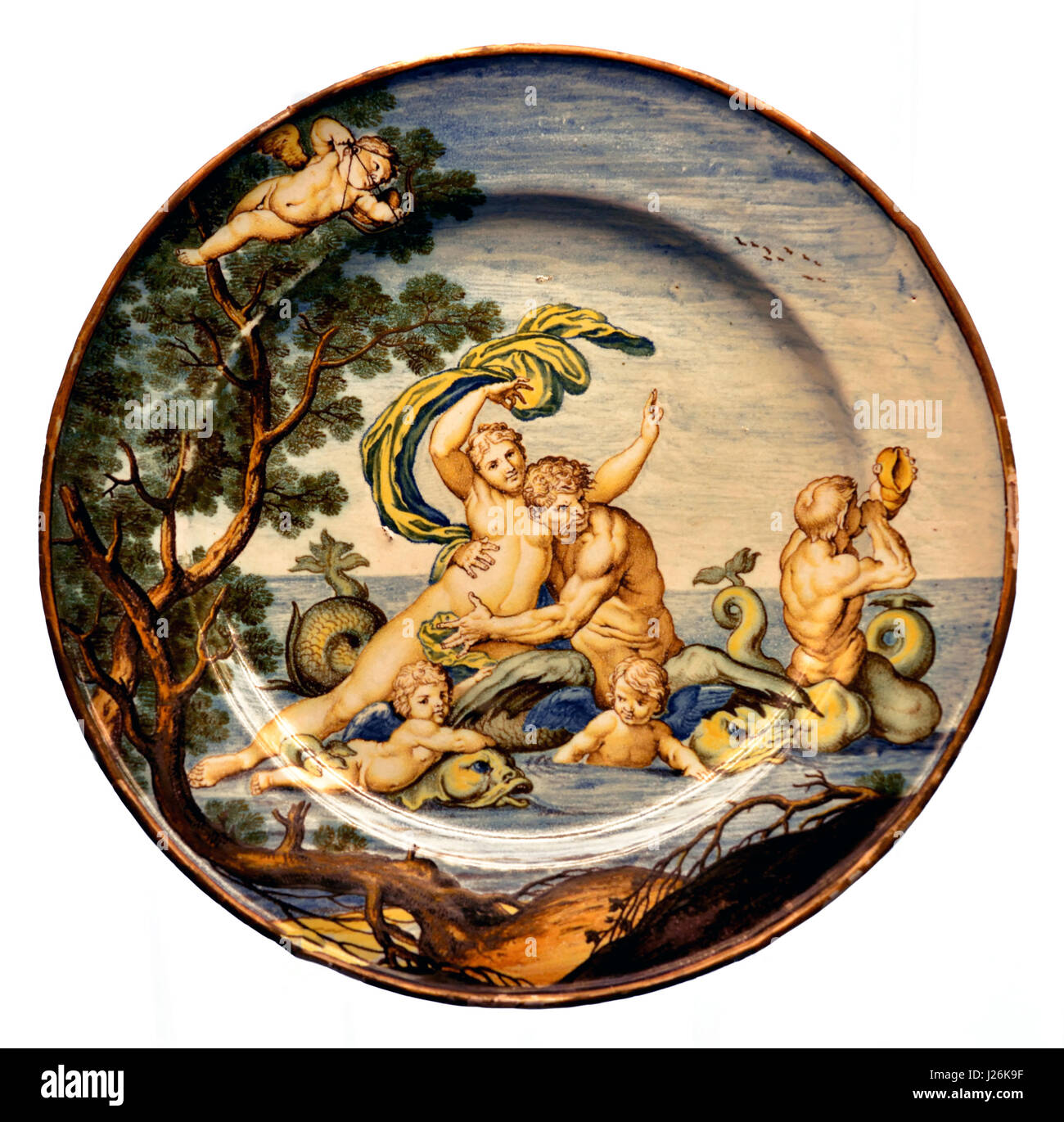 glaucus and scylla ( greek mythology ) Plate with Mythological Figures 1740 by Ferdinando Maria Campani Italy Italian. Stock Photohttps://www.alamy.com/image-license-details/?v=1https://www.alamy.com/stock-photo-glaucus-and-scylla-greek-mythology-plate-with-mythological-figures-139059131.html
glaucus and scylla ( greek mythology ) Plate with Mythological Figures 1740 by Ferdinando Maria Campani Italy Italian. Stock Photohttps://www.alamy.com/image-license-details/?v=1https://www.alamy.com/stock-photo-glaucus-and-scylla-greek-mythology-plate-with-mythological-figures-139059131.htmlRMJ26K9F–glaucus and scylla ( greek mythology ) Plate with Mythological Figures 1740 by Ferdinando Maria Campani Italy Italian.
 Cypr Archaeological Museum of the Paphos. Ancient Mosaic Artwork. Ancient Greek mosaic depicting mythological figures. Stock Photohttps://www.alamy.com/image-license-details/?v=1https://www.alamy.com/cypr-archaeological-museum-of-the-paphos-ancient-mosaic-artwork-ancient-greek-mosaic-depicting-mythological-figures-image601954534.html
Cypr Archaeological Museum of the Paphos. Ancient Mosaic Artwork. Ancient Greek mosaic depicting mythological figures. Stock Photohttps://www.alamy.com/image-license-details/?v=1https://www.alamy.com/cypr-archaeological-museum-of-the-paphos-ancient-mosaic-artwork-ancient-greek-mosaic-depicting-mythological-figures-image601954534.htmlRF2WY9B46–Cypr Archaeological Museum of the Paphos. Ancient Mosaic Artwork. Ancient Greek mosaic depicting mythological figures.
 Detail on the Parthenon Replica in Centennial Park, Nashville, Tennessee, USA Stock Photohttps://www.alamy.com/image-license-details/?v=1https://www.alamy.com/stock-photo-detail-on-the-parthenon-replica-in-centennial-park-nashville-tennessee-23782658.html
Detail on the Parthenon Replica in Centennial Park, Nashville, Tennessee, USA Stock Photohttps://www.alamy.com/image-license-details/?v=1https://www.alamy.com/stock-photo-detail-on-the-parthenon-replica-in-centennial-park-nashville-tennessee-23782658.htmlRMBAKB0J–Detail on the Parthenon Replica in Centennial Park, Nashville, Tennessee, USA
 Classical Greek Ceramics Lindos Greece Stock Photohttps://www.alamy.com/image-license-details/?v=1https://www.alamy.com/classical-greek-ceramics-lindos-greece-image61322272.html
Classical Greek Ceramics Lindos Greece Stock Photohttps://www.alamy.com/image-license-details/?v=1https://www.alamy.com/classical-greek-ceramics-lindos-greece-image61322272.htmlRMDFND54–Classical Greek Ceramics Lindos Greece
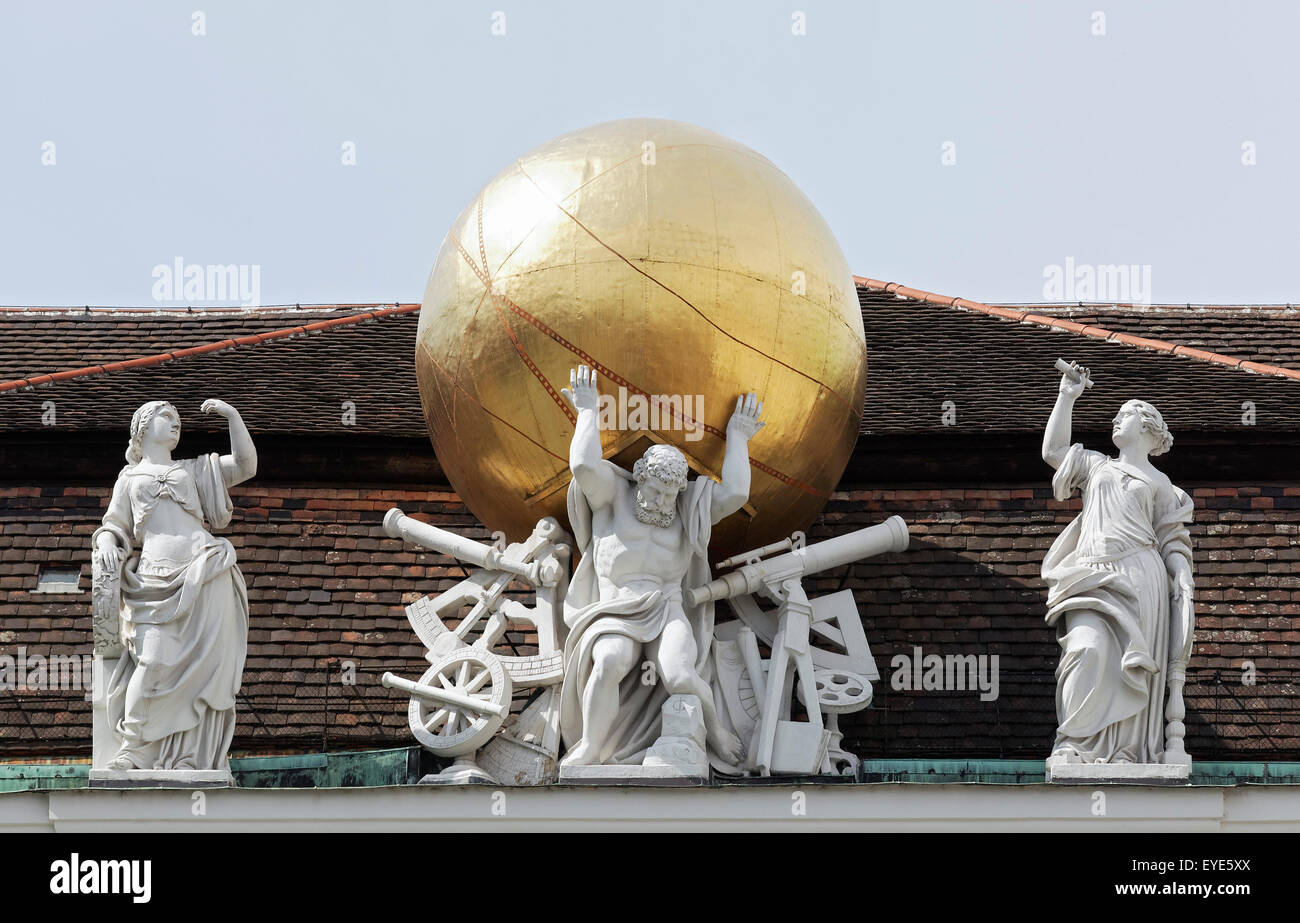 Atlas carrying the firmament on his shoulders, mythological figures on the roof of the National Library, Josefsplatz, Vienna Stock Photohttps://www.alamy.com/image-license-details/?v=1https://www.alamy.com/stock-photo-atlas-carrying-the-firmament-on-his-shoulders-mythological-figures-85749186.html
Atlas carrying the firmament on his shoulders, mythological figures on the roof of the National Library, Josefsplatz, Vienna Stock Photohttps://www.alamy.com/image-license-details/?v=1https://www.alamy.com/stock-photo-atlas-carrying-the-firmament-on-his-shoulders-mythological-figures-85749186.htmlRFEYE5XX–Atlas carrying the firmament on his shoulders, mythological figures on the roof of the National Library, Josefsplatz, Vienna
 ATHENS, GREECE, JUN 04, 2016.One of the many souvenir shops in the Greek capital of Athens. On the shelf are mythological figures of the Greek gods. Stock Photohttps://www.alamy.com/image-license-details/?v=1https://www.alamy.com/athens-greece-jun-04-2016one-of-the-many-souvenir-shops-in-the-greek-capital-of-athens-on-the-shelf-are-mythological-figures-of-the-greek-gods-image269476807.html
ATHENS, GREECE, JUN 04, 2016.One of the many souvenir shops in the Greek capital of Athens. On the shelf are mythological figures of the Greek gods. Stock Photohttps://www.alamy.com/image-license-details/?v=1https://www.alamy.com/athens-greece-jun-04-2016one-of-the-many-souvenir-shops-in-the-greek-capital-of-athens-on-the-shelf-are-mythological-figures-of-the-greek-gods-image269476807.htmlRFWJBMBK–ATHENS, GREECE, JUN 04, 2016.One of the many souvenir shops in the Greek capital of Athens. On the shelf are mythological figures of the Greek gods.
 Art inspired by Fragment of a terracotta bell-krater (mixing bowl), Classical, late 5th century B.C., Greek, South Italian, Lucanian, Terracotta; red-figure, H. 3 1/4 in. (8.2 cm), Vases, Head and arms of an Amazon with a spear. This detail from a mythological representation with, Classic works modernized by Artotop with a splash of modernity. Shapes, color and value, eye-catching visual impact on art. Emotions through freedom of artworks in a contemporary way. A timeless message pursuing a wildly creative new direction. Artists turning to the digital medium and creating the Artotop NFT Stock Photohttps://www.alamy.com/image-license-details/?v=1https://www.alamy.com/art-inspired-by-fragment-of-a-terracotta-bell-krater-mixing-bowl-classical-late-5th-century-bc-greek-south-italian-lucanian-terracotta-red-figure-h-3-14-in-82-cm-vases-head-and-arms-of-an-amazon-with-a-spear-this-detail-from-a-mythological-representation-with-classic-works-modernized-by-artotop-with-a-splash-of-modernity-shapes-color-and-value-eye-catching-visual-impact-on-art-emotions-through-freedom-of-artworks-in-a-contemporary-way-a-timeless-message-pursuing-a-wildly-creative-new-direction-artists-turning-to-the-digital-medium-and-creating-the-artotop-nft-image462933669.html
Art inspired by Fragment of a terracotta bell-krater (mixing bowl), Classical, late 5th century B.C., Greek, South Italian, Lucanian, Terracotta; red-figure, H. 3 1/4 in. (8.2 cm), Vases, Head and arms of an Amazon with a spear. This detail from a mythological representation with, Classic works modernized by Artotop with a splash of modernity. Shapes, color and value, eye-catching visual impact on art. Emotions through freedom of artworks in a contemporary way. A timeless message pursuing a wildly creative new direction. Artists turning to the digital medium and creating the Artotop NFT Stock Photohttps://www.alamy.com/image-license-details/?v=1https://www.alamy.com/art-inspired-by-fragment-of-a-terracotta-bell-krater-mixing-bowl-classical-late-5th-century-bc-greek-south-italian-lucanian-terracotta-red-figure-h-3-14-in-82-cm-vases-head-and-arms-of-an-amazon-with-a-spear-this-detail-from-a-mythological-representation-with-classic-works-modernized-by-artotop-with-a-splash-of-modernity-shapes-color-and-value-eye-catching-visual-impact-on-art-emotions-through-freedom-of-artworks-in-a-contemporary-way-a-timeless-message-pursuing-a-wildly-creative-new-direction-artists-turning-to-the-digital-medium-and-creating-the-artotop-nft-image462933669.htmlRF2HW4CH9–Art inspired by Fragment of a terracotta bell-krater (mixing bowl), Classical, late 5th century B.C., Greek, South Italian, Lucanian, Terracotta; red-figure, H. 3 1/4 in. (8.2 cm), Vases, Head and arms of an Amazon with a spear. This detail from a mythological representation with, Classic works modernized by Artotop with a splash of modernity. Shapes, color and value, eye-catching visual impact on art. Emotions through freedom of artworks in a contemporary way. A timeless message pursuing a wildly creative new direction. Artists turning to the digital medium and creating the Artotop NFT
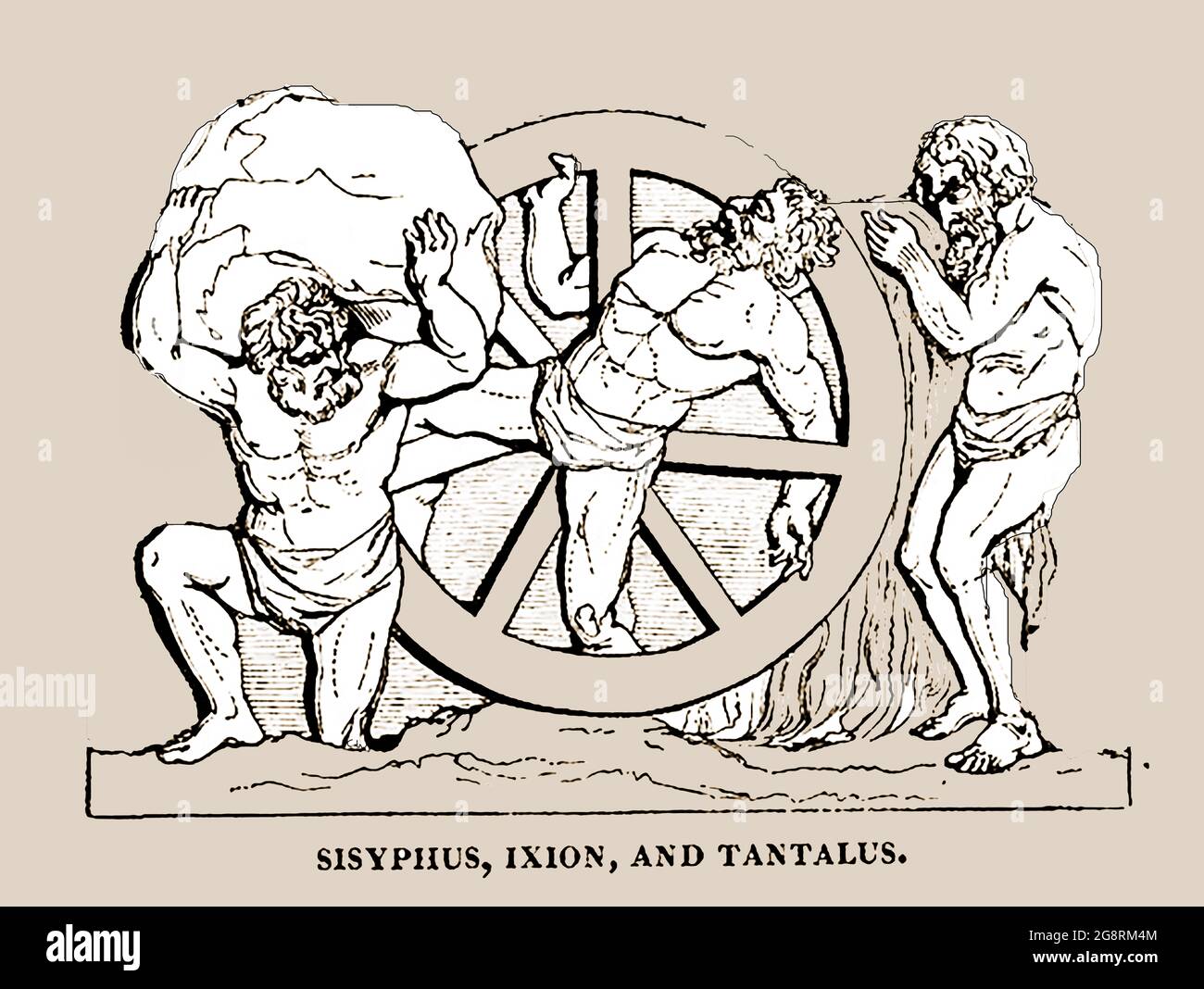 An 1839 depiction of the mythological figures Sisyphus .Ixion and Tantalus. Sisyphus or Sisyphos was the founder and king of Ephyra (now known as Corinth) and was sentenced to rolling a boulder up a hill for eternity whilst Ixion was king of the Lapiths, the most ancient tribe of Thessaly and was was bound to a burning solar wheel for eternity. Tantalus also known as Atyus and sometimes known as King of Phrygia. He is remembered by the proverb of 'Tantalean punishments' (being tempted by something one cannot have). Stock Photohttps://www.alamy.com/image-license-details/?v=1https://www.alamy.com/an-1839-depiction-of-the-mythological-figures-sisyphus-ixion-and-tantalus-sisyphus-or-sisyphos-was-the-founder-and-king-of-ephyra-now-known-as-corinth-and-was-sentenced-to-rolling-a-boulder-up-a-hill-for-eternity-whilst-ixion-was-king-of-the-lapiths-the-most-ancient-tribe-of-thessaly-and-was-was-bound-to-a-burning-solar-wheel-for-eternity-tantalus-also-known-as-atyus-and-sometimes-known-as-king-of-phrygia-he-is-remembered-by-the-proverb-of-tantalean-punishments-being-tempted-by-something-one-cannot-have-image435697156.html
An 1839 depiction of the mythological figures Sisyphus .Ixion and Tantalus. Sisyphus or Sisyphos was the founder and king of Ephyra (now known as Corinth) and was sentenced to rolling a boulder up a hill for eternity whilst Ixion was king of the Lapiths, the most ancient tribe of Thessaly and was was bound to a burning solar wheel for eternity. Tantalus also known as Atyus and sometimes known as King of Phrygia. He is remembered by the proverb of 'Tantalean punishments' (being tempted by something one cannot have). Stock Photohttps://www.alamy.com/image-license-details/?v=1https://www.alamy.com/an-1839-depiction-of-the-mythological-figures-sisyphus-ixion-and-tantalus-sisyphus-or-sisyphos-was-the-founder-and-king-of-ephyra-now-known-as-corinth-and-was-sentenced-to-rolling-a-boulder-up-a-hill-for-eternity-whilst-ixion-was-king-of-the-lapiths-the-most-ancient-tribe-of-thessaly-and-was-was-bound-to-a-burning-solar-wheel-for-eternity-tantalus-also-known-as-atyus-and-sometimes-known-as-king-of-phrygia-he-is-remembered-by-the-proverb-of-tantalean-punishments-being-tempted-by-something-one-cannot-have-image435697156.htmlRM2G8RM4M–An 1839 depiction of the mythological figures Sisyphus .Ixion and Tantalus. Sisyphus or Sisyphos was the founder and king of Ephyra (now known as Corinth) and was sentenced to rolling a boulder up a hill for eternity whilst Ixion was king of the Lapiths, the most ancient tribe of Thessaly and was was bound to a burning solar wheel for eternity. Tantalus also known as Atyus and sometimes known as King of Phrygia. He is remembered by the proverb of 'Tantalean punishments' (being tempted by something one cannot have).
 Art inspired by Bronze mirror with a support in the form of a draped woman, Classical, mid-5th century B.C., Greek, Argive, Bronze, H. 15 15/16 in. (40.41 cm), Bronzes, The integration of three-dimensional figures into the design of a functional object is a hallmark of Greek art. A, Classic works modernized by Artotop with a splash of modernity. Shapes, color and value, eye-catching visual impact on art. Emotions through freedom of artworks in a contemporary way. A timeless message pursuing a wildly creative new direction. Artists turning to the digital medium and creating the Artotop NFT Stock Photohttps://www.alamy.com/image-license-details/?v=1https://www.alamy.com/art-inspired-by-bronze-mirror-with-a-support-in-the-form-of-a-draped-woman-classical-mid-5th-century-bc-greek-argive-bronze-h-15-1516-in-4041-cm-bronzes-the-integration-of-three-dimensional-figures-into-the-design-of-a-functional-object-is-a-hallmark-of-greek-art-a-classic-works-modernized-by-artotop-with-a-splash-of-modernity-shapes-color-and-value-eye-catching-visual-impact-on-art-emotions-through-freedom-of-artworks-in-a-contemporary-way-a-timeless-message-pursuing-a-wildly-creative-new-direction-artists-turning-to-the-digital-medium-and-creating-the-artotop-nft-image462933885.html
Art inspired by Bronze mirror with a support in the form of a draped woman, Classical, mid-5th century B.C., Greek, Argive, Bronze, H. 15 15/16 in. (40.41 cm), Bronzes, The integration of three-dimensional figures into the design of a functional object is a hallmark of Greek art. A, Classic works modernized by Artotop with a splash of modernity. Shapes, color and value, eye-catching visual impact on art. Emotions through freedom of artworks in a contemporary way. A timeless message pursuing a wildly creative new direction. Artists turning to the digital medium and creating the Artotop NFT Stock Photohttps://www.alamy.com/image-license-details/?v=1https://www.alamy.com/art-inspired-by-bronze-mirror-with-a-support-in-the-form-of-a-draped-woman-classical-mid-5th-century-bc-greek-argive-bronze-h-15-1516-in-4041-cm-bronzes-the-integration-of-three-dimensional-figures-into-the-design-of-a-functional-object-is-a-hallmark-of-greek-art-a-classic-works-modernized-by-artotop-with-a-splash-of-modernity-shapes-color-and-value-eye-catching-visual-impact-on-art-emotions-through-freedom-of-artworks-in-a-contemporary-way-a-timeless-message-pursuing-a-wildly-creative-new-direction-artists-turning-to-the-digital-medium-and-creating-the-artotop-nft-image462933885.htmlRF2HW4CW1–Art inspired by Bronze mirror with a support in the form of a draped woman, Classical, mid-5th century B.C., Greek, Argive, Bronze, H. 15 15/16 in. (40.41 cm), Bronzes, The integration of three-dimensional figures into the design of a functional object is a hallmark of Greek art. A, Classic works modernized by Artotop with a splash of modernity. Shapes, color and value, eye-catching visual impact on art. Emotions through freedom of artworks in a contemporary way. A timeless message pursuing a wildly creative new direction. Artists turning to the digital medium and creating the Artotop NFT
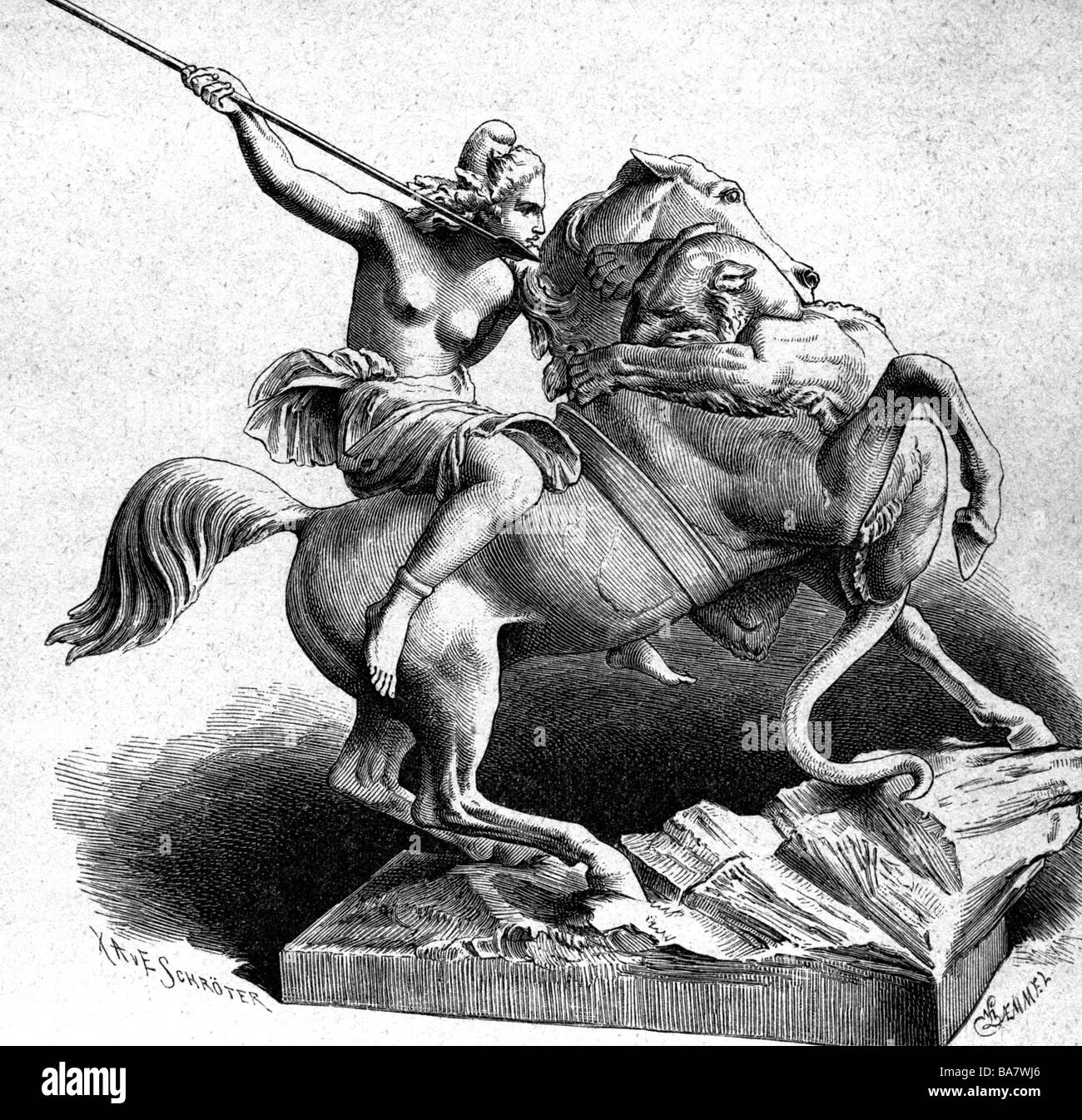 Amazons, Greek mythological figures, 'Riding Amazon fighting with Panther', full length, wood engraving after sculpture by August Riss (1802 - 1865), , Stock Photohttps://www.alamy.com/image-license-details/?v=1https://www.alamy.com/stock-photo-amazons-greek-mythological-figures-riding-amazon-fighting-with-panther-23530702.html
Amazons, Greek mythological figures, 'Riding Amazon fighting with Panther', full length, wood engraving after sculpture by August Riss (1802 - 1865), , Stock Photohttps://www.alamy.com/image-license-details/?v=1https://www.alamy.com/stock-photo-amazons-greek-mythological-figures-riding-amazon-fighting-with-panther-23530702.htmlRMBA7WJ6–Amazons, Greek mythological figures, 'Riding Amazon fighting with Panther', full length, wood engraving after sculpture by August Riss (1802 - 1865), ,
 The pediment on the Philadelphia Museum of Art by Carl Paul Jennewein depicts 13 Greek gods and goddesses with a theme of love in Western Civilization. Stock Photohttps://www.alamy.com/image-license-details/?v=1https://www.alamy.com/the-pediment-on-the-philadelphia-museum-of-art-by-carl-paul-jennewein-depicts-13-greek-gods-and-goddesses-with-a-theme-of-love-in-western-civilization-image516832612.html
The pediment on the Philadelphia Museum of Art by Carl Paul Jennewein depicts 13 Greek gods and goddesses with a theme of love in Western Civilization. Stock Photohttps://www.alamy.com/image-license-details/?v=1https://www.alamy.com/the-pediment-on-the-philadelphia-museum-of-art-by-carl-paul-jennewein-depicts-13-greek-gods-and-goddesses-with-a-theme-of-love-in-western-civilization-image516832612.htmlRM2N0RN7G–The pediment on the Philadelphia Museum of Art by Carl Paul Jennewein depicts 13 Greek gods and goddesses with a theme of love in Western Civilization.
 Flat design illustration set of Greek mythology creatures and figures on white background. Stock Vectorhttps://www.alamy.com/image-license-details/?v=1https://www.alamy.com/flat-design-illustration-set-of-greek-mythology-creatures-and-figures-on-white-background-image596039051.html
Flat design illustration set of Greek mythology creatures and figures on white background. Stock Vectorhttps://www.alamy.com/image-license-details/?v=1https://www.alamy.com/flat-design-illustration-set-of-greek-mythology-creatures-and-figures-on-white-background-image596039051.htmlRF2WHKWTY–Flat design illustration set of Greek mythology creatures and figures on white background.
 An illustration from Life Magazine (January 18, 1963) showing figures from Greek mythology, including Medea, Orpheus, Eurydice, Pollux, Castor, Cadmus, Asclepius, Theseus, Atlas, Hercules, Icarus and Daedalus. Stock Photohttps://www.alamy.com/image-license-details/?v=1https://www.alamy.com/stock-photo-an-illustration-from-life-magazine-january-18-1963-showing-figures-103999717.html
An illustration from Life Magazine (January 18, 1963) showing figures from Greek mythology, including Medea, Orpheus, Eurydice, Pollux, Castor, Cadmus, Asclepius, Theseus, Atlas, Hercules, Icarus and Daedalus. Stock Photohttps://www.alamy.com/image-license-details/?v=1https://www.alamy.com/stock-photo-an-illustration-from-life-magazine-january-18-1963-showing-figures-103999717.htmlRMG15GKH–An illustration from Life Magazine (January 18, 1963) showing figures from Greek mythology, including Medea, Orpheus, Eurydice, Pollux, Castor, Cadmus, Asclepius, Theseus, Atlas, Hercules, Icarus and Daedalus.
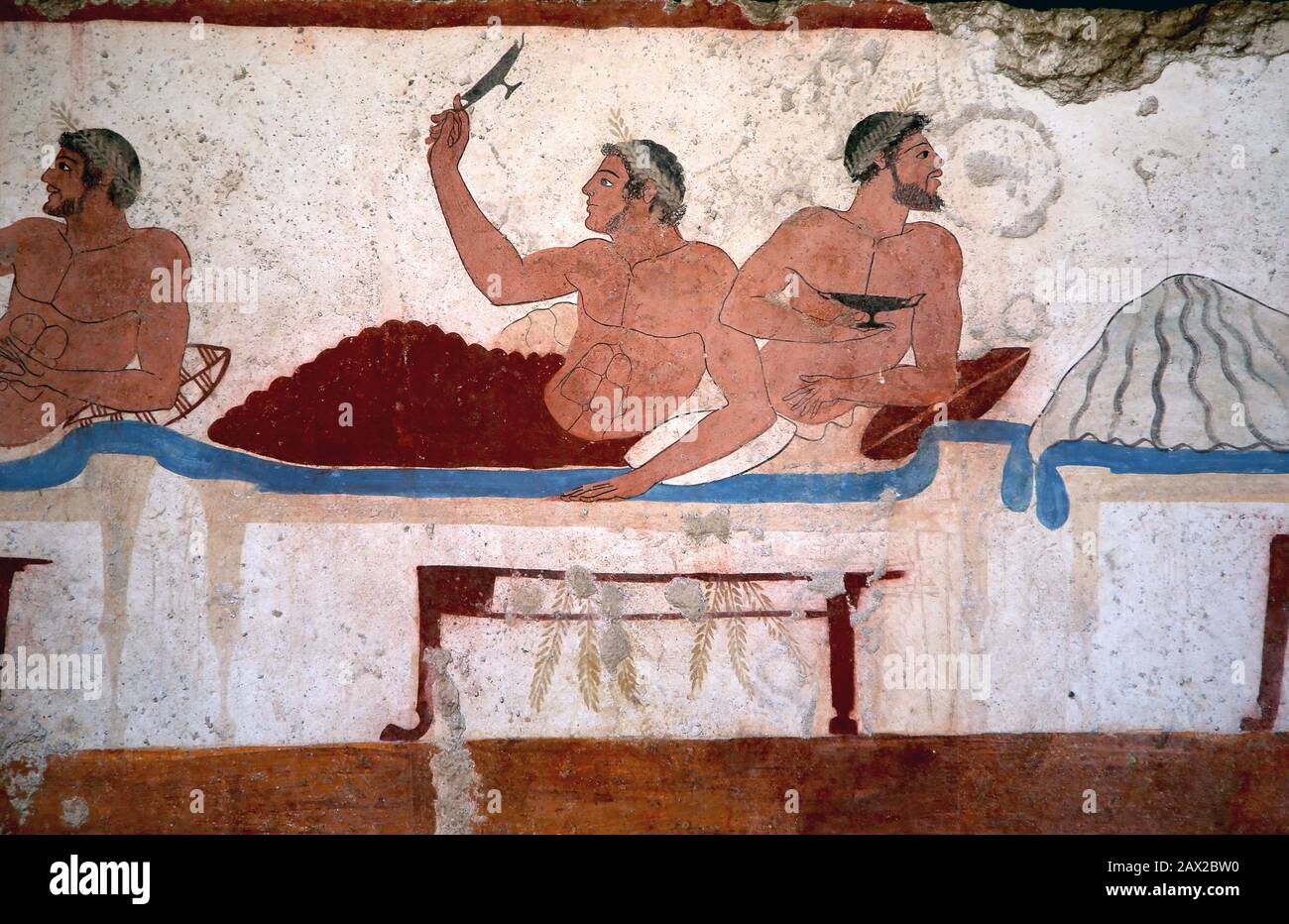 Tomb of the diver, North wall fresco. Detail. Drinking feast scene with men. 480 BC. Greek Art. Paestum Archaeological Museum, Italy. Stock Photohttps://www.alamy.com/image-license-details/?v=1https://www.alamy.com/tomb-of-the-diver-north-wall-fresco-detail-drinking-feast-scene-with-men-480-bc-greek-art-paestum-archaeological-museum-italy-image343031276.html
Tomb of the diver, North wall fresco. Detail. Drinking feast scene with men. 480 BC. Greek Art. Paestum Archaeological Museum, Italy. Stock Photohttps://www.alamy.com/image-license-details/?v=1https://www.alamy.com/tomb-of-the-diver-north-wall-fresco-detail-drinking-feast-scene-with-men-480-bc-greek-art-paestum-archaeological-museum-italy-image343031276.htmlRM2AX2BW0–Tomb of the diver, North wall fresco. Detail. Drinking feast scene with men. 480 BC. Greek Art. Paestum Archaeological Museum, Italy.
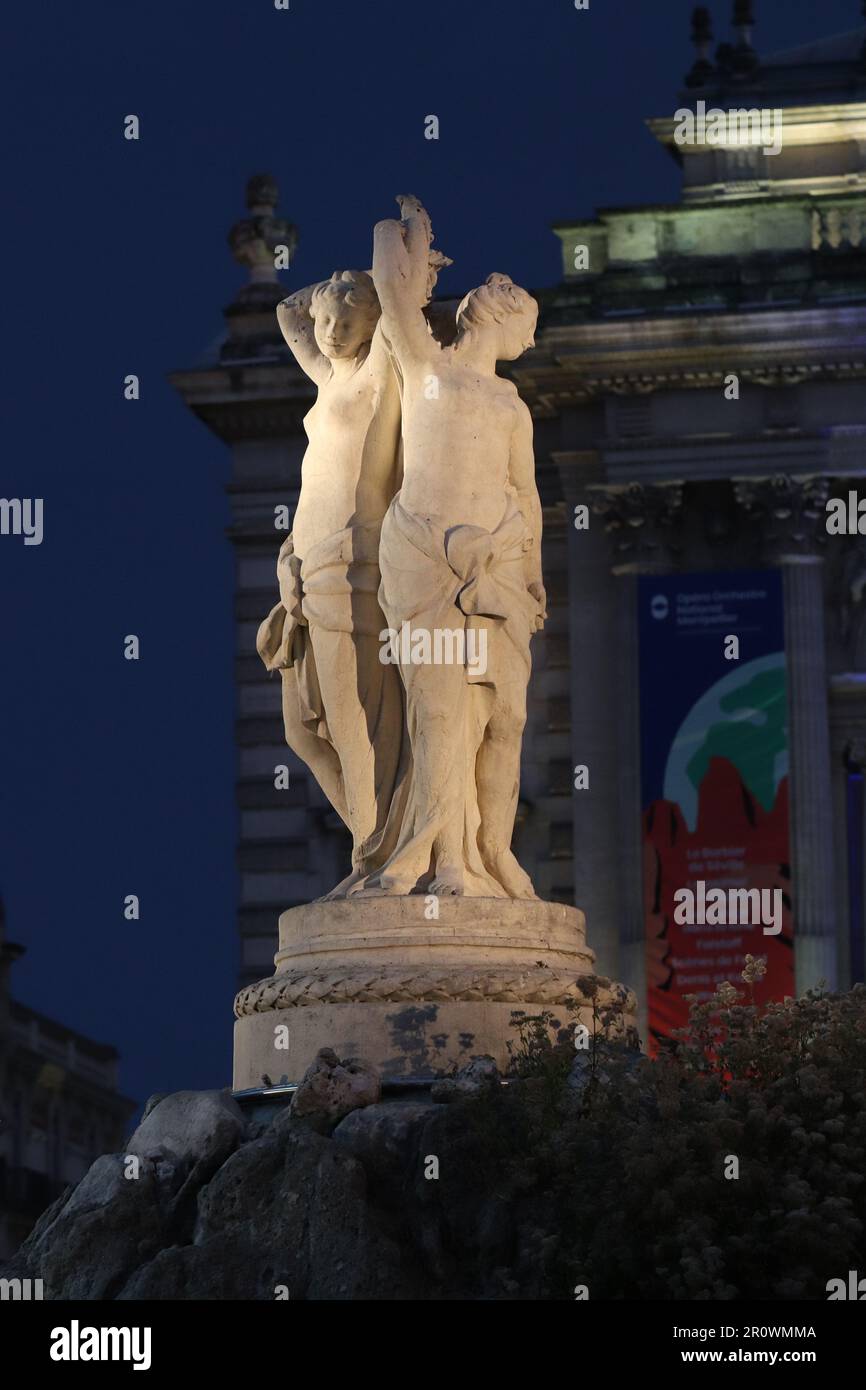 The Three Graces Statue Displayed Prominently in Montpellier, France Stock Photohttps://www.alamy.com/image-license-details/?v=1https://www.alamy.com/the-three-graces-statue-displayed-prominently-in-montpellier-france-image551296826.html
The Three Graces Statue Displayed Prominently in Montpellier, France Stock Photohttps://www.alamy.com/image-license-details/?v=1https://www.alamy.com/the-three-graces-statue-displayed-prominently-in-montpellier-france-image551296826.htmlRF2R0WMMA–The Three Graces Statue Displayed Prominently in Montpellier, France
 Detail, Greek antique vase with a black and orange scene depicting mythological figures, Heracles, Athena, interiors, Archaeological Museum, Old Stock Photohttps://www.alamy.com/image-license-details/?v=1https://www.alamy.com/detail-greek-antique-vase-with-a-black-and-orange-scene-depicting-mythological-figures-heracles-athena-interiors-archaeological-museum-old-image606876113.html
Detail, Greek antique vase with a black and orange scene depicting mythological figures, Heracles, Athena, interiors, Archaeological Museum, Old Stock Photohttps://www.alamy.com/image-license-details/?v=1https://www.alamy.com/detail-greek-antique-vase-with-a-black-and-orange-scene-depicting-mythological-figures-heracles-athena-interiors-archaeological-museum-old-image606876113.htmlRM2X79GJW–Detail, Greek antique vase with a black and orange scene depicting mythological figures, Heracles, Athena, interiors, Archaeological Museum, Old
 Fragment of a terracotta bell-krater (mixing bowl). Culture: Greek, South Italian, Lucanian. Dimensions: H. 3 1/4 in. (8.2 cm). Date: late 5th century B.C.. Head and arms of an Amazon with a spear This detail from a mythological representation with numerous figures highlights the ease and rapidity with which the artist handled both the glaze line and the dilute glaze. Museum: Metropolitan Museum of Art, New York, USA. Stock Photohttps://www.alamy.com/image-license-details/?v=1https://www.alamy.com/fragment-of-a-terracotta-bell-krater-mixing-bowl-culture-greek-south-italian-lucanian-dimensions-h-3-14-in-82-cm-date-late-5th-century-bc-head-and-arms-of-an-amazon-with-a-spear-this-detail-from-a-mythological-representation-with-numerous-figures-highlights-the-ease-and-rapidity-with-which-the-artist-handled-both-the-glaze-line-and-the-dilute-glaze-museum-metropolitan-museum-of-art-new-york-usa-image213400174.html
Fragment of a terracotta bell-krater (mixing bowl). Culture: Greek, South Italian, Lucanian. Dimensions: H. 3 1/4 in. (8.2 cm). Date: late 5th century B.C.. Head and arms of an Amazon with a spear This detail from a mythological representation with numerous figures highlights the ease and rapidity with which the artist handled both the glaze line and the dilute glaze. Museum: Metropolitan Museum of Art, New York, USA. Stock Photohttps://www.alamy.com/image-license-details/?v=1https://www.alamy.com/fragment-of-a-terracotta-bell-krater-mixing-bowl-culture-greek-south-italian-lucanian-dimensions-h-3-14-in-82-cm-date-late-5th-century-bc-head-and-arms-of-an-amazon-with-a-spear-this-detail-from-a-mythological-representation-with-numerous-figures-highlights-the-ease-and-rapidity-with-which-the-artist-handled-both-the-glaze-line-and-the-dilute-glaze-museum-metropolitan-museum-of-art-new-york-usa-image213400174.htmlRMPB562P–Fragment of a terracotta bell-krater (mixing bowl). Culture: Greek, South Italian, Lucanian. Dimensions: H. 3 1/4 in. (8.2 cm). Date: late 5th century B.C.. Head and arms of an Amazon with a spear This detail from a mythological representation with numerous figures highlights the ease and rapidity with which the artist handled both the glaze line and the dilute glaze. Museum: Metropolitan Museum of Art, New York, USA.
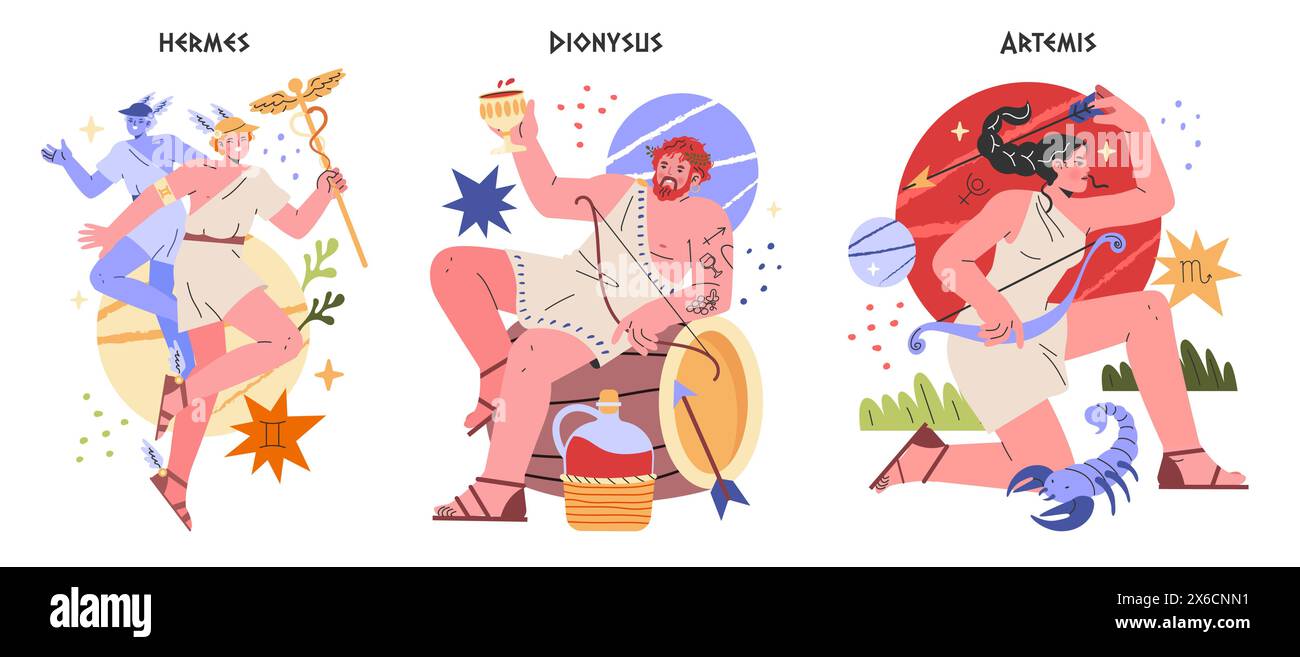 Ancient Greek Gods set. Hermes, Dionysus, and Artemis portrayed in vibrant modern illustrations. Mythological figures with symbolic attributes. Vector illustration. Stock Vectorhttps://www.alamy.com/image-license-details/?v=1https://www.alamy.com/ancient-greek-gods-set-hermes-dionysus-and-artemis-portrayed-in-vibrant-modern-illustrations-mythological-figures-with-symbolic-attributes-vector-illustration-image606331293.html
Ancient Greek Gods set. Hermes, Dionysus, and Artemis portrayed in vibrant modern illustrations. Mythological figures with symbolic attributes. Vector illustration. Stock Vectorhttps://www.alamy.com/image-license-details/?v=1https://www.alamy.com/ancient-greek-gods-set-hermes-dionysus-and-artemis-portrayed-in-vibrant-modern-illustrations-mythological-figures-with-symbolic-attributes-vector-illustration-image606331293.htmlRF2X6CNN1–Ancient Greek Gods set. Hermes, Dionysus, and Artemis portrayed in vibrant modern illustrations. Mythological figures with symbolic attributes. Vector illustration.
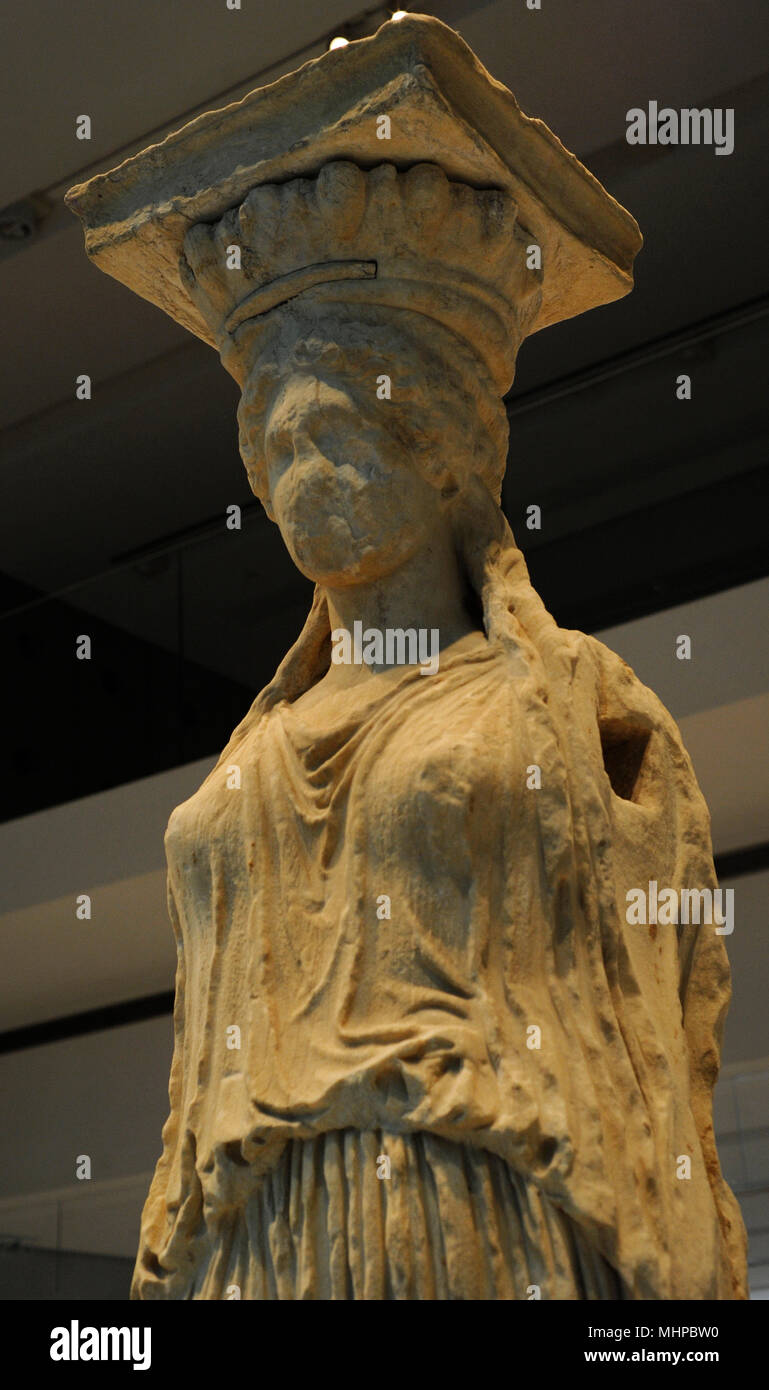 Greek art. The Caryatid Porch of the Erechtheion. Draped female figures as supporting columns. Detail. Acropolis of Athens, 421-407 BC. Greece. Acropolis Museum. Athens. Greece. Stock Photohttps://www.alamy.com/image-license-details/?v=1https://www.alamy.com/greek-art-the-caryatid-porch-of-the-erechtheion-draped-female-figures-as-supporting-columns-detail-acropolis-of-athens-421-407-bc-greece-acropolis-museum-athens-greece-image183045100.html
Greek art. The Caryatid Porch of the Erechtheion. Draped female figures as supporting columns. Detail. Acropolis of Athens, 421-407 BC. Greece. Acropolis Museum. Athens. Greece. Stock Photohttps://www.alamy.com/image-license-details/?v=1https://www.alamy.com/greek-art-the-caryatid-porch-of-the-erechtheion-draped-female-figures-as-supporting-columns-detail-acropolis-of-athens-421-407-bc-greece-acropolis-museum-athens-greece-image183045100.htmlRMMHPBW0–Greek art. The Caryatid Porch of the Erechtheion. Draped female figures as supporting columns. Detail. Acropolis of Athens, 421-407 BC. Greece. Acropolis Museum. Athens. Greece.
 ATHENS, Greece — Black-on-white Greek pottery, featuring the distinctive white-ground technique, is displayed at the National Archaeological Museum in Athens. This style of pottery, characterized by black figures and designs painted on a white slip, was prominent in ancient Greece from the 6th to 5th centuries BC. The museum's collection showcases various pottery forms, including lekythoi, kraters, and amphorae, adorned with mythological scenes, daily life depictions, and geometric patterns, highlighting the artistic achievements and cultural heritage of ancient Greece. Stock Photohttps://www.alamy.com/image-license-details/?v=1https://www.alamy.com/athens-greece-black-on-white-greek-pottery-featuring-the-distinctive-white-ground-technique-is-displayed-at-the-national-archaeological-museum-in-athens-this-style-of-pottery-characterized-by-black-figures-and-designs-painted-on-a-white-slip-was-prominent-in-ancient-greece-from-the-6th-to-5th-centuries-bc-the-museums-collection-showcases-various-pottery-forms-including-lekythoi-kraters-and-amphorae-adorned-with-mythological-scenes-daily-life-depictions-and-geometric-patterns-highlighting-the-artistic-achievements-and-cultural-heritage-of-ancient-greece-image615726160.html
ATHENS, Greece — Black-on-white Greek pottery, featuring the distinctive white-ground technique, is displayed at the National Archaeological Museum in Athens. This style of pottery, characterized by black figures and designs painted on a white slip, was prominent in ancient Greece from the 6th to 5th centuries BC. The museum's collection showcases various pottery forms, including lekythoi, kraters, and amphorae, adorned with mythological scenes, daily life depictions, and geometric patterns, highlighting the artistic achievements and cultural heritage of ancient Greece. Stock Photohttps://www.alamy.com/image-license-details/?v=1https://www.alamy.com/athens-greece-black-on-white-greek-pottery-featuring-the-distinctive-white-ground-technique-is-displayed-at-the-national-archaeological-museum-in-athens-this-style-of-pottery-characterized-by-black-figures-and-designs-painted-on-a-white-slip-was-prominent-in-ancient-greece-from-the-6th-to-5th-centuries-bc-the-museums-collection-showcases-various-pottery-forms-including-lekythoi-kraters-and-amphorae-adorned-with-mythological-scenes-daily-life-depictions-and-geometric-patterns-highlighting-the-artistic-achievements-and-cultural-heritage-of-ancient-greece-image615726160.htmlRM2XNMN00–ATHENS, Greece — Black-on-white Greek pottery, featuring the distinctive white-ground technique, is displayed at the National Archaeological Museum in Athens. This style of pottery, characterized by black figures and designs painted on a white slip, was prominent in ancient Greece from the 6th to 5th centuries BC. The museum's collection showcases various pottery forms, including lekythoi, kraters, and amphorae, adorned with mythological scenes, daily life depictions, and geometric patterns, highlighting the artistic achievements and cultural heritage of ancient Greece.
 THE GARDEN ENTRANCE OF THE ACHILLEION PALACE. GASTOURI. CORFU. IONIAN GREEK ISLAND Stock Photohttps://www.alamy.com/image-license-details/?v=1https://www.alamy.com/stock-photo-the-garden-entrance-of-the-achilleion-palace-gastouri-corfu-ionian-10330670.html
THE GARDEN ENTRANCE OF THE ACHILLEION PALACE. GASTOURI. CORFU. IONIAN GREEK ISLAND Stock Photohttps://www.alamy.com/image-license-details/?v=1https://www.alamy.com/stock-photo-the-garden-entrance-of-the-achilleion-palace-gastouri-corfu-ionian-10330670.htmlRMA1TMKY–THE GARDEN ENTRANCE OF THE ACHILLEION PALACE. GASTOURI. CORFU. IONIAN GREEK ISLAND
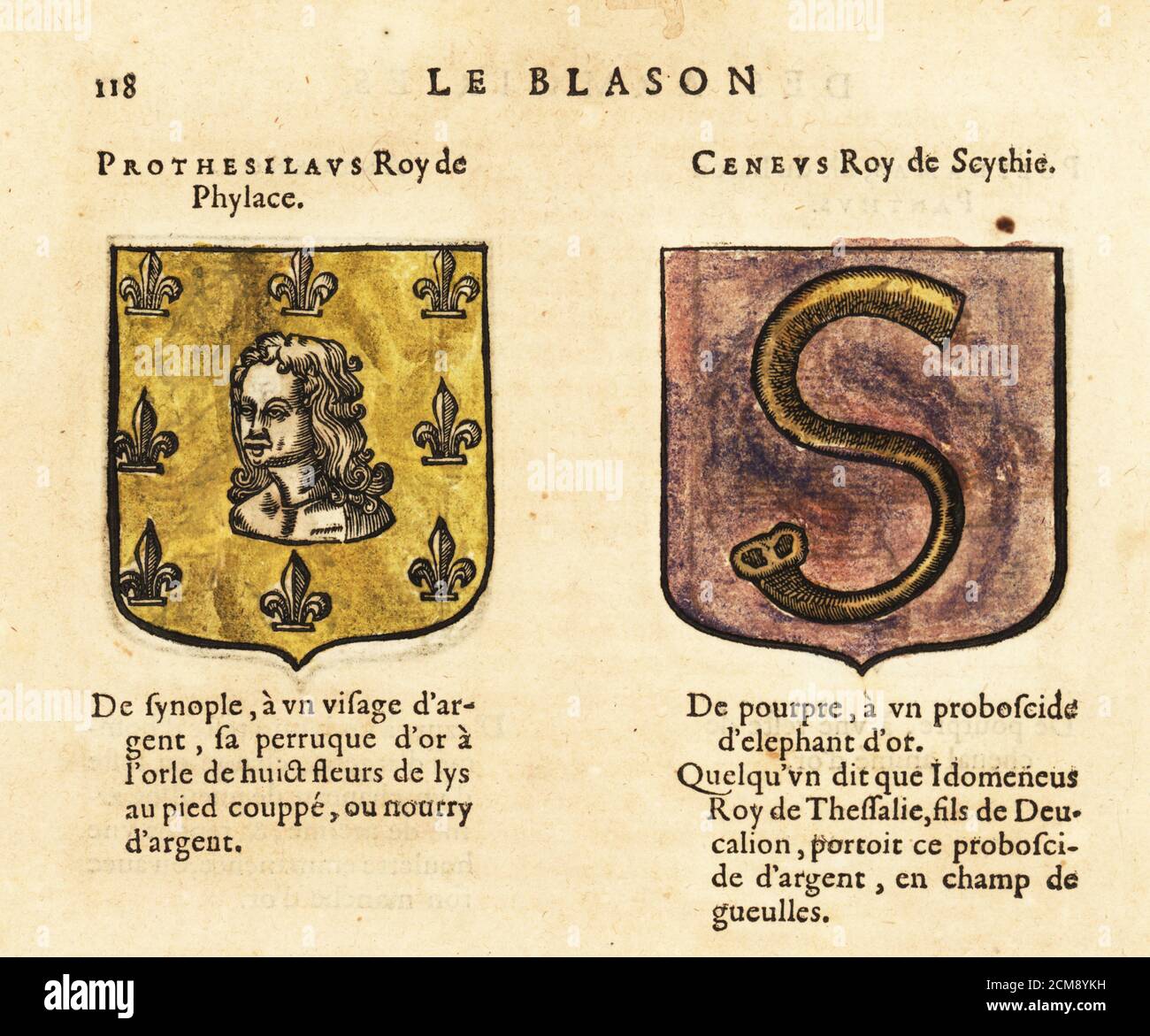 Coat of arms of mythological figures Protesilaus, king of the Phylaceans, and Ceneus, King of Scythia. PROTHESILAUS Roy de Phylace, CENEUS Roy de Scythie. Handcoloured woodblock engraving from Hierosme de Bara’s Le Blason des Armoiries, Chez Rolet Boutonne, Paris, 1628 Stock Photohttps://www.alamy.com/image-license-details/?v=1https://www.alamy.com/coat-of-arms-of-mythological-figures-protesilaus-king-of-the-phylaceans-and-ceneus-king-of-scythia-prothesilaus-roy-de-phylace-ceneus-roy-de-scythie-handcoloured-woodblock-engraving-from-hierosme-de-baras-le-blason-des-armoiries-chez-rolet-boutonne-paris-1628-image373908181.html
Coat of arms of mythological figures Protesilaus, king of the Phylaceans, and Ceneus, King of Scythia. PROTHESILAUS Roy de Phylace, CENEUS Roy de Scythie. Handcoloured woodblock engraving from Hierosme de Bara’s Le Blason des Armoiries, Chez Rolet Boutonne, Paris, 1628 Stock Photohttps://www.alamy.com/image-license-details/?v=1https://www.alamy.com/coat-of-arms-of-mythological-figures-protesilaus-king-of-the-phylaceans-and-ceneus-king-of-scythia-prothesilaus-roy-de-phylace-ceneus-roy-de-scythie-handcoloured-woodblock-engraving-from-hierosme-de-baras-le-blason-des-armoiries-chez-rolet-boutonne-paris-1628-image373908181.htmlRM2CM8YKH–Coat of arms of mythological figures Protesilaus, king of the Phylaceans, and Ceneus, King of Scythia. PROTHESILAUS Roy de Phylace, CENEUS Roy de Scythie. Handcoloured woodblock engraving from Hierosme de Bara’s Le Blason des Armoiries, Chez Rolet Boutonne, Paris, 1628
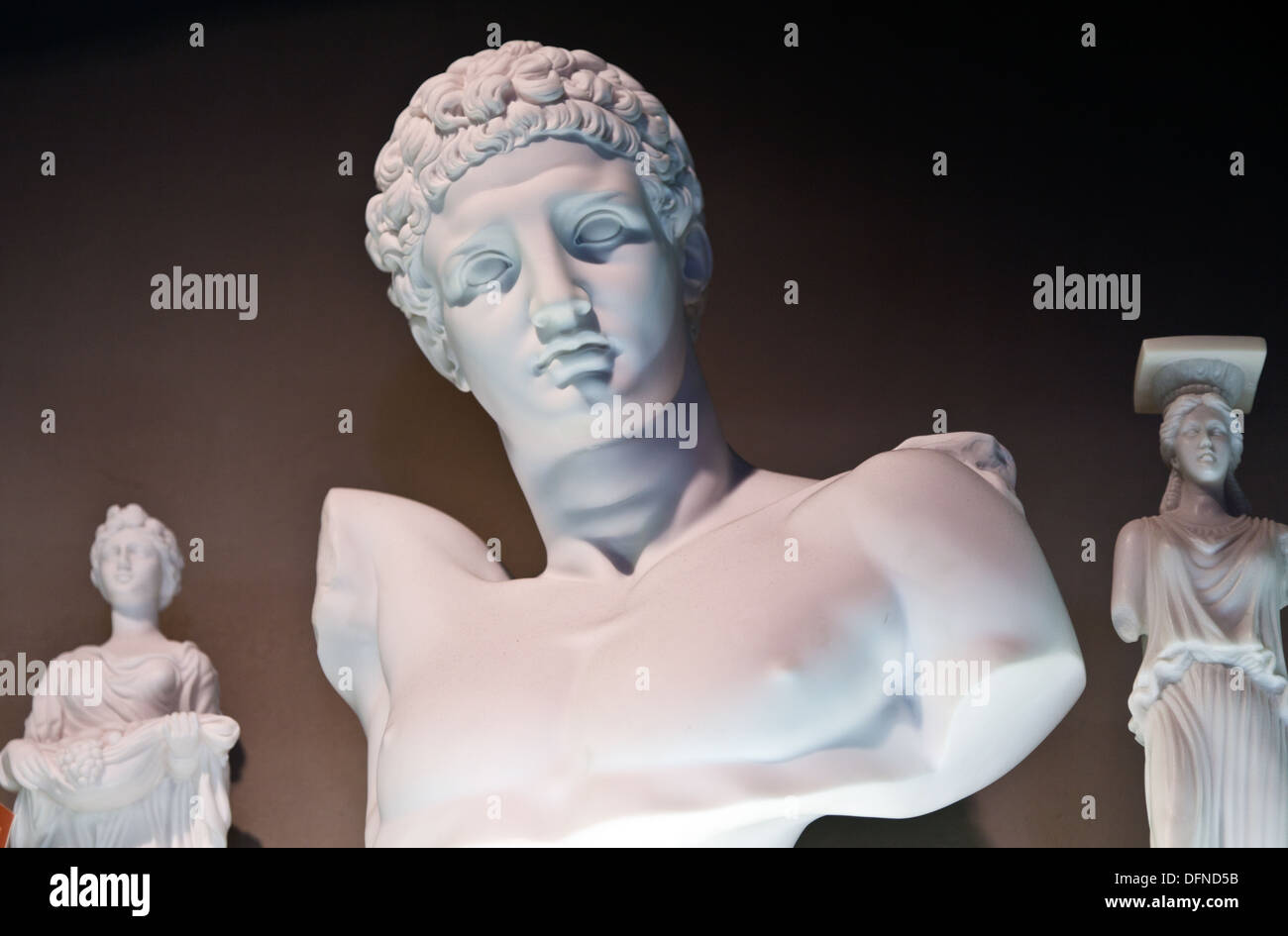 Classical Greek Marble Statues Lindos Greece Stock Photohttps://www.alamy.com/image-license-details/?v=1https://www.alamy.com/classical-greek-marble-statues-lindos-greece-image61322279.html
Classical Greek Marble Statues Lindos Greece Stock Photohttps://www.alamy.com/image-license-details/?v=1https://www.alamy.com/classical-greek-marble-statues-lindos-greece-image61322279.htmlRMDFND5B–Classical Greek Marble Statues Lindos Greece
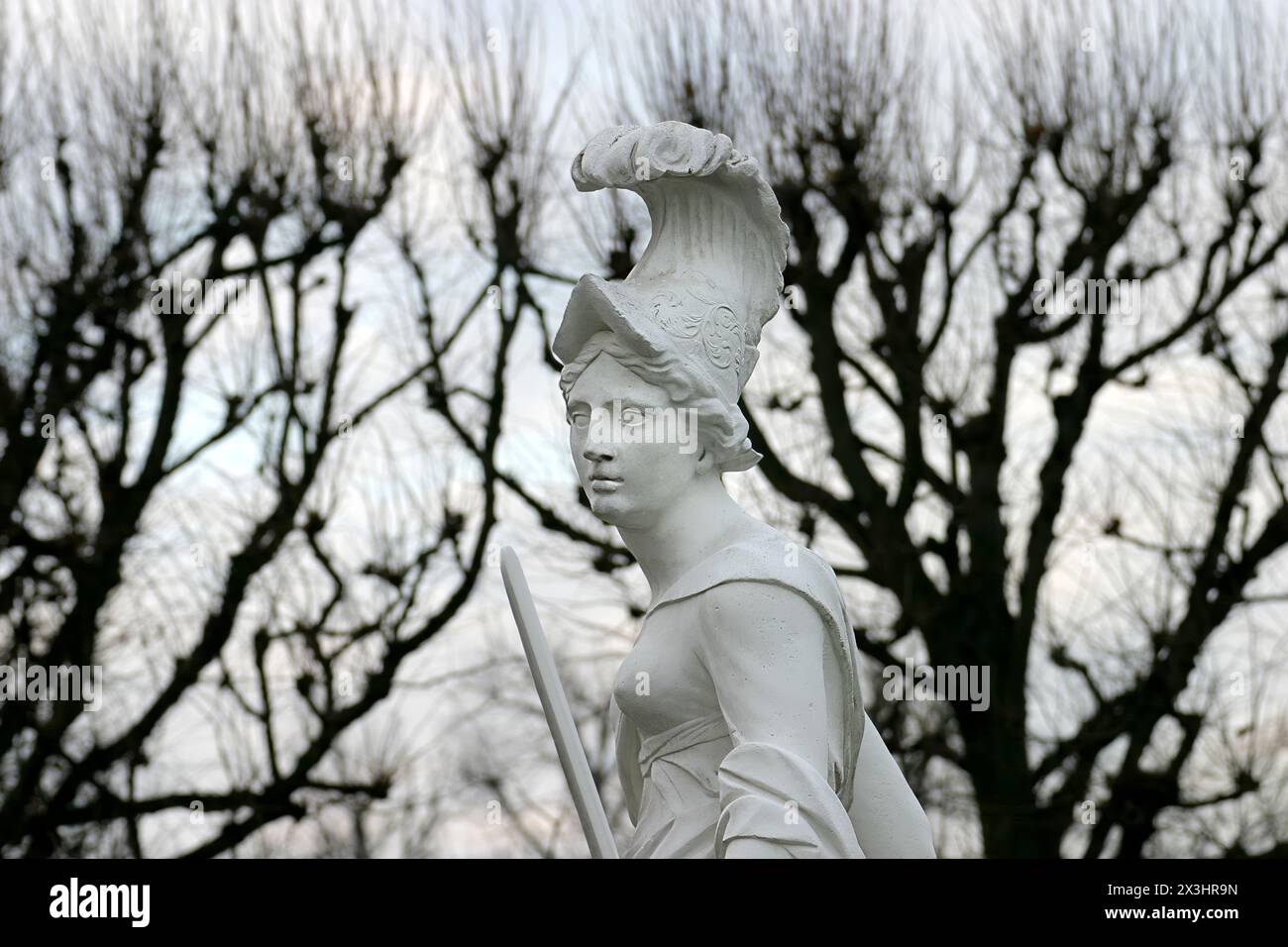 Greek sculpture, Grosser Garten garden in the Herrenhaeuser Gaerten gardens, Herrenhausen, Hanover, Lower Saxony, Germany, Europe Stock Photohttps://www.alamy.com/image-license-details/?v=1https://www.alamy.com/greek-sculpture-grosser-garten-garden-in-the-herrenhaeuser-gaerten-gardens-herrenhausen-hanover-lower-saxony-germany-europe-image604598337.html
Greek sculpture, Grosser Garten garden in the Herrenhaeuser Gaerten gardens, Herrenhausen, Hanover, Lower Saxony, Germany, Europe Stock Photohttps://www.alamy.com/image-license-details/?v=1https://www.alamy.com/greek-sculpture-grosser-garten-garden-in-the-herrenhaeuser-gaerten-gardens-herrenhausen-hanover-lower-saxony-germany-europe-image604598337.htmlRM2X3HR9N–Greek sculpture, Grosser Garten garden in the Herrenhaeuser Gaerten gardens, Herrenhausen, Hanover, Lower Saxony, Germany, Europe
 1990s TYMPANUM PEDIMENT CONTAINING MYTHOLOGICAL GREEK FIGURES INSTALLED IN 1932 MUSEUM OF ART PHILADELPHIA PA USA - 183039 NET002 HARS OLD FASHIONED Stock Photohttps://www.alamy.com/image-license-details/?v=1https://www.alamy.com/1990s-tympanum-pediment-containing-mythological-greek-figures-installed-in-1932-museum-of-art-philadelphia-pa-usa-183039-net002-hars-old-fashioned-image469678279.html
1990s TYMPANUM PEDIMENT CONTAINING MYTHOLOGICAL GREEK FIGURES INSTALLED IN 1932 MUSEUM OF ART PHILADELPHIA PA USA - 183039 NET002 HARS OLD FASHIONED Stock Photohttps://www.alamy.com/image-license-details/?v=1https://www.alamy.com/1990s-tympanum-pediment-containing-mythological-greek-figures-installed-in-1932-museum-of-art-philadelphia-pa-usa-183039-net002-hars-old-fashioned-image469678279.htmlRM2J83KC7–1990s TYMPANUM PEDIMENT CONTAINING MYTHOLOGICAL GREEK FIGURES INSTALLED IN 1932 MUSEUM OF ART PHILADELPHIA PA USA - 183039 NET002 HARS OLD FASHIONED
 Sculpture of Triton and Mermaid by Carlos Espino (Neptune and the Nereid) on the Puerto Vallarta Malecon w/ woman in background wearing colorful dress Stock Photohttps://www.alamy.com/image-license-details/?v=1https://www.alamy.com/stock-photo-sculpture-of-triton-and-mermaid-by-carlos-espino-neptune-and-the-nereid-135831410.html
Sculpture of Triton and Mermaid by Carlos Espino (Neptune and the Nereid) on the Puerto Vallarta Malecon w/ woman in background wearing colorful dress Stock Photohttps://www.alamy.com/image-license-details/?v=1https://www.alamy.com/stock-photo-sculpture-of-triton-and-mermaid-by-carlos-espino-neptune-and-the-nereid-135831410.htmlRMHTYJ9P–Sculpture of Triton and Mermaid by Carlos Espino (Neptune and the Nereid) on the Puerto Vallarta Malecon w/ woman in background wearing colorful dress
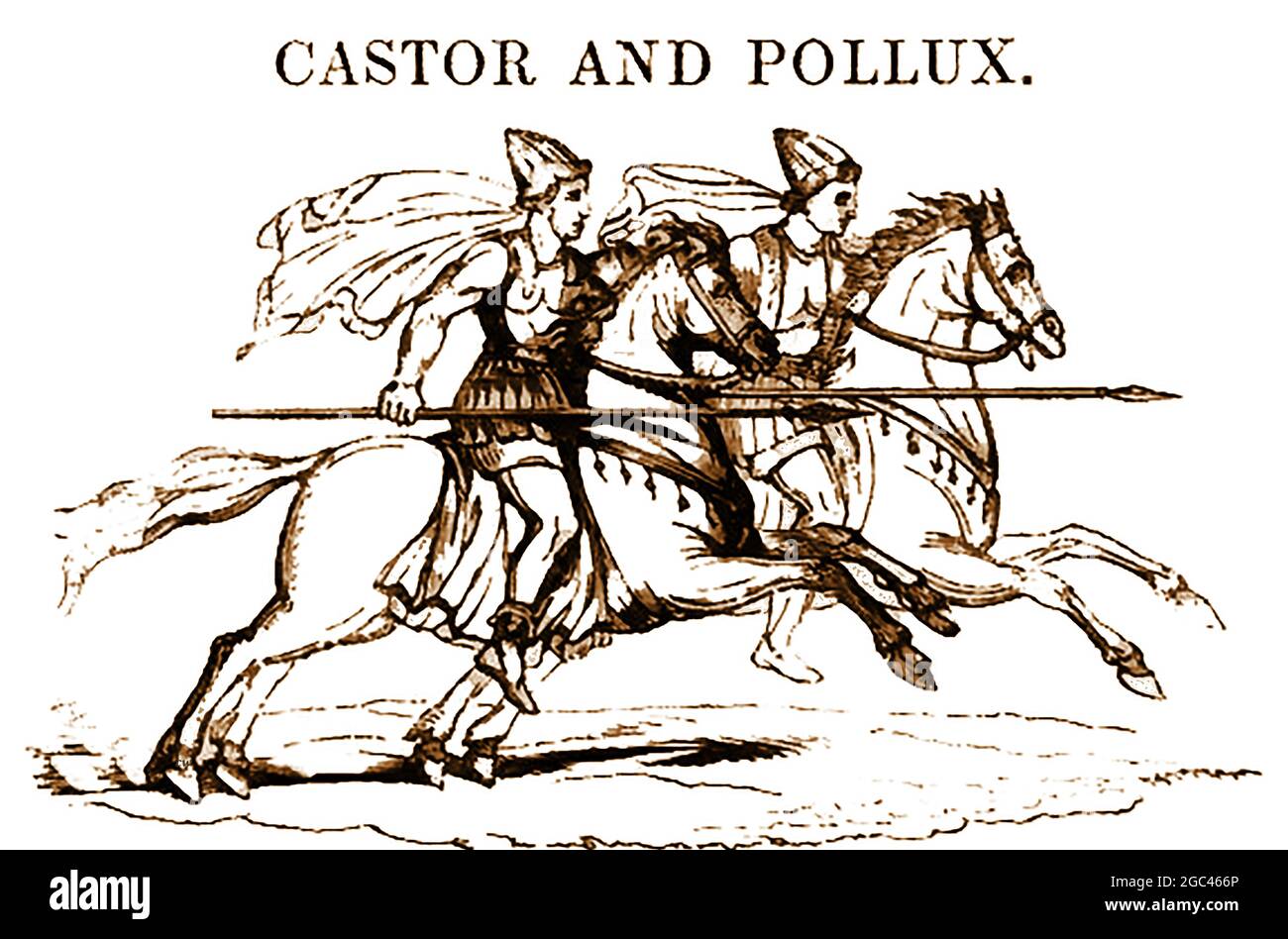 An 1839 depiction of the mythological figures Castor and Pollux (Polydeukes) on horseback; known as a pair as twin half-brothers in Greek and Roman mythology where they are known together as the Dioscuri and sometimes as The Two Gods, Gemini, Castores , Tyndarids / Tyndaridae or The Horse Twins. Old fashioned sailors considered the pair as patron saints in the form of St Elmo's Fire and they have horsemanship associations as the divine Indo-European horse twins / Divine horse twins Stock Photohttps://www.alamy.com/image-license-details/?v=1https://www.alamy.com/an-1839-depiction-of-the-mythological-figures-castor-and-pollux-polydeukes-on-horseback-known-as-a-pair-as-twin-half-brothers-in-greek-and-roman-mythology-where-they-are-known-together-as-the-dioscuri-and-sometimes-as-the-two-gods-gemini-castores-tyndarids-tyndaridae-or-the-horse-twins-old-fashioned-sailors-considered-the-pair-as-patron-saints-in-the-form-of-st-elmos-fire-and-they-have-horsemanship-associations-as-the-divine-indo-european-horse-twins-divine-horse-twins-image437727774.html
An 1839 depiction of the mythological figures Castor and Pollux (Polydeukes) on horseback; known as a pair as twin half-brothers in Greek and Roman mythology where they are known together as the Dioscuri and sometimes as The Two Gods, Gemini, Castores , Tyndarids / Tyndaridae or The Horse Twins. Old fashioned sailors considered the pair as patron saints in the form of St Elmo's Fire and they have horsemanship associations as the divine Indo-European horse twins / Divine horse twins Stock Photohttps://www.alamy.com/image-license-details/?v=1https://www.alamy.com/an-1839-depiction-of-the-mythological-figures-castor-and-pollux-polydeukes-on-horseback-known-as-a-pair-as-twin-half-brothers-in-greek-and-roman-mythology-where-they-are-known-together-as-the-dioscuri-and-sometimes-as-the-two-gods-gemini-castores-tyndarids-tyndaridae-or-the-horse-twins-old-fashioned-sailors-considered-the-pair-as-patron-saints-in-the-form-of-st-elmos-fire-and-they-have-horsemanship-associations-as-the-divine-indo-european-horse-twins-divine-horse-twins-image437727774.htmlRM2GC466P–An 1839 depiction of the mythological figures Castor and Pollux (Polydeukes) on horseback; known as a pair as twin half-brothers in Greek and Roman mythology where they are known together as the Dioscuri and sometimes as The Two Gods, Gemini, Castores , Tyndarids / Tyndaridae or The Horse Twins. Old fashioned sailors considered the pair as patron saints in the form of St Elmo's Fire and they have horsemanship associations as the divine Indo-European horse twins / Divine horse twins
 'Echo and Narcissus' Oil painting by John William Waterhouse (1849-1917) showing the mythological figures of Echo and Narcissus in a woodland setting. Narcissus gazes at his reflection in a stream while Echo watches longingly from across the water. Stock Photohttps://www.alamy.com/image-license-details/?v=1https://www.alamy.com/echo-and-narcissus-oil-painting-by-john-william-waterhouse-1849-1917-showing-the-mythological-figures-of-echo-and-narcissus-in-a-woodland-setting-narcissus-gazes-at-his-reflection-in-a-stream-while-echo-watches-longingly-from-across-the-water-image629298671.html
'Echo and Narcissus' Oil painting by John William Waterhouse (1849-1917) showing the mythological figures of Echo and Narcissus in a woodland setting. Narcissus gazes at his reflection in a stream while Echo watches longingly from across the water. Stock Photohttps://www.alamy.com/image-license-details/?v=1https://www.alamy.com/echo-and-narcissus-oil-painting-by-john-william-waterhouse-1849-1917-showing-the-mythological-figures-of-echo-and-narcissus-in-a-woodland-setting-narcissus-gazes-at-his-reflection-in-a-stream-while-echo-watches-longingly-from-across-the-water-image629298671.htmlRM2YFR0TF–'Echo and Narcissus' Oil painting by John William Waterhouse (1849-1917) showing the mythological figures of Echo and Narcissus in a woodland setting. Narcissus gazes at his reflection in a stream while Echo watches longingly from across the water.
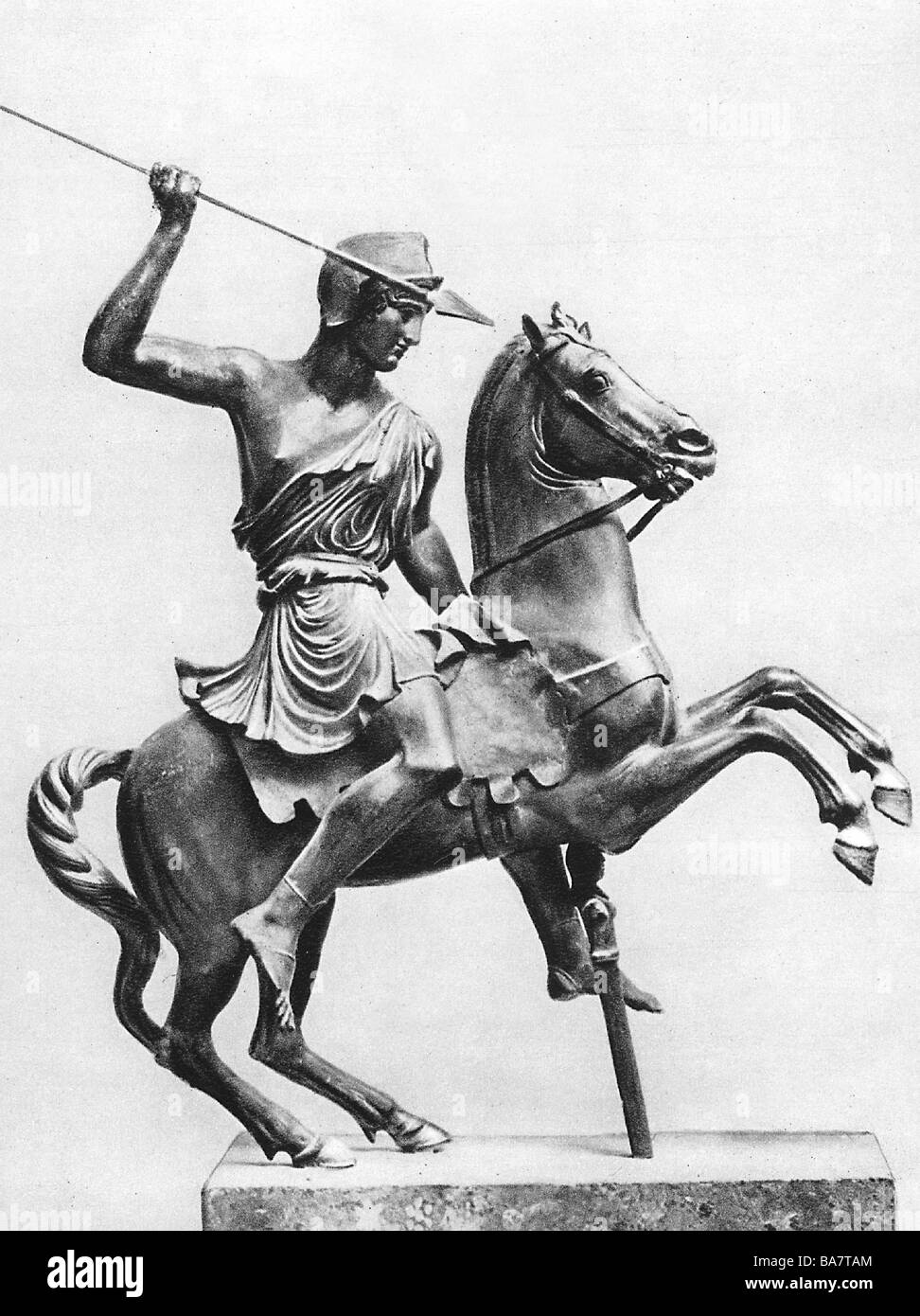 Amazons, Greek mythological figures, 'Die sprungfertige Amazone', full length, sitting on horse, bronce statue by anonymous, 1st century, National Museum Naples, Stock Photohttps://www.alamy.com/image-license-details/?v=1https://www.alamy.com/stock-photo-amazons-greek-mythological-figures-die-sprungfertige-amazone-full-23529708.html
Amazons, Greek mythological figures, 'Die sprungfertige Amazone', full length, sitting on horse, bronce statue by anonymous, 1st century, National Museum Naples, Stock Photohttps://www.alamy.com/image-license-details/?v=1https://www.alamy.com/stock-photo-amazons-greek-mythological-figures-die-sprungfertige-amazone-full-23529708.htmlRMBA7TAM–Amazons, Greek mythological figures, 'Die sprungfertige Amazone', full length, sitting on horse, bronce statue by anonymous, 1st century, National Museum Naples,
 Art inspired by Terracotta Nolan neck-amphora (jar), Classical, ca. 440–430 B.C., Greek, Attic, Terracotta; red-figure, H. 13 1/4 in. (33.7 cm); diameter 6 7/8 in. (17.5 cm), Vases, Obverse, youth with spears pursuing woman, Reverse, woman. Compared with the Achilles Painter whose, Classic works modernized by Artotop with a splash of modernity. Shapes, color and value, eye-catching visual impact on art. Emotions through freedom of artworks in a contemporary way. A timeless message pursuing a wildly creative new direction. Artists turning to the digital medium and creating the Artotop NFT Stock Photohttps://www.alamy.com/image-license-details/?v=1https://www.alamy.com/art-inspired-by-terracotta-nolan-neck-amphora-jar-classical-ca-440430-bc-greek-attic-terracotta-red-figure-h-13-14-in-337-cm-diameter-6-78-in-175-cm-vases-obverse-youth-with-spears-pursuing-woman-reverse-woman-compared-with-the-achilles-painter-whose-classic-works-modernized-by-artotop-with-a-splash-of-modernity-shapes-color-and-value-eye-catching-visual-impact-on-art-emotions-through-freedom-of-artworks-in-a-contemporary-way-a-timeless-message-pursuing-a-wildly-creative-new-direction-artists-turning-to-the-digital-medium-and-creating-the-artotop-nft-image462933191.html
Art inspired by Terracotta Nolan neck-amphora (jar), Classical, ca. 440–430 B.C., Greek, Attic, Terracotta; red-figure, H. 13 1/4 in. (33.7 cm); diameter 6 7/8 in. (17.5 cm), Vases, Obverse, youth with spears pursuing woman, Reverse, woman. Compared with the Achilles Painter whose, Classic works modernized by Artotop with a splash of modernity. Shapes, color and value, eye-catching visual impact on art. Emotions through freedom of artworks in a contemporary way. A timeless message pursuing a wildly creative new direction. Artists turning to the digital medium and creating the Artotop NFT Stock Photohttps://www.alamy.com/image-license-details/?v=1https://www.alamy.com/art-inspired-by-terracotta-nolan-neck-amphora-jar-classical-ca-440430-bc-greek-attic-terracotta-red-figure-h-13-14-in-337-cm-diameter-6-78-in-175-cm-vases-obverse-youth-with-spears-pursuing-woman-reverse-woman-compared-with-the-achilles-painter-whose-classic-works-modernized-by-artotop-with-a-splash-of-modernity-shapes-color-and-value-eye-catching-visual-impact-on-art-emotions-through-freedom-of-artworks-in-a-contemporary-way-a-timeless-message-pursuing-a-wildly-creative-new-direction-artists-turning-to-the-digital-medium-and-creating-the-artotop-nft-image462933191.htmlRF2HW4C07–Art inspired by Terracotta Nolan neck-amphora (jar), Classical, ca. 440–430 B.C., Greek, Attic, Terracotta; red-figure, H. 13 1/4 in. (33.7 cm); diameter 6 7/8 in. (17.5 cm), Vases, Obverse, youth with spears pursuing woman, Reverse, woman. Compared with the Achilles Painter whose, Classic works modernized by Artotop with a splash of modernity. Shapes, color and value, eye-catching visual impact on art. Emotions through freedom of artworks in a contemporary way. A timeless message pursuing a wildly creative new direction. Artists turning to the digital medium and creating the Artotop NFT
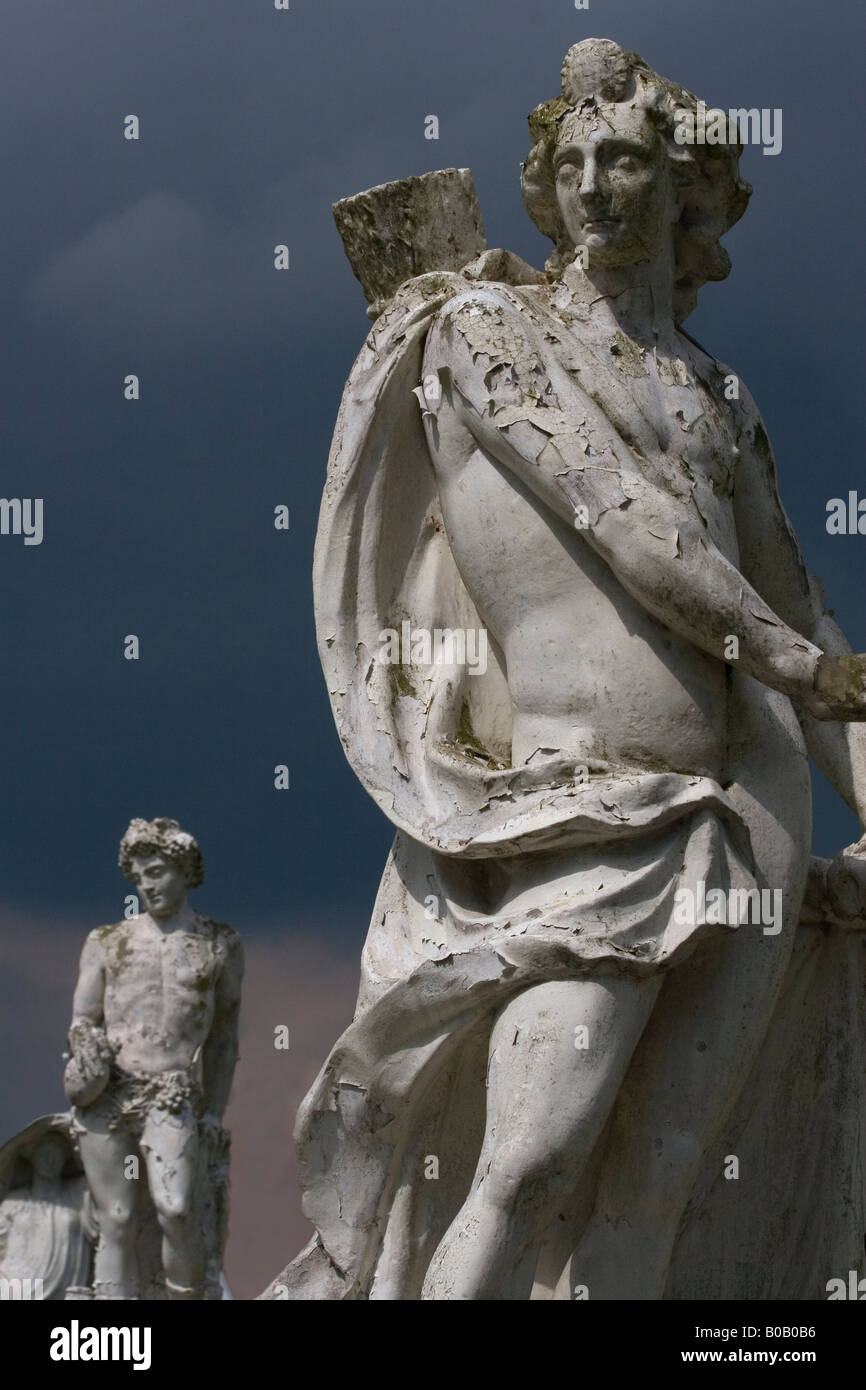 Greek mythological statues Stock Photohttps://www.alamy.com/image-license-details/?v=1https://www.alamy.com/stock-photo-greek-mythological-statues-17452154.html
Greek mythological statues Stock Photohttps://www.alamy.com/image-license-details/?v=1https://www.alamy.com/stock-photo-greek-mythological-statues-17452154.htmlRFB0B0B6–Greek mythological statues
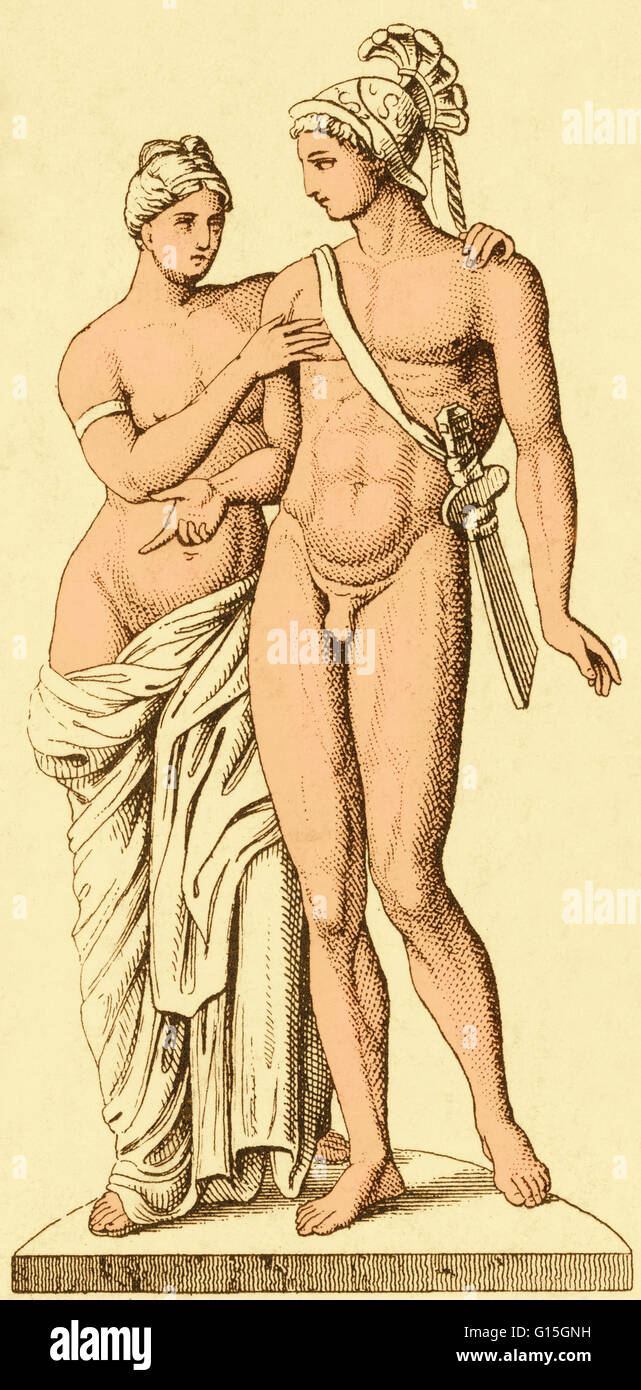 The ancient Greek mythical figures of Aphrodite and Ares (or Venus and Mars, in the Roman pantheon). These are the goddess of love and the god of war, who were lovers. Stock Photohttps://www.alamy.com/image-license-details/?v=1https://www.alamy.com/stock-photo-the-ancient-greek-mythical-figures-of-aphrodite-and-ares-or-venus-103999773.html
The ancient Greek mythical figures of Aphrodite and Ares (or Venus and Mars, in the Roman pantheon). These are the goddess of love and the god of war, who were lovers. Stock Photohttps://www.alamy.com/image-license-details/?v=1https://www.alamy.com/stock-photo-the-ancient-greek-mythical-figures-of-aphrodite-and-ares-or-venus-103999773.htmlRMG15GNH–The ancient Greek mythical figures of Aphrodite and Ares (or Venus and Mars, in the Roman pantheon). These are the goddess of love and the god of war, who were lovers.
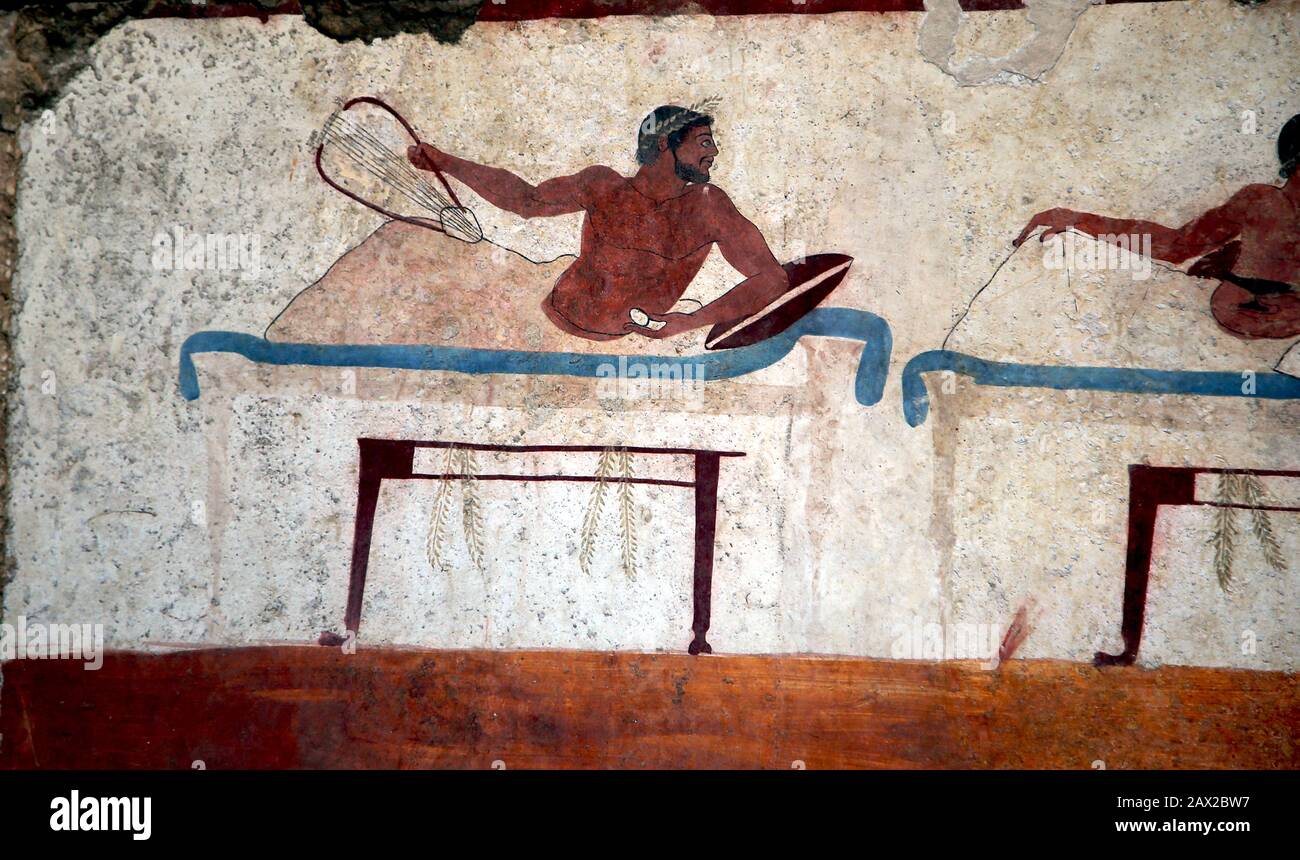 Tomb of the diver,South wall fresco. Scene with men playing a lyre with others drinking wine. 480 BC. Greek Art. Paestum Museum, Italy. Stock Photohttps://www.alamy.com/image-license-details/?v=1https://www.alamy.com/tomb-of-the-diversouth-wall-fresco-scene-with-men-playing-a-lyre-with-others-drinking-wine-480-bc-greek-art-paestum-museum-italy-image343031283.html
Tomb of the diver,South wall fresco. Scene with men playing a lyre with others drinking wine. 480 BC. Greek Art. Paestum Museum, Italy. Stock Photohttps://www.alamy.com/image-license-details/?v=1https://www.alamy.com/tomb-of-the-diversouth-wall-fresco-scene-with-men-playing-a-lyre-with-others-drinking-wine-480-bc-greek-art-paestum-museum-italy-image343031283.htmlRM2AX2BW7–Tomb of the diver,South wall fresco. Scene with men playing a lyre with others drinking wine. 480 BC. Greek Art. Paestum Museum, Italy.
 Statues of mythological figures near the side entrance of the Upper Gardens of the 18th century Peterhof Palace in Saint Petersburg, Russia Stock Photohttps://www.alamy.com/image-license-details/?v=1https://www.alamy.com/stock-photo-statues-of-mythological-figures-near-the-side-entrance-of-the-upper-25325548.html
Statues of mythological figures near the side entrance of the Upper Gardens of the 18th century Peterhof Palace in Saint Petersburg, Russia Stock Photohttps://www.alamy.com/image-license-details/?v=1https://www.alamy.com/stock-photo-statues-of-mythological-figures-near-the-side-entrance-of-the-upper-25325548.htmlRMBD5JYT–Statues of mythological figures near the side entrance of the Upper Gardens of the 18th century Peterhof Palace in Saint Petersburg, Russia
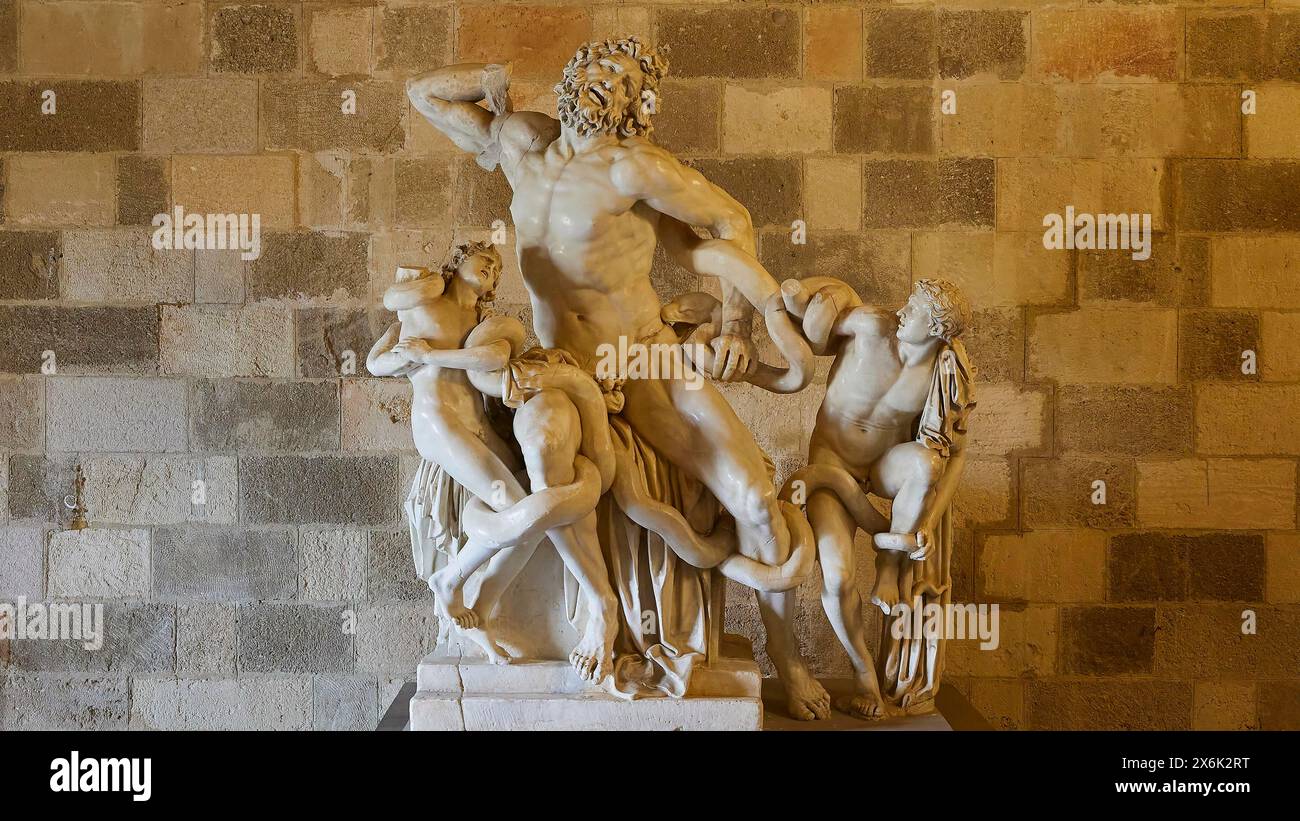 Copy of the Laocoon Group, Dynamic sculpture of a mythological battle scene with several figures, interior view, Grand Master's Palace, Knights' Stock Photohttps://www.alamy.com/image-license-details/?v=1https://www.alamy.com/copy-of-the-laocoon-group-dynamic-sculpture-of-a-mythological-battle-scene-with-several-figures-interior-view-grand-masters-palace-knights-image606470140.html
Copy of the Laocoon Group, Dynamic sculpture of a mythological battle scene with several figures, interior view, Grand Master's Palace, Knights' Stock Photohttps://www.alamy.com/image-license-details/?v=1https://www.alamy.com/copy-of-the-laocoon-group-dynamic-sculpture-of-a-mythological-battle-scene-with-several-figures-interior-view-grand-masters-palace-knights-image606470140.htmlRM2X6K2RT–Copy of the Laocoon Group, Dynamic sculpture of a mythological battle scene with several figures, interior view, Grand Master's Palace, Knights'
 Terracotta Nolan neck-amphora (jar). Culture: Greek, Attic. Dimensions: H. 13 1/4 in. (33.7 cm); diameter 6 7/8 in. (17.5 cm). Date: ca. 440-430 B.C.. Obverse, youth with spears pursuing woman Reverse, woman Compared with the Achilles Painter whose student he was, the Phiale Painter shows a greater predilection for mythological scenes and active figures. The subject depicted here cannot be certainly identified. It may represent the hero Theseus, who engaged in various amorous pursuits as he made his way from Troizen, where he was born, to Athens. Museum: Metropolitan Museum of Art, New Yor Stock Photohttps://www.alamy.com/image-license-details/?v=1https://www.alamy.com/terracotta-nolan-neck-amphora-jar-culture-greek-attic-dimensions-h-13-14-in-337-cm-diameter-6-78-in-175-cm-date-ca-440-430-bc-obverse-youth-with-spears-pursuing-woman-reverse-woman-compared-with-the-achilles-painter-whose-student-he-was-the-phiale-painter-shows-a-greater-predilection-for-mythological-scenes-and-active-figures-the-subject-depicted-here-cannot-be-certainly-identified-it-may-represent-the-hero-theseus-who-engaged-in-various-amorous-pursuits-as-he-made-his-way-from-troizen-where-he-was-born-to-athens-museum-metropolitan-museum-of-art-new-yor-image213107556.html
Terracotta Nolan neck-amphora (jar). Culture: Greek, Attic. Dimensions: H. 13 1/4 in. (33.7 cm); diameter 6 7/8 in. (17.5 cm). Date: ca. 440-430 B.C.. Obverse, youth with spears pursuing woman Reverse, woman Compared with the Achilles Painter whose student he was, the Phiale Painter shows a greater predilection for mythological scenes and active figures. The subject depicted here cannot be certainly identified. It may represent the hero Theseus, who engaged in various amorous pursuits as he made his way from Troizen, where he was born, to Athens. Museum: Metropolitan Museum of Art, New Yor Stock Photohttps://www.alamy.com/image-license-details/?v=1https://www.alamy.com/terracotta-nolan-neck-amphora-jar-culture-greek-attic-dimensions-h-13-14-in-337-cm-diameter-6-78-in-175-cm-date-ca-440-430-bc-obverse-youth-with-spears-pursuing-woman-reverse-woman-compared-with-the-achilles-painter-whose-student-he-was-the-phiale-painter-shows-a-greater-predilection-for-mythological-scenes-and-active-figures-the-subject-depicted-here-cannot-be-certainly-identified-it-may-represent-the-hero-theseus-who-engaged-in-various-amorous-pursuits-as-he-made-his-way-from-troizen-where-he-was-born-to-athens-museum-metropolitan-museum-of-art-new-yor-image213107556.htmlRMPAKTT4–Terracotta Nolan neck-amphora (jar). Culture: Greek, Attic. Dimensions: H. 13 1/4 in. (33.7 cm); diameter 6 7/8 in. (17.5 cm). Date: ca. 440-430 B.C.. Obverse, youth with spears pursuing woman Reverse, woman Compared with the Achilles Painter whose student he was, the Phiale Painter shows a greater predilection for mythological scenes and active figures. The subject depicted here cannot be certainly identified. It may represent the hero Theseus, who engaged in various amorous pursuits as he made his way from Troizen, where he was born, to Athens. Museum: Metropolitan Museum of Art, New Yor
 The Alexandra Vase, presented to the Princess of Wales by the Danish residents in Great Britain, 1864. Wedding gift '...designed and executed in oxydised silver by Mr. Ies Barkentin, himself an Anglo-Dane. The form of the vase, which with its base is 3 ft. 6 in. in height, has been studied from the purest Greek models; but the ornamentation is Scandinavian throughout, and the figures in the various groups are all illustrative of either the mythology or the history of ancient Denmark. Upon the body of the vase and its neck and handles, the most characteristic of the mythological tales of the No Stock Photohttps://www.alamy.com/image-license-details/?v=1https://www.alamy.com/the-alexandra-vase-presented-to-the-princess-of-wales-by-the-danish-residents-in-great-britain-1864-wedding-gift-designed-and-executed-in-oxydised-silver-by-mr-ies-barkentin-himself-an-anglo-dane-the-form-of-the-vase-which-with-its-base-is-3-ft-6-in-in-height-has-been-studied-from-the-purest-greek-models-but-the-ornamentation-is-scandinavian-throughout-and-the-figures-in-the-various-groups-are-all-illustrative-of-either-the-mythology-or-the-history-of-ancient-denmark-upon-the-body-of-the-vase-and-its-neck-and-handles-the-most-characteristic-of-the-mythological-tales-of-the-no-image603633415.html
The Alexandra Vase, presented to the Princess of Wales by the Danish residents in Great Britain, 1864. Wedding gift '...designed and executed in oxydised silver by Mr. Ies Barkentin, himself an Anglo-Dane. The form of the vase, which with its base is 3 ft. 6 in. in height, has been studied from the purest Greek models; but the ornamentation is Scandinavian throughout, and the figures in the various groups are all illustrative of either the mythology or the history of ancient Denmark. Upon the body of the vase and its neck and handles, the most characteristic of the mythological tales of the No Stock Photohttps://www.alamy.com/image-license-details/?v=1https://www.alamy.com/the-alexandra-vase-presented-to-the-princess-of-wales-by-the-danish-residents-in-great-britain-1864-wedding-gift-designed-and-executed-in-oxydised-silver-by-mr-ies-barkentin-himself-an-anglo-dane-the-form-of-the-vase-which-with-its-base-is-3-ft-6-in-in-height-has-been-studied-from-the-purest-greek-models-but-the-ornamentation-is-scandinavian-throughout-and-the-figures-in-the-various-groups-are-all-illustrative-of-either-the-mythology-or-the-history-of-ancient-denmark-upon-the-body-of-the-vase-and-its-neck-and-handles-the-most-characteristic-of-the-mythological-tales-of-the-no-image603633415.htmlRM2X21TG7–The Alexandra Vase, presented to the Princess of Wales by the Danish residents in Great Britain, 1864. Wedding gift '...designed and executed in oxydised silver by Mr. Ies Barkentin, himself an Anglo-Dane. The form of the vase, which with its base is 3 ft. 6 in. in height, has been studied from the purest Greek models; but the ornamentation is Scandinavian throughout, and the figures in the various groups are all illustrative of either the mythology or the history of ancient Denmark. Upon the body of the vase and its neck and handles, the most characteristic of the mythological tales of the No
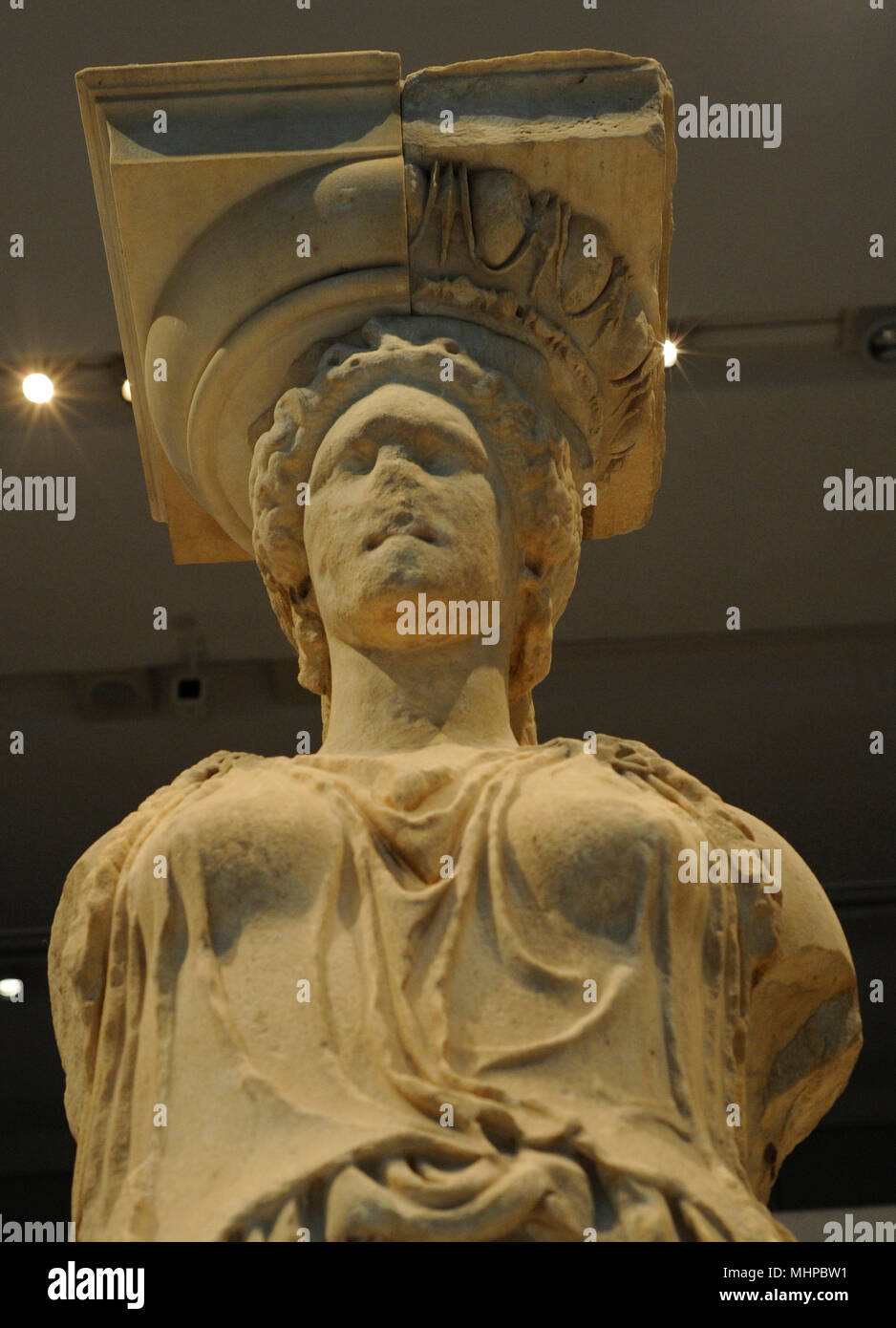 Greek art. The Caryatid Porch of the Erechtheion. Draped female figures as supporting columns. Detail. Acropolis of Athens, 421-407 BC. Greece. Acropolis Museum. Athens. Greece. Stock Photohttps://www.alamy.com/image-license-details/?v=1https://www.alamy.com/greek-art-the-caryatid-porch-of-the-erechtheion-draped-female-figures-as-supporting-columns-detail-acropolis-of-athens-421-407-bc-greece-acropolis-museum-athens-greece-image183045101.html
Greek art. The Caryatid Porch of the Erechtheion. Draped female figures as supporting columns. Detail. Acropolis of Athens, 421-407 BC. Greece. Acropolis Museum. Athens. Greece. Stock Photohttps://www.alamy.com/image-license-details/?v=1https://www.alamy.com/greek-art-the-caryatid-porch-of-the-erechtheion-draped-female-figures-as-supporting-columns-detail-acropolis-of-athens-421-407-bc-greece-acropolis-museum-athens-greece-image183045101.htmlRMMHPBW1–Greek art. The Caryatid Porch of the Erechtheion. Draped female figures as supporting columns. Detail. Acropolis of Athens, 421-407 BC. Greece. Acropolis Museum. Athens. Greece.
 ATHENS, Greece — Black-on-white Greek pottery, featuring the distinctive white-ground technique, is displayed at the National Archaeological Museum in Athens. This style of pottery, characterized by black figures and designs painted on a white slip, was prominent in ancient Greece from the 6th to 5th centuries BC. The museum's collection showcases various pottery forms, including lekythoi, kraters, and amphorae, adorned with mythological scenes, daily life depictions, and geometric patterns, highlighting the artistic achievements and cultural heritage of ancient Greece. Stock Photohttps://www.alamy.com/image-license-details/?v=1https://www.alamy.com/athens-greece-black-on-white-greek-pottery-featuring-the-distinctive-white-ground-technique-is-displayed-at-the-national-archaeological-museum-in-athens-this-style-of-pottery-characterized-by-black-figures-and-designs-painted-on-a-white-slip-was-prominent-in-ancient-greece-from-the-6th-to-5th-centuries-bc-the-museums-collection-showcases-various-pottery-forms-including-lekythoi-kraters-and-amphorae-adorned-with-mythological-scenes-daily-life-depictions-and-geometric-patterns-highlighting-the-artistic-achievements-and-cultural-heritage-of-ancient-greece-image615726062.html
ATHENS, Greece — Black-on-white Greek pottery, featuring the distinctive white-ground technique, is displayed at the National Archaeological Museum in Athens. This style of pottery, characterized by black figures and designs painted on a white slip, was prominent in ancient Greece from the 6th to 5th centuries BC. The museum's collection showcases various pottery forms, including lekythoi, kraters, and amphorae, adorned with mythological scenes, daily life depictions, and geometric patterns, highlighting the artistic achievements and cultural heritage of ancient Greece. Stock Photohttps://www.alamy.com/image-license-details/?v=1https://www.alamy.com/athens-greece-black-on-white-greek-pottery-featuring-the-distinctive-white-ground-technique-is-displayed-at-the-national-archaeological-museum-in-athens-this-style-of-pottery-characterized-by-black-figures-and-designs-painted-on-a-white-slip-was-prominent-in-ancient-greece-from-the-6th-to-5th-centuries-bc-the-museums-collection-showcases-various-pottery-forms-including-lekythoi-kraters-and-amphorae-adorned-with-mythological-scenes-daily-life-depictions-and-geometric-patterns-highlighting-the-artistic-achievements-and-cultural-heritage-of-ancient-greece-image615726062.htmlRM2XNMMTE–ATHENS, Greece — Black-on-white Greek pottery, featuring the distinctive white-ground technique, is displayed at the National Archaeological Museum in Athens. This style of pottery, characterized by black figures and designs painted on a white slip, was prominent in ancient Greece from the 6th to 5th centuries BC. The museum's collection showcases various pottery forms, including lekythoi, kraters, and amphorae, adorned with mythological scenes, daily life depictions, and geometric patterns, highlighting the artistic achievements and cultural heritage of ancient Greece.
 Bronze Equestrian of the Dioscuri, mythological twins, Castor & Pollux, outside the Royal Palace in Turin, Italy. Stock Photohttps://www.alamy.com/image-license-details/?v=1https://www.alamy.com/stock-image-bronze-equestrian-of-the-dioscuri-mythological-twins-castor-pollux-164559416.html
Bronze Equestrian of the Dioscuri, mythological twins, Castor & Pollux, outside the Royal Palace in Turin, Italy. Stock Photohttps://www.alamy.com/image-license-details/?v=1https://www.alamy.com/stock-image-bronze-equestrian-of-the-dioscuri-mythological-twins-castor-pollux-164559416.htmlRMKFM960–Bronze Equestrian of the Dioscuri, mythological twins, Castor & Pollux, outside the Royal Palace in Turin, Italy.
 ATHENS, Greece — Black-on-white Greek pottery, featuring the distinctive white-ground technique, is displayed at the National Archaeological Museum in Athens. This style of pottery, characterized by black figures and designs painted on a white slip, was prominent in ancient Greece from the 6th to 5th centuries BC. The museum's collection showcases various pottery forms, including lekythoi, kraters, and amphorae, adorned with mythological scenes, daily life depictions, and geometric patterns, highlighting the artistic achievements and cultural heritage of ancient Greece. Stock Photohttps://www.alamy.com/image-license-details/?v=1https://www.alamy.com/athens-greece-black-on-white-greek-pottery-featuring-the-distinctive-white-ground-technique-is-displayed-at-the-national-archaeological-museum-in-athens-this-style-of-pottery-characterized-by-black-figures-and-designs-painted-on-a-white-slip-was-prominent-in-ancient-greece-from-the-6th-to-5th-centuries-bc-the-museums-collection-showcases-various-pottery-forms-including-lekythoi-kraters-and-amphorae-adorned-with-mythological-scenes-daily-life-depictions-and-geometric-patterns-highlighting-the-artistic-achievements-and-cultural-heritage-of-ancient-greece-image615729898.html
ATHENS, Greece — Black-on-white Greek pottery, featuring the distinctive white-ground technique, is displayed at the National Archaeological Museum in Athens. This style of pottery, characterized by black figures and designs painted on a white slip, was prominent in ancient Greece from the 6th to 5th centuries BC. The museum's collection showcases various pottery forms, including lekythoi, kraters, and amphorae, adorned with mythological scenes, daily life depictions, and geometric patterns, highlighting the artistic achievements and cultural heritage of ancient Greece. Stock Photohttps://www.alamy.com/image-license-details/?v=1https://www.alamy.com/athens-greece-black-on-white-greek-pottery-featuring-the-distinctive-white-ground-technique-is-displayed-at-the-national-archaeological-museum-in-athens-this-style-of-pottery-characterized-by-black-figures-and-designs-painted-on-a-white-slip-was-prominent-in-ancient-greece-from-the-6th-to-5th-centuries-bc-the-museums-collection-showcases-various-pottery-forms-including-lekythoi-kraters-and-amphorae-adorned-with-mythological-scenes-daily-life-depictions-and-geometric-patterns-highlighting-the-artistic-achievements-and-cultural-heritage-of-ancient-greece-image615729898.htmlRM2XNMWNE–ATHENS, Greece — Black-on-white Greek pottery, featuring the distinctive white-ground technique, is displayed at the National Archaeological Museum in Athens. This style of pottery, characterized by black figures and designs painted on a white slip, was prominent in ancient Greece from the 6th to 5th centuries BC. The museum's collection showcases various pottery forms, including lekythoi, kraters, and amphorae, adorned with mythological scenes, daily life depictions, and geometric patterns, highlighting the artistic achievements and cultural heritage of ancient Greece.
 Imaginary coats of arms of mythological figures Eurypylus of Mysia, nephew of King Priam of Troy, with serpent-tailed lion, and Diomedes, King of Aetolia, with blue peacock. EURYPILUS de Mysie neueu du Roy PRIAM, DIOMEDES Roy d'Aetolie. Handcoloured woodblock engraving from Hierosme de Bara’s Le Blason des Armoiries, Chez Rolet Boutonne, Paris, 1628 Stock Photohttps://www.alamy.com/image-license-details/?v=1https://www.alamy.com/imaginary-coats-of-arms-of-mythological-figures-eurypylus-of-mysia-nephew-of-king-priam-of-troy-with-serpent-tailed-lion-and-diomedes-king-of-aetolia-with-blue-peacock-eurypilus-de-mysie-neueu-du-roy-priam-diomedes-roy-daetolie-handcoloured-woodblock-engraving-from-hierosme-de-baras-le-blason-des-armoiries-chez-rolet-boutonne-paris-1628-image375411893.html
Imaginary coats of arms of mythological figures Eurypylus of Mysia, nephew of King Priam of Troy, with serpent-tailed lion, and Diomedes, King of Aetolia, with blue peacock. EURYPILUS de Mysie neueu du Roy PRIAM, DIOMEDES Roy d'Aetolie. Handcoloured woodblock engraving from Hierosme de Bara’s Le Blason des Armoiries, Chez Rolet Boutonne, Paris, 1628 Stock Photohttps://www.alamy.com/image-license-details/?v=1https://www.alamy.com/imaginary-coats-of-arms-of-mythological-figures-eurypylus-of-mysia-nephew-of-king-priam-of-troy-with-serpent-tailed-lion-and-diomedes-king-of-aetolia-with-blue-peacock-eurypilus-de-mysie-neueu-du-roy-priam-diomedes-roy-daetolie-handcoloured-woodblock-engraving-from-hierosme-de-baras-le-blason-des-armoiries-chez-rolet-boutonne-paris-1628-image375411893.htmlRM2CPNDKH–Imaginary coats of arms of mythological figures Eurypylus of Mysia, nephew of King Priam of Troy, with serpent-tailed lion, and Diomedes, King of Aetolia, with blue peacock. EURYPILUS de Mysie neueu du Roy PRIAM, DIOMEDES Roy d'Aetolie. Handcoloured woodblock engraving from Hierosme de Bara’s Le Blason des Armoiries, Chez Rolet Boutonne, Paris, 1628
 Heads of gods and mythological figures on top of the mountain of the gods with views of the surrounding peaks Stock Photohttps://www.alamy.com/image-license-details/?v=1https://www.alamy.com/heads-of-gods-and-mythological-figures-on-top-of-the-mountain-of-the-gods-with-views-of-the-surrounding-peaks-image449612858.html
Heads of gods and mythological figures on top of the mountain of the gods with views of the surrounding peaks Stock Photohttps://www.alamy.com/image-license-details/?v=1https://www.alamy.com/heads-of-gods-and-mythological-figures-on-top-of-the-mountain-of-the-gods-with-views-of-the-surrounding-peaks-image449612858.htmlRF2H3DHP2–Heads of gods and mythological figures on top of the mountain of the gods with views of the surrounding peaks
 Ancient vase in the British Museum. Vases in red clay with black designs of mythological figures. Handcoloured copperplate engraving by Henry Moses from A Collection of Antique Vases, Altars, etc., London, 1814. Stock Photohttps://www.alamy.com/image-license-details/?v=1https://www.alamy.com/stock-image-ancient-vase-in-the-british-museum-vases-in-red-clay-with-black-designs-162838782.html
Ancient vase in the British Museum. Vases in red clay with black designs of mythological figures. Handcoloured copperplate engraving by Henry Moses from A Collection of Antique Vases, Altars, etc., London, 1814. Stock Photohttps://www.alamy.com/image-license-details/?v=1https://www.alamy.com/stock-image-ancient-vase-in-the-british-museum-vases-in-red-clay-with-black-designs-162838782.htmlRMKCWXEP–Ancient vase in the British Museum. Vases in red clay with black designs of mythological figures. Handcoloured copperplate engraving by Henry Moses from A Collection of Antique Vases, Altars, etc., London, 1814.
 Artemis and Iphigenia, statue group. Rome, 1st century AD. Marble. Unknown artist. NY Carlsberg Glyptotek. Copenhagen, Denmark. Stock Photohttps://www.alamy.com/image-license-details/?v=1https://www.alamy.com/artemis-and-iphigenia-statue-group-rome-1st-century-ad-marble-unknown-artist-ny-carlsberg-glyptotek-copenhagen-denmark-image334470640.html
Artemis and Iphigenia, statue group. Rome, 1st century AD. Marble. Unknown artist. NY Carlsberg Glyptotek. Copenhagen, Denmark. Stock Photohttps://www.alamy.com/image-license-details/?v=1https://www.alamy.com/artemis-and-iphigenia-statue-group-rome-1st-century-ad-marble-unknown-artist-ny-carlsberg-glyptotek-copenhagen-denmark-image334470640.htmlRM2AC4CM0–Artemis and Iphigenia, statue group. Rome, 1st century AD. Marble. Unknown artist. NY Carlsberg Glyptotek. Copenhagen, Denmark.
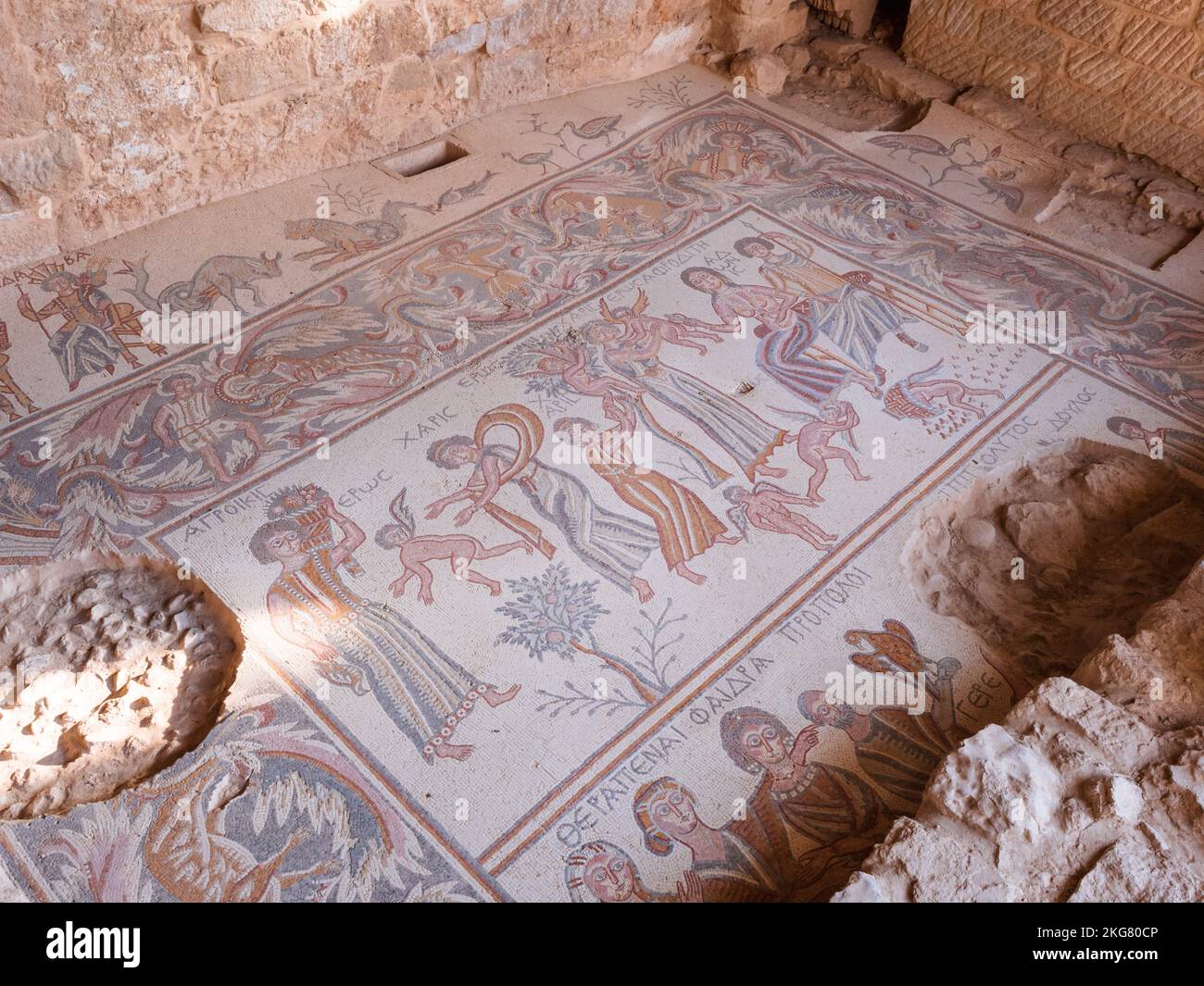 Mesmerizing mosaic in Hippolytus hall depicting Greco-Roman mythological figures and human life in Madaba Stock Photohttps://www.alamy.com/image-license-details/?v=1https://www.alamy.com/mesmerizing-mosaic-in-hippolytus-hall-depicting-greco-roman-mythological-figures-and-human-life-in-madaba-image491900774.html
Mesmerizing mosaic in Hippolytus hall depicting Greco-Roman mythological figures and human life in Madaba Stock Photohttps://www.alamy.com/image-license-details/?v=1https://www.alamy.com/mesmerizing-mosaic-in-hippolytus-hall-depicting-greco-roman-mythological-figures-and-human-life-in-madaba-image491900774.htmlRF2KG80CP–Mesmerizing mosaic in Hippolytus hall depicting Greco-Roman mythological figures and human life in Madaba
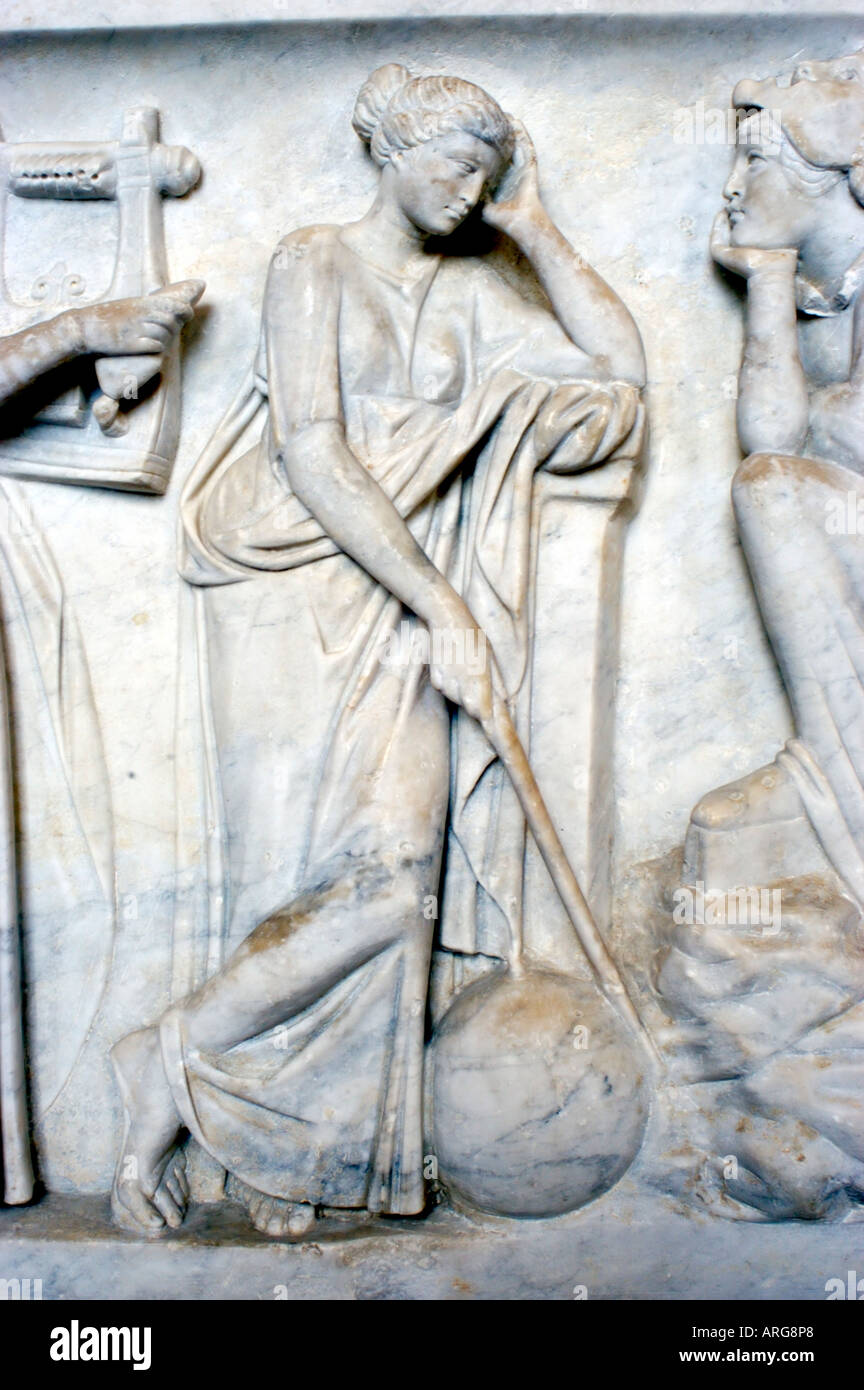 Paris France, Monuments Interior Louvre Museum Statue of 'Uranus Goddess of Astronomy' 'Mythological Character' Detail Sculpture, inside Stock Photohttps://www.alamy.com/image-license-details/?v=1https://www.alamy.com/paris-france-monuments-interior-louvre-museum-statue-of-uranus-goddess-image9169511.html
Paris France, Monuments Interior Louvre Museum Statue of 'Uranus Goddess of Astronomy' 'Mythological Character' Detail Sculpture, inside Stock Photohttps://www.alamy.com/image-license-details/?v=1https://www.alamy.com/paris-france-monuments-interior-louvre-museum-statue-of-uranus-goddess-image9169511.htmlRFARG8P8–Paris France, Monuments Interior Louvre Museum Statue of 'Uranus Goddess of Astronomy' 'Mythological Character' Detail Sculpture, inside
 Amazons, Greek mythological figures, 'Die sprungfertige Amazone', full length, drawing of statue, attributed to sculptor Phidias, woman, helmet, warrior, axe, shield, cooker, ancient world, mythology, , Stock Photohttps://www.alamy.com/image-license-details/?v=1https://www.alamy.com/stock-photo-amazons-greek-mythological-figures-die-sprungfertige-amazone-full-24443523.html
Amazons, Greek mythological figures, 'Die sprungfertige Amazone', full length, drawing of statue, attributed to sculptor Phidias, woman, helmet, warrior, axe, shield, cooker, ancient world, mythology, , Stock Photohttps://www.alamy.com/image-license-details/?v=1https://www.alamy.com/stock-photo-amazons-greek-mythological-figures-die-sprungfertige-amazone-full-24443523.htmlRMBBNDXY–Amazons, Greek mythological figures, 'Die sprungfertige Amazone', full length, drawing of statue, attributed to sculptor Phidias, woman, helmet, warrior, axe, shield, cooker, ancient world, mythology, ,
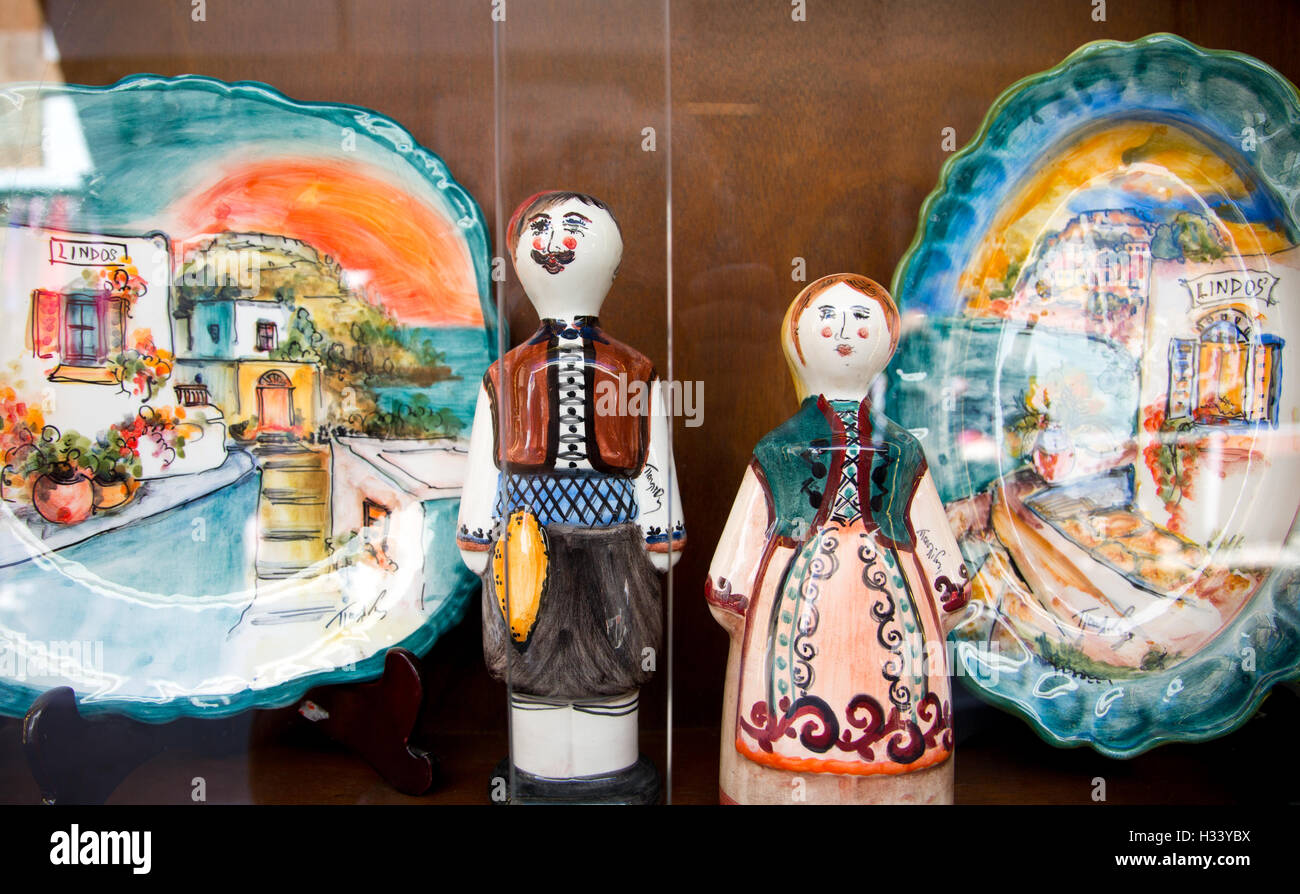 Painted Greek Plates Lindos Rhodes Greece Stock Photohttps://www.alamy.com/image-license-details/?v=1https://www.alamy.com/stock-photo-painted-greek-plates-lindos-rhodes-greece-122403902.html
Painted Greek Plates Lindos Rhodes Greece Stock Photohttps://www.alamy.com/image-license-details/?v=1https://www.alamy.com/stock-photo-painted-greek-plates-lindos-rhodes-greece-122403902.htmlRMH33YBX–Painted Greek Plates Lindos Rhodes Greece
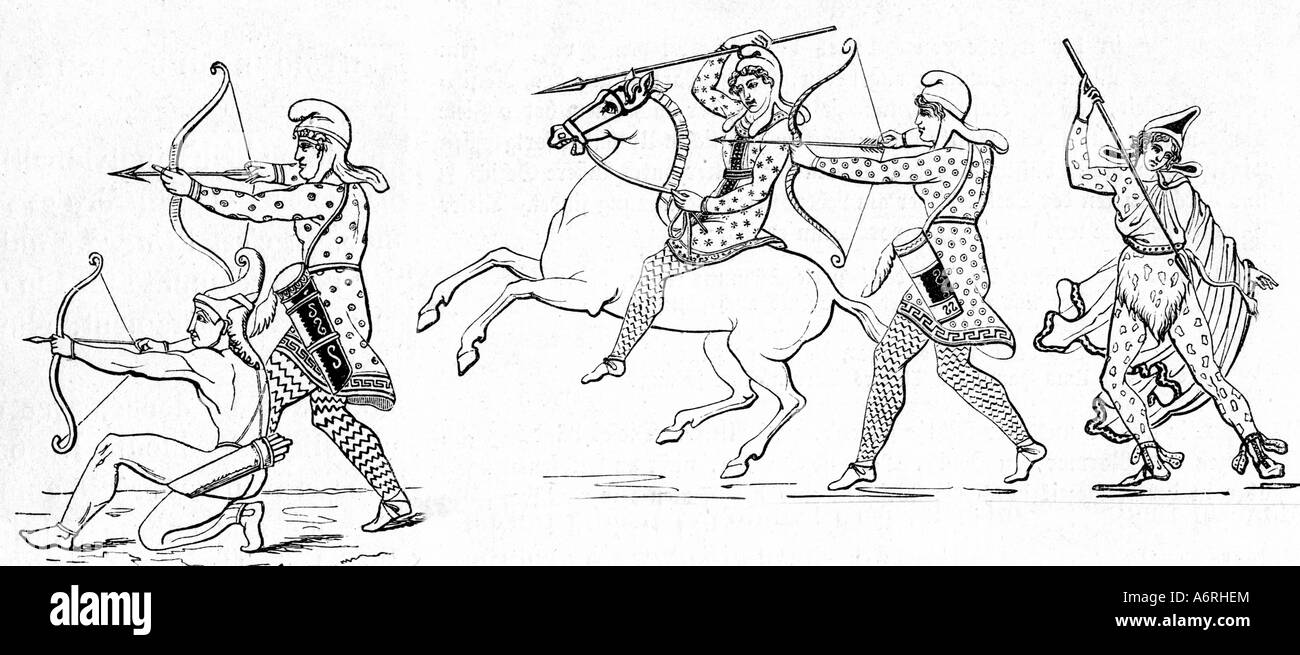 Amazons, Greek mythological figures, fighting Amazones, drawing, 19th century, after ancient illustration, women, phrygian cap, Stock Photohttps://www.alamy.com/image-license-details/?v=1https://www.alamy.com/stock-photo-amazons-greek-mythological-figures-fighting-amazones-drawing-19th-11637307.html
Amazons, Greek mythological figures, fighting Amazones, drawing, 19th century, after ancient illustration, women, phrygian cap, Stock Photohttps://www.alamy.com/image-license-details/?v=1https://www.alamy.com/stock-photo-amazons-greek-mythological-figures-fighting-amazones-drawing-19th-11637307.htmlRMA6RHEM–Amazons, Greek mythological figures, fighting Amazones, drawing, 19th century, after ancient illustration, women, phrygian cap,
 The Greek mythical figures of Heracles and Antaeus in combat. Antaeus was unbeatable as long as he remained in contact with the ground, so Hercules lifted him off the ground, deafeating him in a bearhug. Stock Photohttps://www.alamy.com/image-license-details/?v=1https://www.alamy.com/stock-photo-the-greek-mythical-figures-of-heracles-and-antaeus-in-combat-antaeus-103999769.html
The Greek mythical figures of Heracles and Antaeus in combat. Antaeus was unbeatable as long as he remained in contact with the ground, so Hercules lifted him off the ground, deafeating him in a bearhug. Stock Photohttps://www.alamy.com/image-license-details/?v=1https://www.alamy.com/stock-photo-the-greek-mythical-figures-of-heracles-and-antaeus-in-combat-antaeus-103999769.htmlRMG15GND–The Greek mythical figures of Heracles and Antaeus in combat. Antaeus was unbeatable as long as he remained in contact with the ground, so Hercules lifted him off the ground, deafeating him in a bearhug.
 Icarus and Daedalus, Greek mythological figures, fall of Icarus, coloured woodcut, Nuremberg or Augsburg, circa 1520, private co Stock Photohttps://www.alamy.com/image-license-details/?v=1https://www.alamy.com/stock-photo-icarus-and-daedalus-greek-mythological-figures-fall-of-icarus-coloured-11640041.html
Icarus and Daedalus, Greek mythological figures, fall of Icarus, coloured woodcut, Nuremberg or Augsburg, circa 1520, private co Stock Photohttps://www.alamy.com/image-license-details/?v=1https://www.alamy.com/stock-photo-icarus-and-daedalus-greek-mythological-figures-fall-of-icarus-coloured-11640041.htmlRMA6RWJJ–Icarus and Daedalus, Greek mythological figures, fall of Icarus, coloured woodcut, Nuremberg or Augsburg, circa 1520, private co
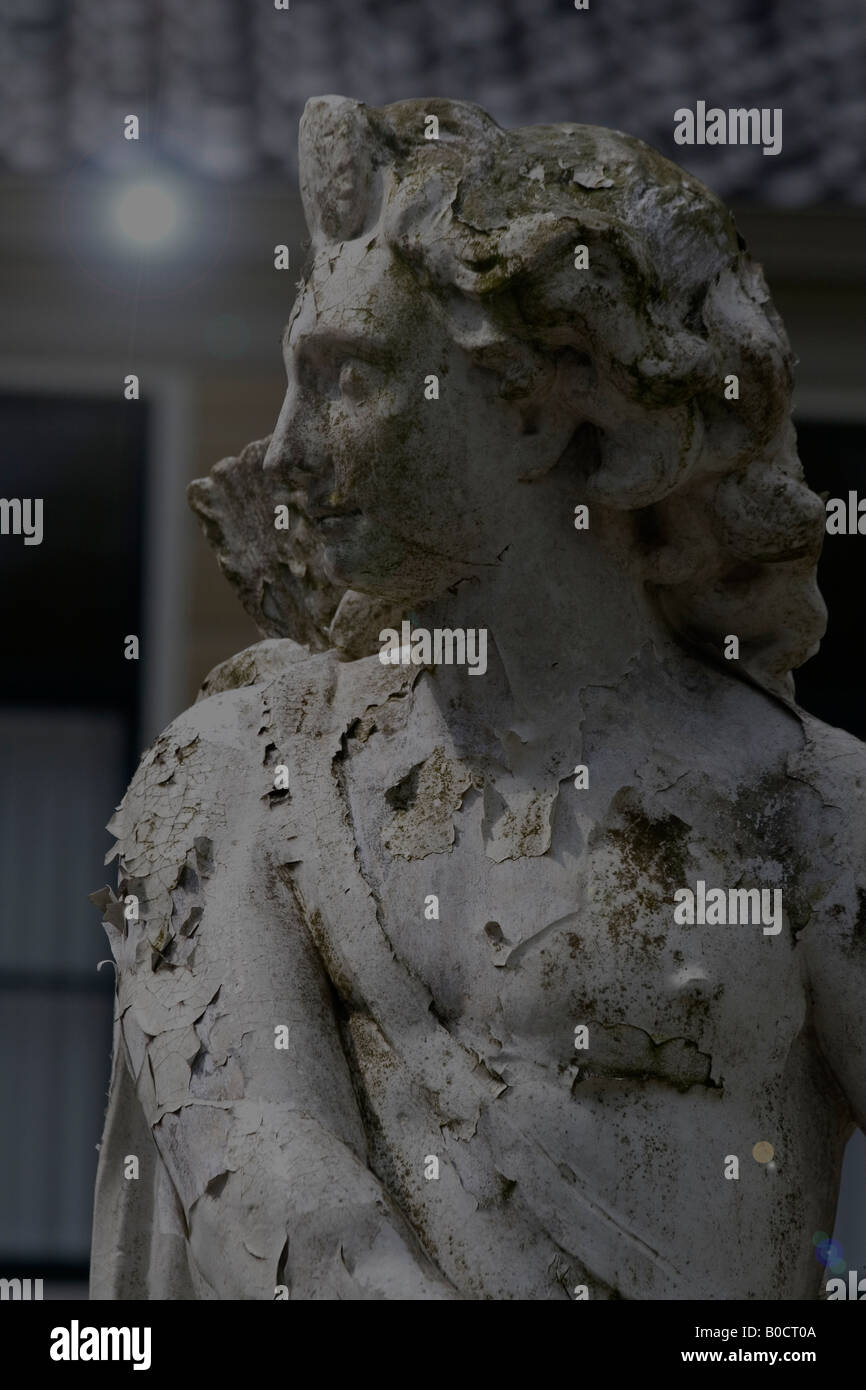 Greek mythological statue Stock Photohttps://www.alamy.com/image-license-details/?v=1https://www.alamy.com/stock-photo-greek-mythological-statue-17492618.html
Greek mythological statue Stock Photohttps://www.alamy.com/image-license-details/?v=1https://www.alamy.com/stock-photo-greek-mythological-statue-17492618.htmlRFB0CT0A–Greek mythological statue
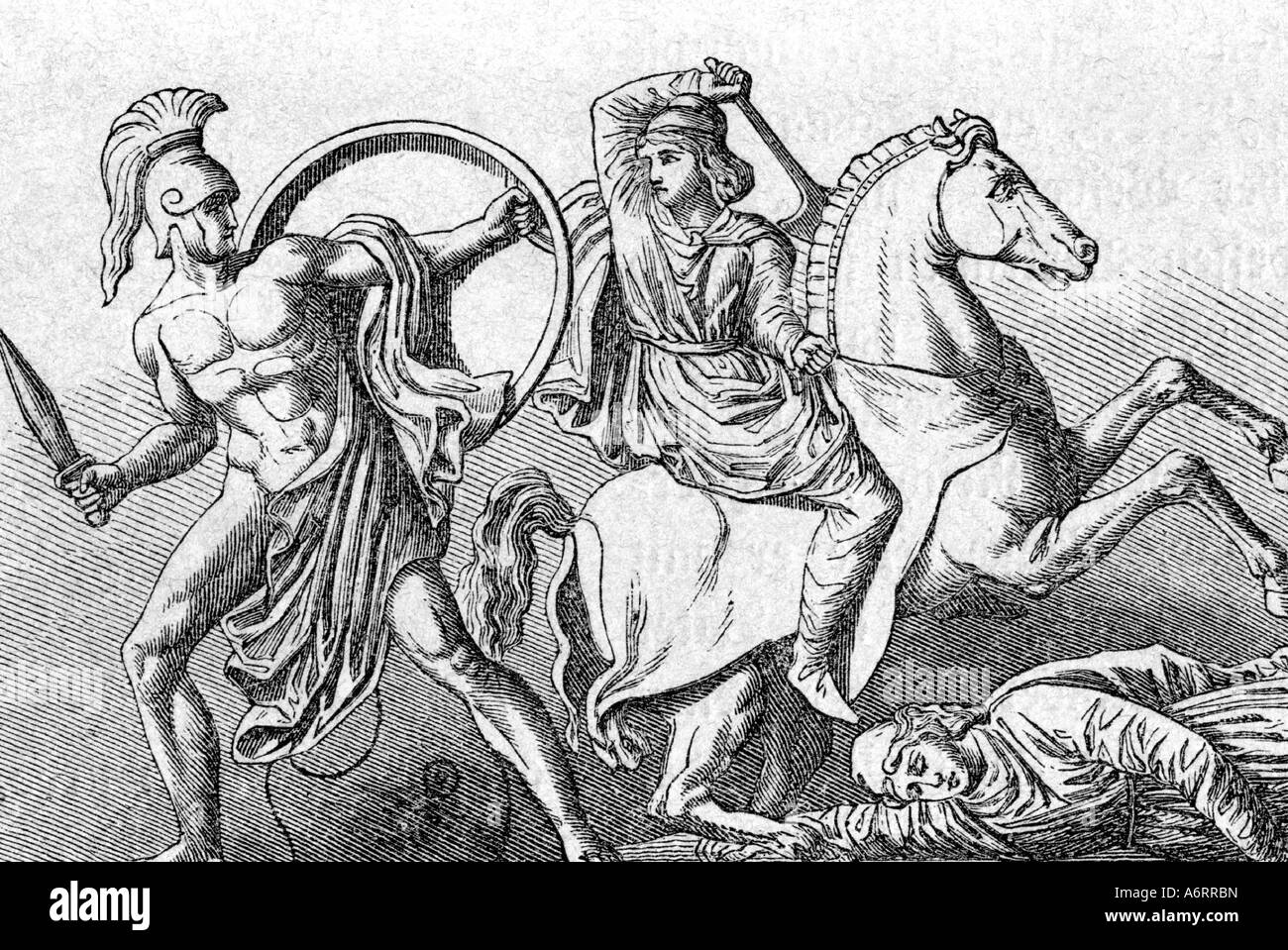 Amazons Greek mythological figures Amazon fighting with a Greek warrior engraving 19th century woman ancient world mythol Stock Photohttps://www.alamy.com/image-license-details/?v=1https://www.alamy.com/stock-photo-amazons-greek-mythological-figures-amazon-fighting-with-a-greek-warrior-11639288.html
Amazons Greek mythological figures Amazon fighting with a Greek warrior engraving 19th century woman ancient world mythol Stock Photohttps://www.alamy.com/image-license-details/?v=1https://www.alamy.com/stock-photo-amazons-greek-mythological-figures-amazon-fighting-with-a-greek-warrior-11639288.htmlRMA6RRBN–Amazons Greek mythological figures Amazon fighting with a Greek warrior engraving 19th century woman ancient world mythol
 Fragment of a terracotta skyphos (deep drinking cup). Culture: Greek, Attic. Dimensions: Other: 4 7/8 in. (12.4 cm). Date: ca. 490 B.C.. Peitho (the personification of persuasion), Aphrodite, and Eros These three figures belonged to a representation of either the Judgement of Paris or Menelaos reclaiming his wife, Helen, at Troy. At this time, large skyphoi were favored for elaborate mythological decorations, especially by painters around Douris and Makron. The ladies are exceptionally grand and statuesque. Museum: Metropolitan Museum of Art, New York, USA. Stock Photohttps://www.alamy.com/image-license-details/?v=1https://www.alamy.com/fragment-of-a-terracotta-skyphos-deep-drinking-cup-culture-greek-attic-dimensions-other-4-78-in-124-cm-date-ca-490-bc-peitho-the-personification-of-persuasion-aphrodite-and-eros-these-three-figures-belonged-to-a-representation-of-either-the-judgement-of-paris-or-menelaos-reclaiming-his-wife-helen-at-troy-at-this-time-large-skyphoi-were-favored-for-elaborate-mythological-decorations-especially-by-painters-around-douris-and-makron-the-ladies-are-exceptionally-grand-and-statuesque-museum-metropolitan-museum-of-art-new-york-usa-image213113088.html
Fragment of a terracotta skyphos (deep drinking cup). Culture: Greek, Attic. Dimensions: Other: 4 7/8 in. (12.4 cm). Date: ca. 490 B.C.. Peitho (the personification of persuasion), Aphrodite, and Eros These three figures belonged to a representation of either the Judgement of Paris or Menelaos reclaiming his wife, Helen, at Troy. At this time, large skyphoi were favored for elaborate mythological decorations, especially by painters around Douris and Makron. The ladies are exceptionally grand and statuesque. Museum: Metropolitan Museum of Art, New York, USA. Stock Photohttps://www.alamy.com/image-license-details/?v=1https://www.alamy.com/fragment-of-a-terracotta-skyphos-deep-drinking-cup-culture-greek-attic-dimensions-other-4-78-in-124-cm-date-ca-490-bc-peitho-the-personification-of-persuasion-aphrodite-and-eros-these-three-figures-belonged-to-a-representation-of-either-the-judgement-of-paris-or-menelaos-reclaiming-his-wife-helen-at-troy-at-this-time-large-skyphoi-were-favored-for-elaborate-mythological-decorations-especially-by-painters-around-douris-and-makron-the-ladies-are-exceptionally-grand-and-statuesque-museum-metropolitan-museum-of-art-new-york-usa-image213113088.htmlRMPAM3WM–Fragment of a terracotta skyphos (deep drinking cup). Culture: Greek, Attic. Dimensions: Other: 4 7/8 in. (12.4 cm). Date: ca. 490 B.C.. Peitho (the personification of persuasion), Aphrodite, and Eros These three figures belonged to a representation of either the Judgement of Paris or Menelaos reclaiming his wife, Helen, at Troy. At this time, large skyphoi were favored for elaborate mythological decorations, especially by painters around Douris and Makron. The ladies are exceptionally grand and statuesque. Museum: Metropolitan Museum of Art, New York, USA.
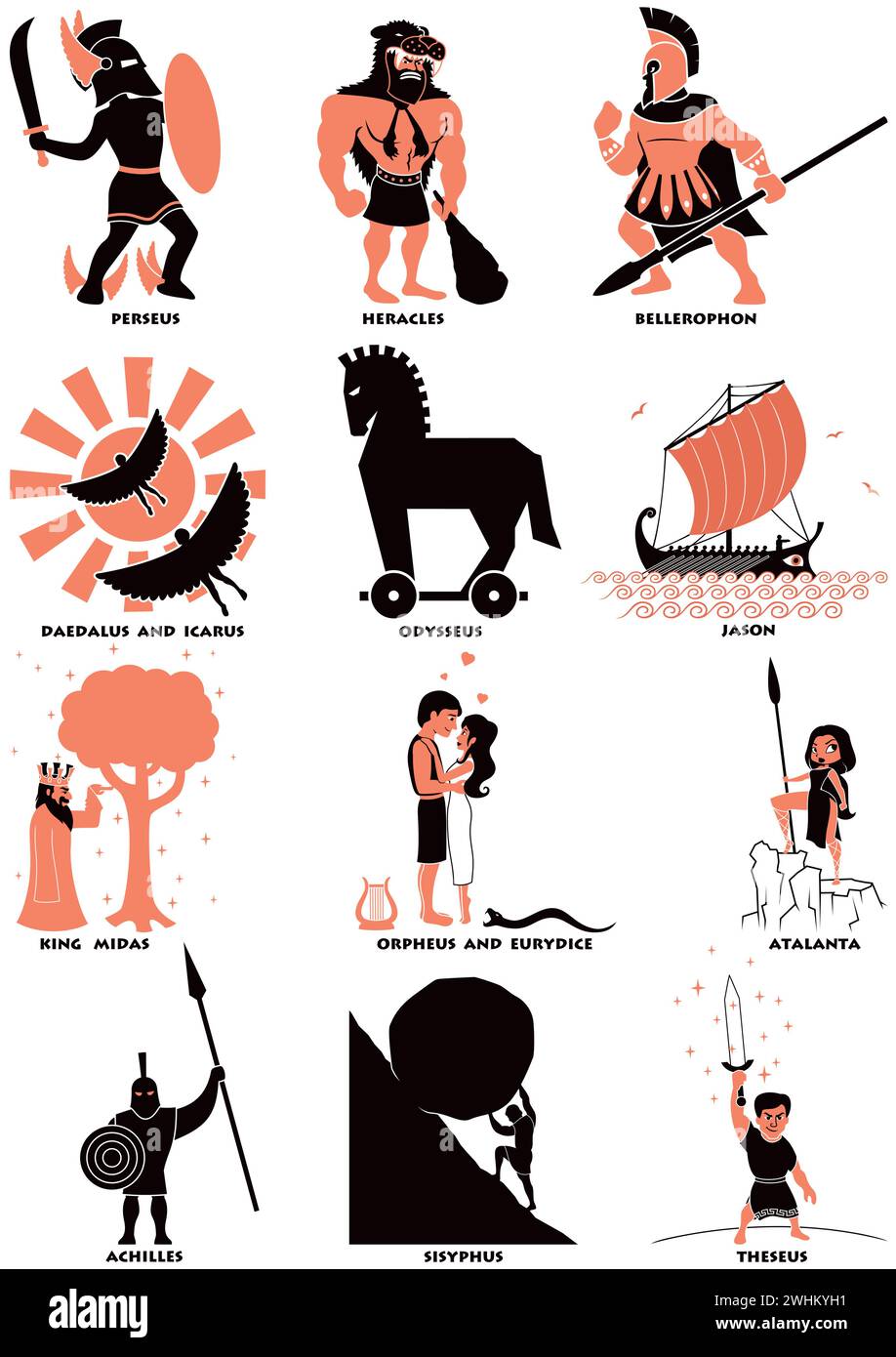 Flat design illustration set of Greek mythology heroes, each depicted with a symbol of their legend, on a white background. Stock Vectorhttps://www.alamy.com/image-license-details/?v=1https://www.alamy.com/flat-design-illustration-set-of-greek-mythology-heroes-each-depicted-with-a-symbol-of-their-legend-on-a-white-background-image596040397.html
Flat design illustration set of Greek mythology heroes, each depicted with a symbol of their legend, on a white background. Stock Vectorhttps://www.alamy.com/image-license-details/?v=1https://www.alamy.com/flat-design-illustration-set-of-greek-mythology-heroes-each-depicted-with-a-symbol-of-their-legend-on-a-white-background-image596040397.htmlRF2WHKYH1–Flat design illustration set of Greek mythology heroes, each depicted with a symbol of their legend, on a white background.
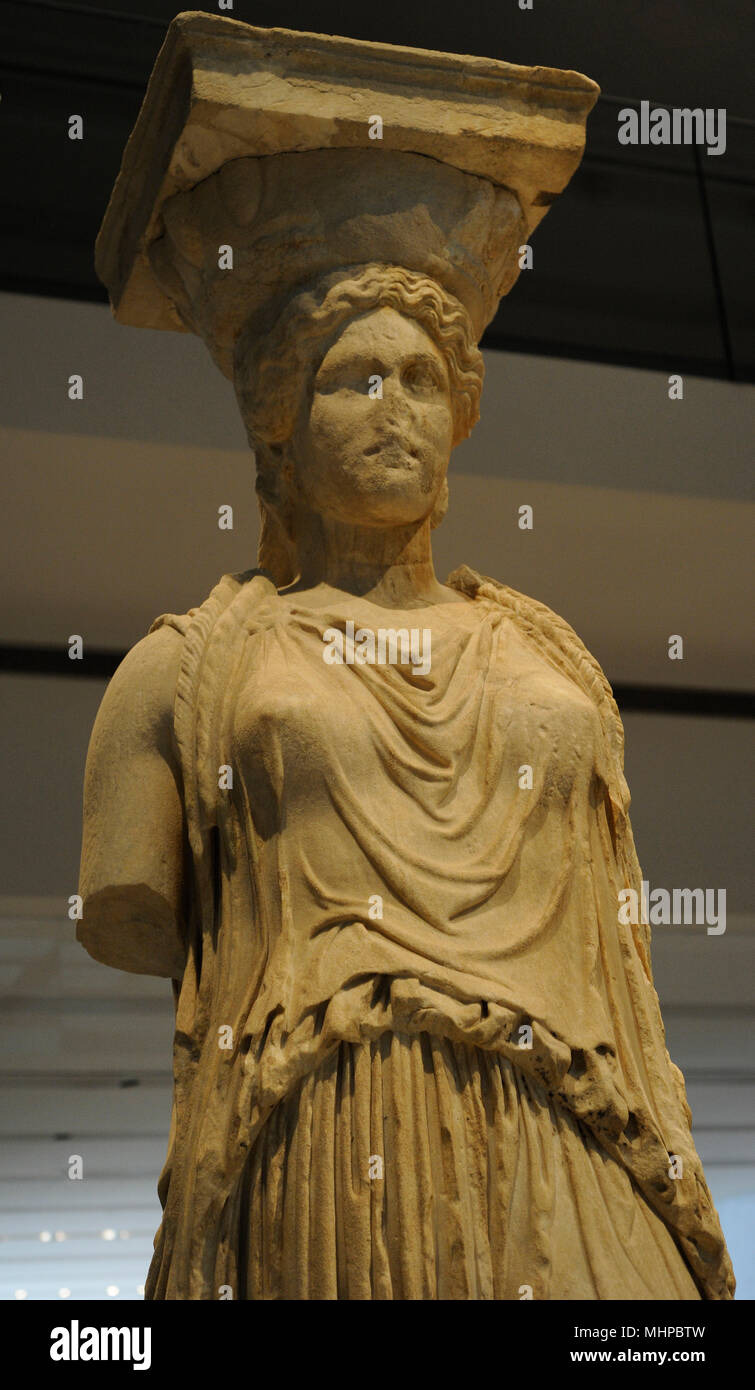 Greek art. The Caryatid Porch of the Erechtheion. Draped female figures as supporting columns. Detail. Acropolis of Athens, 421-407 BC. Greece. Acropolis Museum. Athens. Greece. Stock Photohttps://www.alamy.com/image-license-details/?v=1https://www.alamy.com/greek-art-the-caryatid-porch-of-the-erechtheion-draped-female-figures-as-supporting-columns-detail-acropolis-of-athens-421-407-bc-greece-acropolis-museum-athens-greece-image183045097.html
Greek art. The Caryatid Porch of the Erechtheion. Draped female figures as supporting columns. Detail. Acropolis of Athens, 421-407 BC. Greece. Acropolis Museum. Athens. Greece. Stock Photohttps://www.alamy.com/image-license-details/?v=1https://www.alamy.com/greek-art-the-caryatid-porch-of-the-erechtheion-draped-female-figures-as-supporting-columns-detail-acropolis-of-athens-421-407-bc-greece-acropolis-museum-athens-greece-image183045097.htmlRMMHPBTW–Greek art. The Caryatid Porch of the Erechtheion. Draped female figures as supporting columns. Detail. Acropolis of Athens, 421-407 BC. Greece. Acropolis Museum. Athens. Greece.
 Representative figures of classical Greek ceramics. Two mermaids playing a zither and a flute. Mythological creatures with fish tails Stock Vectorhttps://www.alamy.com/image-license-details/?v=1https://www.alamy.com/representative-figures-of-classical-greek-ceramics-two-mermaids-playing-a-zither-and-a-flute-mythological-creatures-with-fish-tails-image454779946.html
Representative figures of classical Greek ceramics. Two mermaids playing a zither and a flute. Mythological creatures with fish tails Stock Vectorhttps://www.alamy.com/image-license-details/?v=1https://www.alamy.com/representative-figures-of-classical-greek-ceramics-two-mermaids-playing-a-zither-and-a-flute-mythological-creatures-with-fish-tails-image454779946.htmlRF2HBW0CX–Representative figures of classical Greek ceramics. Two mermaids playing a zither and a flute. Mythological creatures with fish tails
 Bronze Equestrian of the Dioscuri, mythological twins, Castor & Pollux, outside the Royal Palace in Turin, Italy. Stock Photohttps://www.alamy.com/image-license-details/?v=1https://www.alamy.com/stock-image-bronze-equestrian-of-the-dioscuri-mythological-twins-castor-pollux-164559413.html
Bronze Equestrian of the Dioscuri, mythological twins, Castor & Pollux, outside the Royal Palace in Turin, Italy. Stock Photohttps://www.alamy.com/image-license-details/?v=1https://www.alamy.com/stock-image-bronze-equestrian-of-the-dioscuri-mythological-twins-castor-pollux-164559413.htmlRMKFM95W–Bronze Equestrian of the Dioscuri, mythological twins, Castor & Pollux, outside the Royal Palace in Turin, Italy.
 ATHENS, Greece — Black-on-white Greek pottery, featuring the distinctive white-ground technique, is displayed at the National Archaeological Museum in Athens. This style of pottery, characterized by black figures and designs painted on a white slip, was prominent in ancient Greece from the 6th to 5th centuries BC. The museum's collection showcases various pottery forms, including lekythoi, kraters, and amphorae, adorned with mythological scenes, daily life depictions, and geometric patterns, highlighting the artistic achievements and cultural heritage of ancient Greece. Stock Photohttps://www.alamy.com/image-license-details/?v=1https://www.alamy.com/athens-greece-black-on-white-greek-pottery-featuring-the-distinctive-white-ground-technique-is-displayed-at-the-national-archaeological-museum-in-athens-this-style-of-pottery-characterized-by-black-figures-and-designs-painted-on-a-white-slip-was-prominent-in-ancient-greece-from-the-6th-to-5th-centuries-bc-the-museums-collection-showcases-various-pottery-forms-including-lekythoi-kraters-and-amphorae-adorned-with-mythological-scenes-daily-life-depictions-and-geometric-patterns-highlighting-the-artistic-achievements-and-cultural-heritage-of-ancient-greece-image615729859.html
ATHENS, Greece — Black-on-white Greek pottery, featuring the distinctive white-ground technique, is displayed at the National Archaeological Museum in Athens. This style of pottery, characterized by black figures and designs painted on a white slip, was prominent in ancient Greece from the 6th to 5th centuries BC. The museum's collection showcases various pottery forms, including lekythoi, kraters, and amphorae, adorned with mythological scenes, daily life depictions, and geometric patterns, highlighting the artistic achievements and cultural heritage of ancient Greece. Stock Photohttps://www.alamy.com/image-license-details/?v=1https://www.alamy.com/athens-greece-black-on-white-greek-pottery-featuring-the-distinctive-white-ground-technique-is-displayed-at-the-national-archaeological-museum-in-athens-this-style-of-pottery-characterized-by-black-figures-and-designs-painted-on-a-white-slip-was-prominent-in-ancient-greece-from-the-6th-to-5th-centuries-bc-the-museums-collection-showcases-various-pottery-forms-including-lekythoi-kraters-and-amphorae-adorned-with-mythological-scenes-daily-life-depictions-and-geometric-patterns-highlighting-the-artistic-achievements-and-cultural-heritage-of-ancient-greece-image615729859.htmlRM2XNMWM3–ATHENS, Greece — Black-on-white Greek pottery, featuring the distinctive white-ground technique, is displayed at the National Archaeological Museum in Athens. This style of pottery, characterized by black figures and designs painted on a white slip, was prominent in ancient Greece from the 6th to 5th centuries BC. The museum's collection showcases various pottery forms, including lekythoi, kraters, and amphorae, adorned with mythological scenes, daily life depictions, and geometric patterns, highlighting the artistic achievements and cultural heritage of ancient Greece.
 ATHENS, GREECE, JUN 04, 2016.One of the many souvenir shops in the Greek capital of Athens. On the shelf are mythological figures of the Greek gods. Stock Photohttps://www.alamy.com/image-license-details/?v=1https://www.alamy.com/athens-greece-jun-04-2016one-of-the-many-souvenir-shops-in-the-greek-capital-of-athens-on-the-shelf-are-mythological-figures-of-the-greek-gods-image271943553.html
ATHENS, GREECE, JUN 04, 2016.One of the many souvenir shops in the Greek capital of Athens. On the shelf are mythological figures of the Greek gods. Stock Photohttps://www.alamy.com/image-license-details/?v=1https://www.alamy.com/athens-greece-jun-04-2016one-of-the-many-souvenir-shops-in-the-greek-capital-of-athens-on-the-shelf-are-mythological-figures-of-the-greek-gods-image271943553.htmlRFWPC2NN–ATHENS, GREECE, JUN 04, 2016.One of the many souvenir shops in the Greek capital of Athens. On the shelf are mythological figures of the Greek gods.
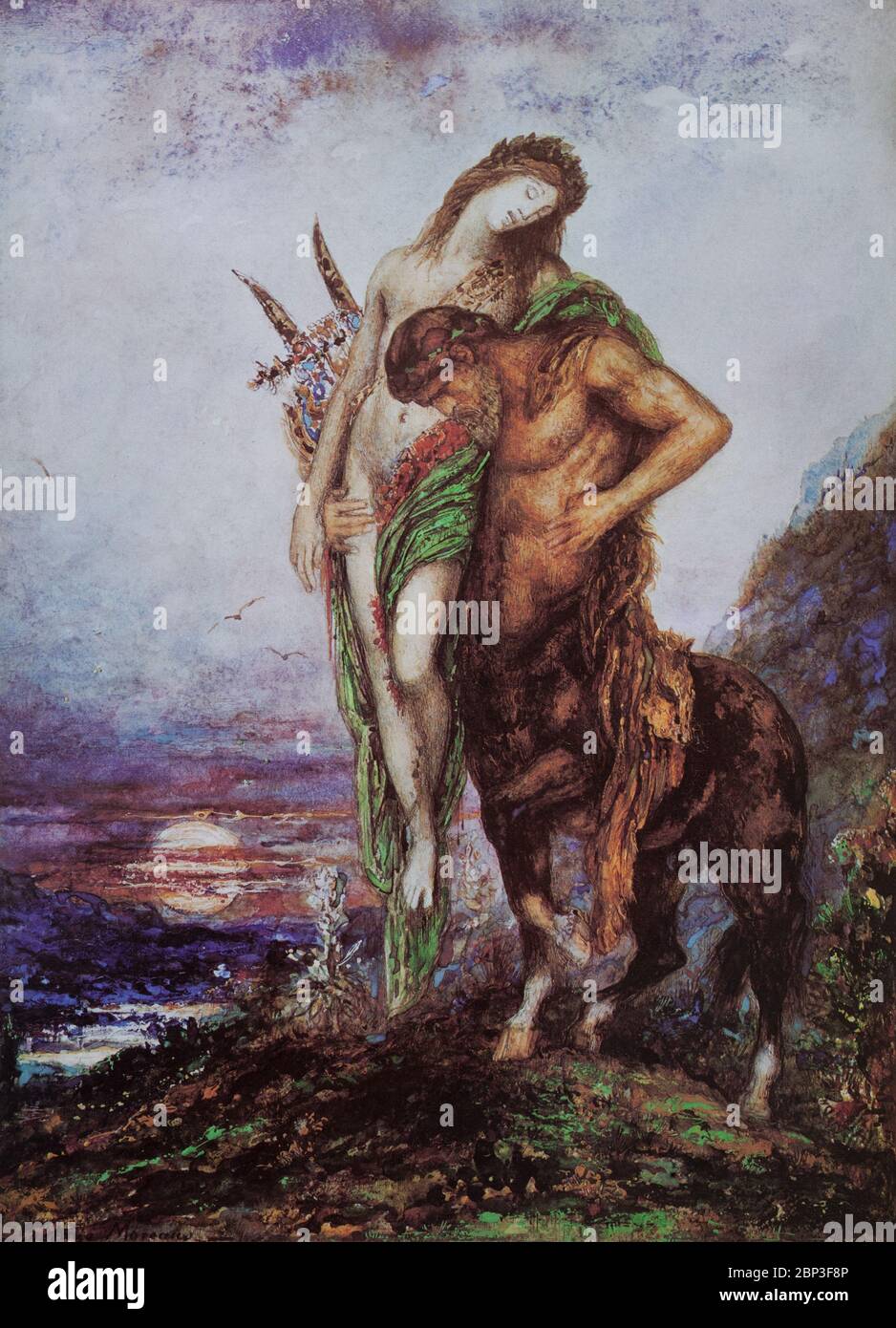 'The Dead Poet Borne by a Centaur', by Gustave Moreau (1826-1898), a major figure in the French Symbolist movement, whose main emphasis was the illustration of biblical and mythological figures. During his lifetime, Moreau produced more than 8,000 paintings, watercolors and drawings influencing the next generation of Symbolists, particularly Odilon Redon and Jean Delville. Stock Photohttps://www.alamy.com/image-license-details/?v=1https://www.alamy.com/the-dead-poet-borne-by-a-centaur-by-gustave-moreau-1826-1898-a-major-figure-in-the-french-symbolist-movement-whose-main-emphasis-was-the-illustration-of-biblical-and-mythological-figures-during-his-lifetime-moreau-produced-more-than-8000-paintings-watercolors-and-drawings-influencing-the-next-generation-of-symbolists-particularly-odilon-redon-and-jean-delville-image357807654.html
'The Dead Poet Borne by a Centaur', by Gustave Moreau (1826-1898), a major figure in the French Symbolist movement, whose main emphasis was the illustration of biblical and mythological figures. During his lifetime, Moreau produced more than 8,000 paintings, watercolors and drawings influencing the next generation of Symbolists, particularly Odilon Redon and Jean Delville. Stock Photohttps://www.alamy.com/image-license-details/?v=1https://www.alamy.com/the-dead-poet-borne-by-a-centaur-by-gustave-moreau-1826-1898-a-major-figure-in-the-french-symbolist-movement-whose-main-emphasis-was-the-illustration-of-biblical-and-mythological-figures-during-his-lifetime-moreau-produced-more-than-8000-paintings-watercolors-and-drawings-influencing-the-next-generation-of-symbolists-particularly-odilon-redon-and-jean-delville-image357807654.htmlRM2BP3F8P–'The Dead Poet Borne by a Centaur', by Gustave Moreau (1826-1898), a major figure in the French Symbolist movement, whose main emphasis was the illustration of biblical and mythological figures. During his lifetime, Moreau produced more than 8,000 paintings, watercolors and drawings influencing the next generation of Symbolists, particularly Odilon Redon and Jean Delville.
 Ancient vase in the British Museum. Vases in red clay with black designs of mythological figures. Handcoloured copperplate engraving by Henry Moses from A Collection of Antique Vases, Altars, etc., London, 1814. Stock Photohttps://www.alamy.com/image-license-details/?v=1https://www.alamy.com/stock-image-ancient-vase-in-the-british-museum-vases-in-red-clay-with-black-designs-165639780.html
Ancient vase in the British Museum. Vases in red clay with black designs of mythological figures. Handcoloured copperplate engraving by Henry Moses from A Collection of Antique Vases, Altars, etc., London, 1814. Stock Photohttps://www.alamy.com/image-license-details/?v=1https://www.alamy.com/stock-image-ancient-vase-in-the-british-museum-vases-in-red-clay-with-black-designs-165639780.htmlRMKHDF6C–Ancient vase in the British Museum. Vases in red clay with black designs of mythological figures. Handcoloured copperplate engraving by Henry Moses from A Collection of Antique Vases, Altars, etc., London, 1814.
 A Greek terracotta amphora, signed by the artist Taleides, depicting the legendary hero Theseus attacking the Minotaur. Dated to approximately 550-525 B.C., this piece is an example of the Attic black-figure style, a technique characterized by the depiction of figures in silhouette with details incised into the black glaze, while the background remains the natural color of the clay. Stock Photohttps://www.alamy.com/image-license-details/?v=1https://www.alamy.com/a-greek-terracotta-amphora-signed-by-the-artist-taleides-depicting-the-legendary-hero-theseus-attacking-the-minotaur-dated-to-approximately-550-525-bc-this-piece-is-an-example-of-the-attic-black-figure-style-a-technique-characterized-by-the-depiction-of-figures-in-silhouette-with-details-incised-into-the-black-glaze-while-the-background-remains-the-natural-color-of-the-clay-image601211482.html
A Greek terracotta amphora, signed by the artist Taleides, depicting the legendary hero Theseus attacking the Minotaur. Dated to approximately 550-525 B.C., this piece is an example of the Attic black-figure style, a technique characterized by the depiction of figures in silhouette with details incised into the black glaze, while the background remains the natural color of the clay. Stock Photohttps://www.alamy.com/image-license-details/?v=1https://www.alamy.com/a-greek-terracotta-amphora-signed-by-the-artist-taleides-depicting-the-legendary-hero-theseus-attacking-the-minotaur-dated-to-approximately-550-525-bc-this-piece-is-an-example-of-the-attic-black-figure-style-a-technique-characterized-by-the-depiction-of-figures-in-silhouette-with-details-incised-into-the-black-glaze-while-the-background-remains-the-natural-color-of-the-clay-image601211482.htmlRM2WX3FAJ–A Greek terracotta amphora, signed by the artist Taleides, depicting the legendary hero Theseus attacking the Minotaur. Dated to approximately 550-525 B.C., this piece is an example of the Attic black-figure style, a technique characterized by the depiction of figures in silhouette with details incised into the black glaze, while the background remains the natural color of the clay.
 Oorhanger Met Mythological Figures, Anonymous, c. 1770 - c. 1790 Ear pendant of blue Jasperware. The earring is decorated in white with Greek female figures. Stoke-on-Trent . Ear pendant of blue Jasperware. The earring is decorated in white with Greek female figures. Stoke-on-Trent . Stock Photohttps://www.alamy.com/image-license-details/?v=1https://www.alamy.com/oorhanger-met-mythological-figures-anonymous-c-1770-c-1790-ear-pendant-of-blue-jasperware-the-earring-is-decorated-in-white-with-greek-female-figures-stoke-on-trent-ear-pendant-of-blue-jasperware-the-earring-is-decorated-in-white-with-greek-female-figures-stoke-on-trent-image576301685.html
Oorhanger Met Mythological Figures, Anonymous, c. 1770 - c. 1790 Ear pendant of blue Jasperware. The earring is decorated in white with Greek female figures. Stoke-on-Trent . Ear pendant of blue Jasperware. The earring is decorated in white with Greek female figures. Stoke-on-Trent . Stock Photohttps://www.alamy.com/image-license-details/?v=1https://www.alamy.com/oorhanger-met-mythological-figures-anonymous-c-1770-c-1790-ear-pendant-of-blue-jasperware-the-earring-is-decorated-in-white-with-greek-female-figures-stoke-on-trent-ear-pendant-of-blue-jasperware-the-earring-is-decorated-in-white-with-greek-female-figures-stoke-on-trent-image576301685.htmlRM2TDGPK1–Oorhanger Met Mythological Figures, Anonymous, c. 1770 - c. 1790 Ear pendant of blue Jasperware. The earring is decorated in white with Greek female figures. Stoke-on-Trent . Ear pendant of blue Jasperware. The earring is decorated in white with Greek female figures. Stoke-on-Trent .
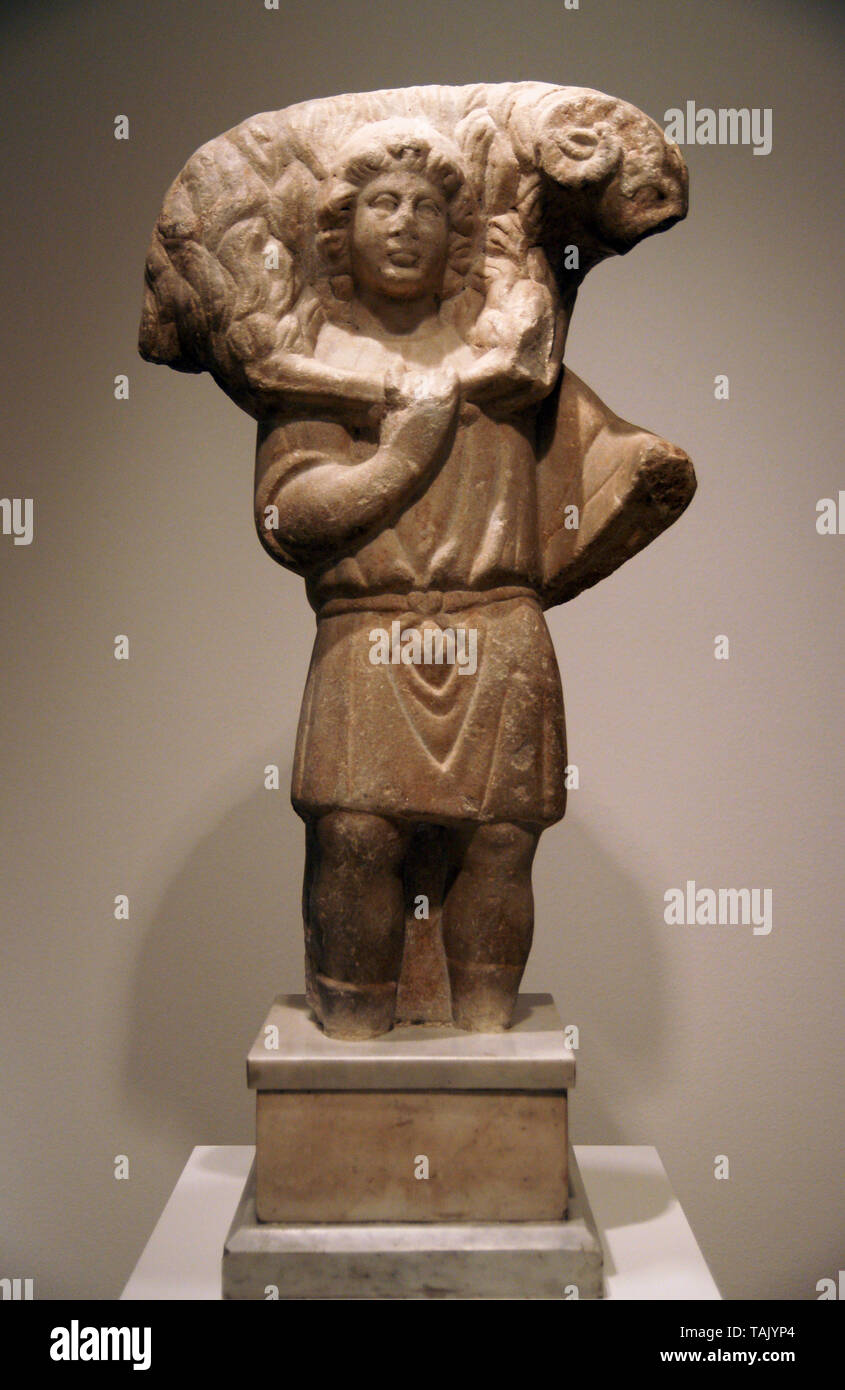 The good shepherd. Marble statue, 4th-5th century AD. Byzantium ( Now Istambul). The State Hermitage Museum, Saint Petersburg, Russia. Stock Photohttps://www.alamy.com/image-license-details/?v=1https://www.alamy.com/the-good-shepherd-marble-statue-4th-5th-century-ad-byzantium-now-istambul-the-state-hermitage-museum-saint-petersburg-russia-image247508636.html
The good shepherd. Marble statue, 4th-5th century AD. Byzantium ( Now Istambul). The State Hermitage Museum, Saint Petersburg, Russia. Stock Photohttps://www.alamy.com/image-license-details/?v=1https://www.alamy.com/the-good-shepherd-marble-statue-4th-5th-century-ad-byzantium-now-istambul-the-state-hermitage-museum-saint-petersburg-russia-image247508636.htmlRMTAJYP4–The good shepherd. Marble statue, 4th-5th century AD. Byzantium ( Now Istambul). The State Hermitage Museum, Saint Petersburg, Russia.
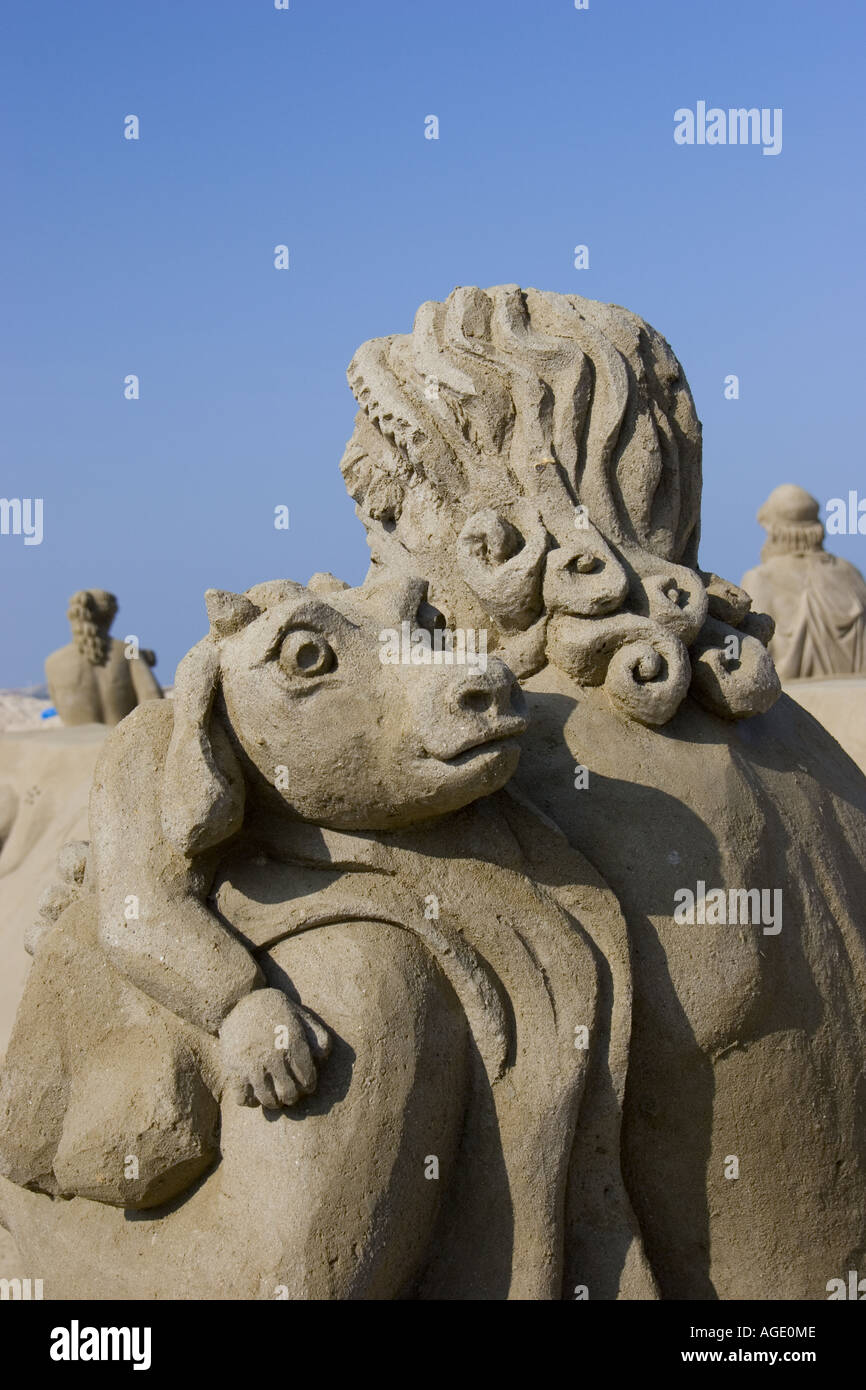 Sand sculpture of mythical pet from ancient Greece Stock Photohttps://www.alamy.com/image-license-details/?v=1https://www.alamy.com/sand-sculpture-of-mythical-pet-from-ancient-greece-image8103501.html
Sand sculpture of mythical pet from ancient Greece Stock Photohttps://www.alamy.com/image-license-details/?v=1https://www.alamy.com/sand-sculpture-of-mythical-pet-from-ancient-greece-image8103501.htmlRMAGE0ME–Sand sculpture of mythical pet from ancient Greece
 Earring with mythological figures, Earring made of blue jasperware. The earring is decorated in white with greek female figures., anonymous, Stoke-on-Trent, c. 1770 - c. 1790, l 6.2 cm, Reimagined by Gibon, design of warm cheerful glowing of brightness and light rays radiance. Classic art reinvented with a modern twist. Photography inspired by futurism, embracing dynamic energy of modern technology, movement, speed and revolutionize culture. Stock Photohttps://www.alamy.com/image-license-details/?v=1https://www.alamy.com/earring-with-mythological-figures-earring-made-of-blue-jasperware-the-earring-is-decorated-in-white-with-greek-female-figures-anonymous-stoke-on-trent-c-1770-c-1790-l-62-cm-reimagined-by-gibon-design-of-warm-cheerful-glowing-of-brightness-and-light-rays-radiance-classic-art-reinvented-with-a-modern-twist-photography-inspired-by-futurism-embracing-dynamic-energy-of-modern-technology-movement-speed-and-revolutionize-culture-image349977369.html
Earring with mythological figures, Earring made of blue jasperware. The earring is decorated in white with greek female figures., anonymous, Stoke-on-Trent, c. 1770 - c. 1790, l 6.2 cm, Reimagined by Gibon, design of warm cheerful glowing of brightness and light rays radiance. Classic art reinvented with a modern twist. Photography inspired by futurism, embracing dynamic energy of modern technology, movement, speed and revolutionize culture. Stock Photohttps://www.alamy.com/image-license-details/?v=1https://www.alamy.com/earring-with-mythological-figures-earring-made-of-blue-jasperware-the-earring-is-decorated-in-white-with-greek-female-figures-anonymous-stoke-on-trent-c-1770-c-1790-l-62-cm-reimagined-by-gibon-design-of-warm-cheerful-glowing-of-brightness-and-light-rays-radiance-classic-art-reinvented-with-a-modern-twist-photography-inspired-by-futurism-embracing-dynamic-energy-of-modern-technology-movement-speed-and-revolutionize-culture-image349977369.htmlRF2B9ARKN–Earring with mythological figures, Earring made of blue jasperware. The earring is decorated in white with greek female figures., anonymous, Stoke-on-Trent, c. 1770 - c. 1790, l 6.2 cm, Reimagined by Gibon, design of warm cheerful glowing of brightness and light rays radiance. Classic art reinvented with a modern twist. Photography inspired by futurism, embracing dynamic energy of modern technology, movement, speed and revolutionize culture.
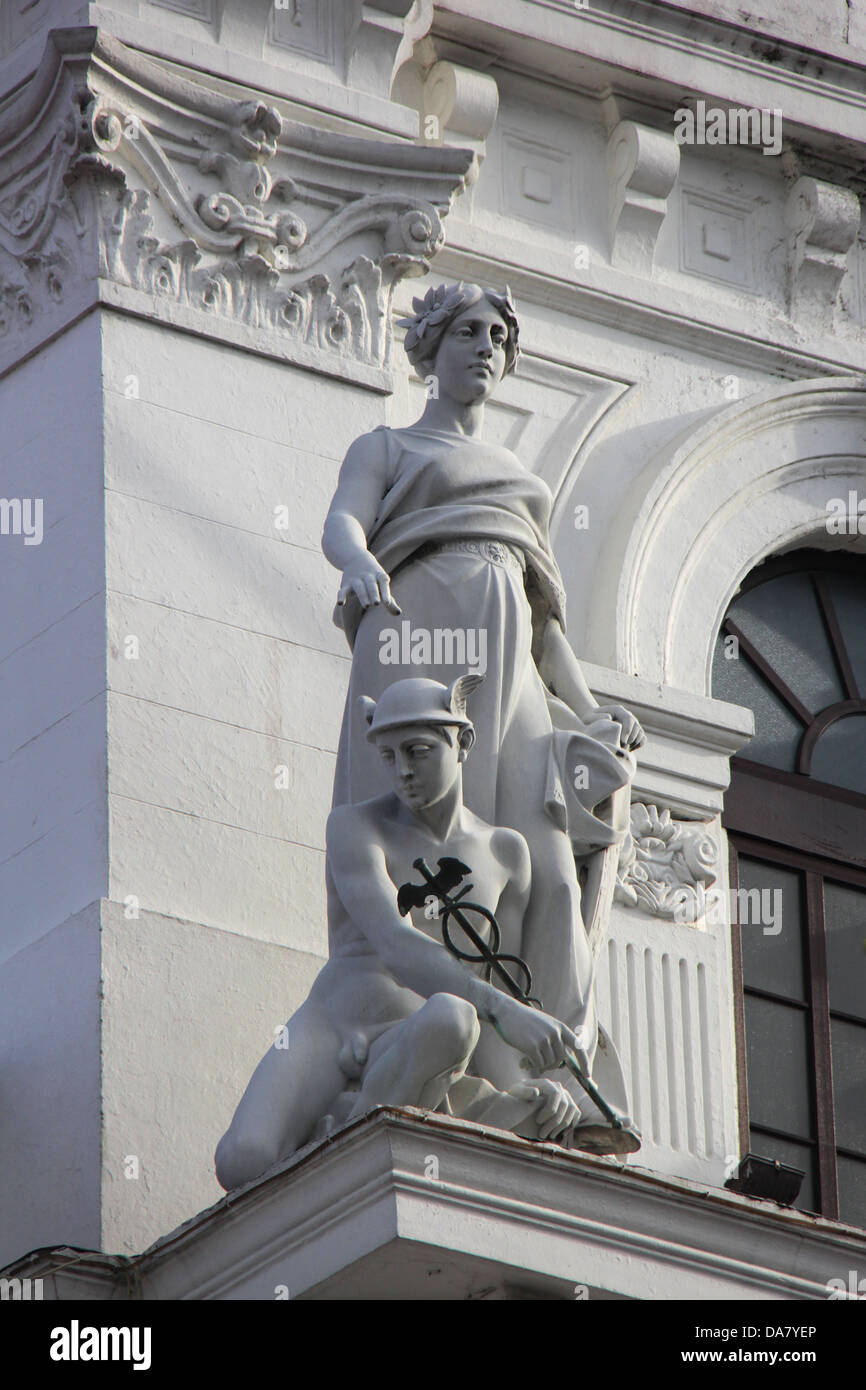 Greek gods statues in the facade of a public building in Panama City. Stock Photohttps://www.alamy.com/image-license-details/?v=1https://www.alamy.com/stock-photo-greek-gods-statues-in-the-facade-of-a-public-building-in-panama-city-57952910.html
Greek gods statues in the facade of a public building in Panama City. Stock Photohttps://www.alamy.com/image-license-details/?v=1https://www.alamy.com/stock-photo-greek-gods-statues-in-the-facade-of-a-public-building-in-panama-city-57952910.htmlRMDA7YEP–Greek gods statues in the facade of a public building in Panama City.
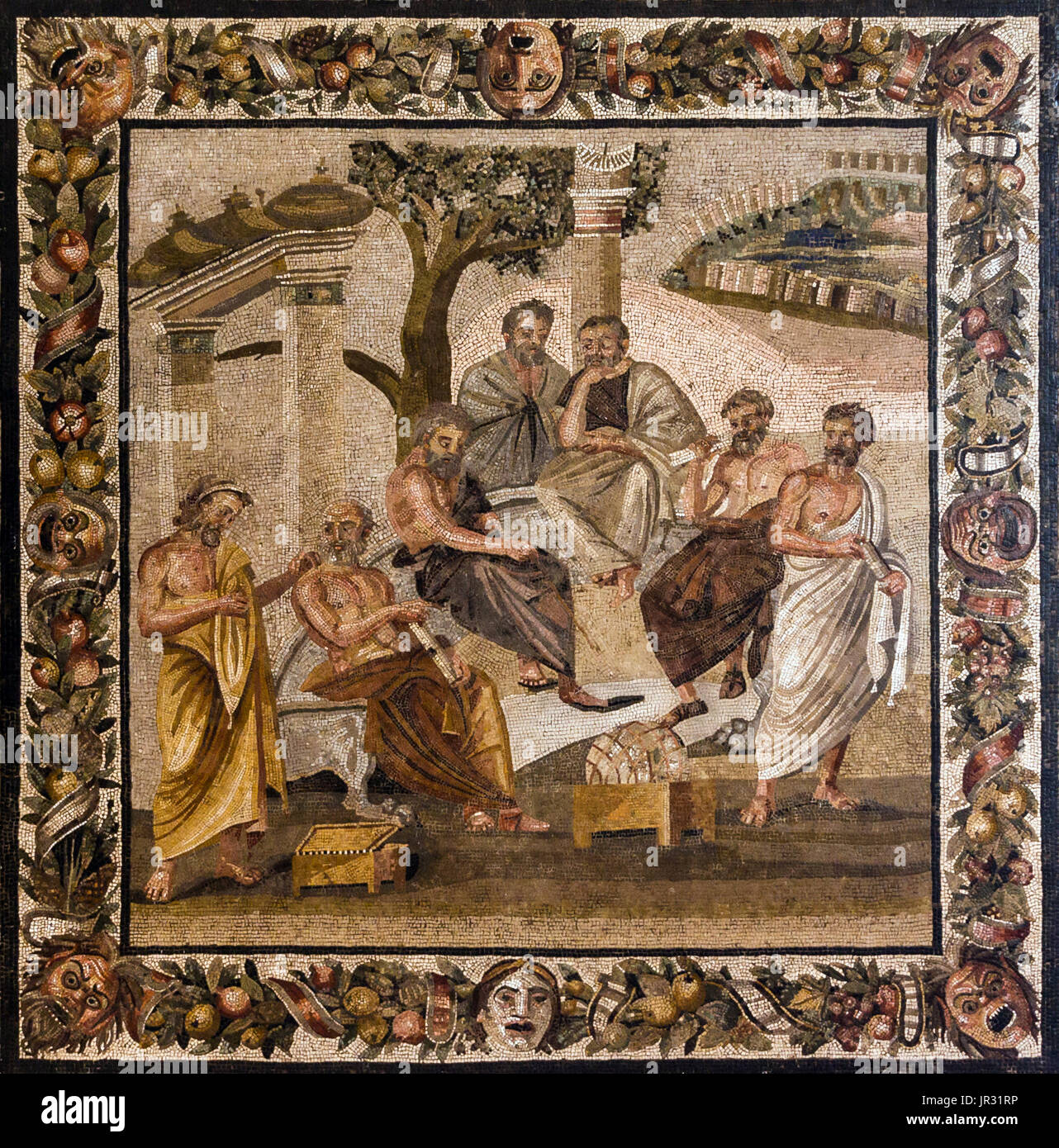 Plato's Academy mosaic was constructed in the 1st century BC, in the villa of T. Siminius Stephanus in Pompeii. The mosaic features seven men: six students and, presumably, their teacher, Plato. All the figures are deep in contemplation or discussion. The central man, most likely Plato, seems to be pointing at something with a stick. The traditional interpretations believe he is gesturing at the globe seen in the foreground. The elements surrounding the philosophers, the sacred gateway with vases, the tree and the votive column, are all typical of a mythological landscape. In the background th Stock Photohttps://www.alamy.com/image-license-details/?v=1https://www.alamy.com/platos-academy-mosaic-was-constructed-in-the-1st-century-bc-in-the-image151887338.html
Plato's Academy mosaic was constructed in the 1st century BC, in the villa of T. Siminius Stephanus in Pompeii. The mosaic features seven men: six students and, presumably, their teacher, Plato. All the figures are deep in contemplation or discussion. The central man, most likely Plato, seems to be pointing at something with a stick. The traditional interpretations believe he is gesturing at the globe seen in the foreground. The elements surrounding the philosophers, the sacred gateway with vases, the tree and the votive column, are all typical of a mythological landscape. In the background th Stock Photohttps://www.alamy.com/image-license-details/?v=1https://www.alamy.com/platos-academy-mosaic-was-constructed-in-the-1st-century-bc-in-the-image151887338.htmlRMJR31RP–Plato's Academy mosaic was constructed in the 1st century BC, in the villa of T. Siminius Stephanus in Pompeii. The mosaic features seven men: six students and, presumably, their teacher, Plato. All the figures are deep in contemplation or discussion. The central man, most likely Plato, seems to be pointing at something with a stick. The traditional interpretations believe he is gesturing at the globe seen in the foreground. The elements surrounding the philosophers, the sacred gateway with vases, the tree and the votive column, are all typical of a mythological landscape. In the background th